- Terms of Use

War News | Military History | Military News
Top 10 wwii sites to visit in germany.
- World War 2
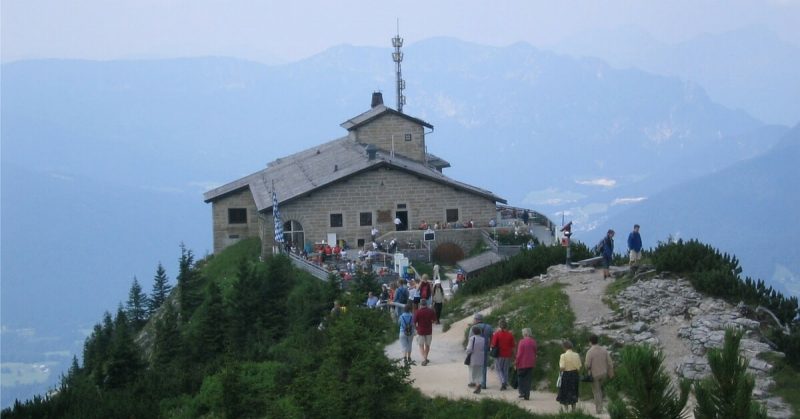
When planning to visit Germany, there are countless WWII locations from which to choose. To make planning easier for you, we have made a list of the 10 locations that we feel should be on your list.
We’ve tried to give you the full package that encompasses the entire history; from the birth of the Nazi ideology in Nuremberg and Munchen to its death in Berlin. We’ve covered everything from the development of the V-2 rockets to the Dachau concentration camp.
Party rally grounds, Nuremberg
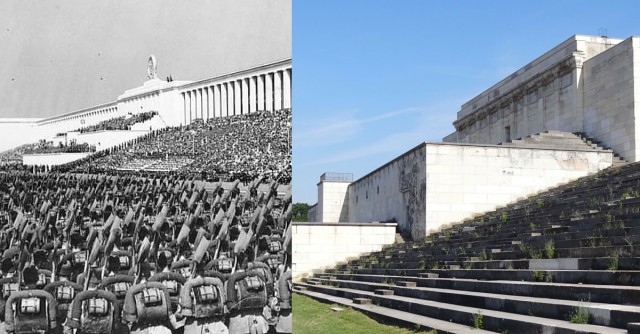
Hitler described Nuremberg as the ‘Heart of the Third Reich,’ so it makes sense that he would build the Nazis’ main rally ground around 11kms outside the city. Nuremberg is in Germany’s southwest, where Nazism grew from its modest beginnings to the party that took over the government.
The rally grounds are situated on six square miles. They include 24 towers and the balcony, known as the Zeppelin Tribune, where Hitler would stand to make speeches and address his party. In the arena, around 150,000 people could gather to salute their leader. The ground’s design was based on, but bigger than, the Colosseum in Rome.
Between 1933 and 1938 six Nazi rallies were held at the grounds. The sheer size and scale of the rallies were immense. The events were carefully planned and arranged so that they would portray an inspiring performance.
Since the end of the Second World War the German government, the Bavarian state, and the Nuremberg city authorities have all grappled with the challenge of what to do about these remaining infrastructures from the Nazi past
Visit information:
Address: Bayernstraße 110, 90478 Nürnberg, Germany Hours: 9AM–6PM Phone: +49 911 2317538
Wewelsburg Castle, Büren
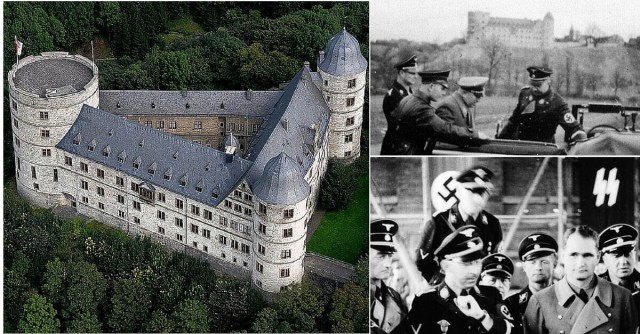
Wewelsburg Castle had served as Heinrich Himmler’s home and the SS’s headquarters throughout the Nazis’ reign in Germany. Heinrich Himmler, an ardent occult practitioner, and believer, he filled the castle with symbols that showed his fascination with the supernatural realm.
Significantly, its location is near what was then believed to be the site of the Battle of the Teutoburg Forest. Legend suggests that the castle held thousands of accused witches during the 17th century, who were tortured and executed within its walls.
Of course, no proof exists that Himmler wanted a Holy Grail castle, but the redesign of the castle by the SS referred to certain characters in the legends of the Grail: for example, one of the arranged study rooms was named Grail, and others, King Arthur, King Henry, Henry the Lion.
Address: Burgwall 19, 33142 Büren, Germany Hours: 10AM–5PM Phone: +49 2955 76220 Website: http://www.wewelsburg.de/en/
Fuhrerbunker, Berlin
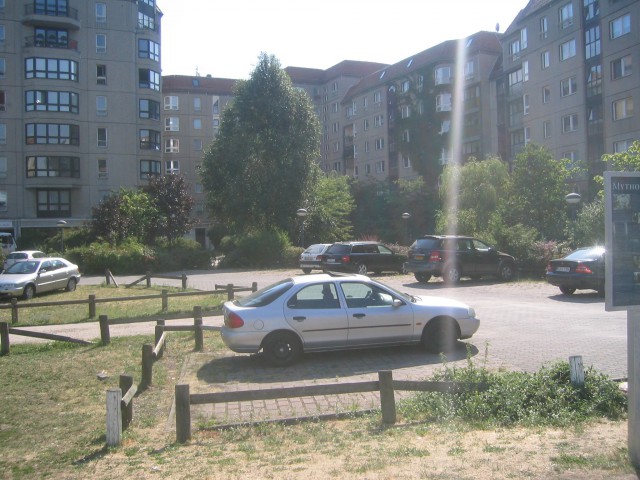
A parking lot now sits where Adolf Hitler’s Reich Chancellery once stood, in the center of Berlin. It is long gone thanks to Soviet troops liberating Berlin marking the end of World War II in Europe. But another infamous structure stood at this spot as well. There are no signs or commemorative placards of the building as many people have chosen to put the past behind them.
The present location of the infamous Fuhrerbunker, the location in which Hitler and his companion Eva Braun committed suicide is located beneath this parking lot with a sign stating the significance of the bunker under a patch of grass, of where Hitler spent his last month.
The Fuhrerbunker was originally intended as an air raid shelter, but as the war turned in favor of the allies, the shelter was extended into a much larger complex.
In 1947 the bunker’s ventilation towers were destroyed but other than that the complex was simply sealed off. Additional demolition occurred in 1959 but as the site was located close to the Berlin Wall, within the East Germany side of the Wall and was included in an area that was left mostly undeveloped and untouched.
It was not until the late 1980s that the East German administration began building on the site in an attempt to wipe out all trace of the past. Today, it is thought that there are still a few corridors to have survived but are sealed off from the public.
Address: In den Ministergärten, 10117 Berlin, Germany The Holocaust memorial is located nearby and should also be visited.
Berghof, Berchtesgaden
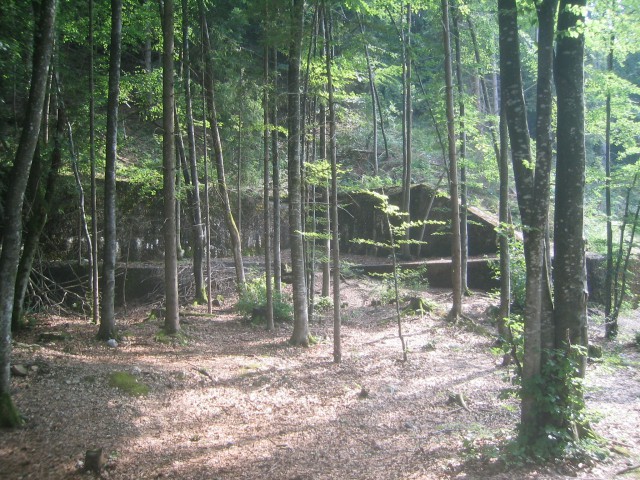
Hitler had always been attracted to the Obersaltzberg, the mountain overlooking Berchtesgaden. In the 1920s, he had rented a house there and in the 1930s he bought Haus Wachenfeld. This was rebuild into the Berghof in which he spent a large part of the war. Being close to Hitler was very important for the Nazi Party chiefs, and they moved into this area too, turning a lovely mountain into a Nazi powerhouse.
The Obersalzberg was bombed by hundreds of British Lancaster bombers on 25 April 1945, 12 days before the surrender of German forces on 7 May. At least two bombs struck the Berghof. On 4 May, four days after Hitler’s suicide in Berlin, departing SS troops set fire to the villa. Only hours later, the U.S. 3rd Infantry Division arrived at Berchtesgaden along with the French 2nd Armoured Division.
The ruined Berghof would remain in this state for seven years until it was finally blown up in 1952 the location was then used as to dump the remains of the other buildings . The garage remained standing until 1995. The ruins were further obliterated during the 1990s and early 2000s. By 2007, trees had overgrown the site and only scattered rubble, and the top of a retaining wall are still visible.
Address: Hintereck 2, 83471 Berchtesgaden, Germany
Eagles nest / Kehlsteinhaus, Berchtesgaden
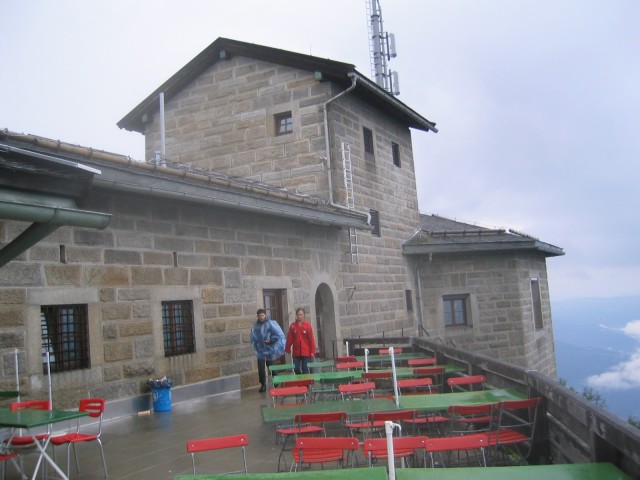
The Kehlsteinhaus or Eagles Nest as the allies called it, is situated on a ridge atop the Kehlstein mountain which towers above the town of Berchtesgaden. It was commissioned by Martin Bormann in the summer of 1937 as a 50th birthday gift for Adolf Hitler and was paid for by the Nazi Party. It was completed in just 13 months and an approach road had to be built which climbs 2,600 ft over 4.0 miles towards a car park near the top.
From a large car park, an entry tunnel leads to an ornate and previously gold-plated elevator which ascends the final 407 feet to the building. A massive red Italian marble fireplace, a gift from Benito Mussolini, dominates the building’s main reception room. It has been damaged by Allied soldiers who chipped off pieces of the marble to take home as souvenirs.
The building is now a restaurant which offers indoor dining and an outdoor beer garden. It is now a big tourist attraction with thousands of visitors ascending to the top every day admiring the same view that Hitler once enjoyed. Inside the Kehlsteinhouse are a number of information signs telling the story of how it was built and the use for the Nazi party.
Buses transport the tourists up to the parking lot, the road has been closed to private vehicles since 1952. There is also a footpath leading up, in about 3 hours you can walk up to the Eagles Nest and then enjoy a well deserved drink.
Address: Kehlsteinhaus, 83471 Berchtesgaden, Germany Open daily from May to September Website: http://www.kehlsteinhaus.de/en/
Dachau Concentration camp
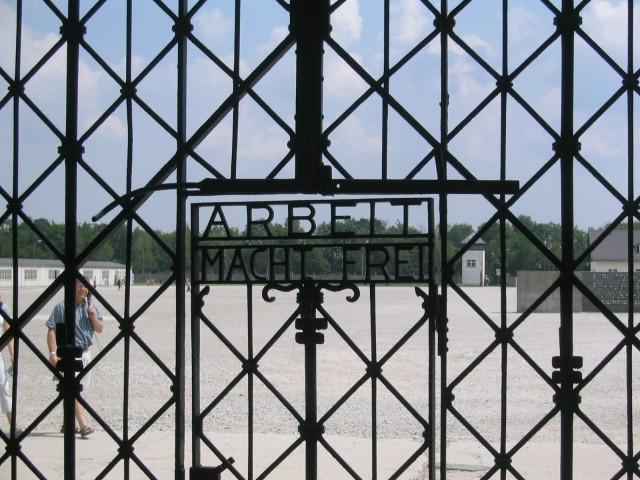
The infamous Nazi concentration camp in Dachau is found in the northeastern part of the town, and it has become an important tourist destination.
Immediately after successfully taking control of the reigns of the county in 1933, Adolf Hitler ordered to open the camp in Dachau. Dachau camp was the very first concentration camp in Europe and became a standard model for many others to follow including the infamous ‘Auschwitz.’
Over 200,000 prisoners have been locked up in Dachau from the foundation until its liberation in April 1945. 41,500 of this number died due to starvation, disease, and results of brutality.
In 1965 the Memorial Site on the grounds of the former concentration camp was established on the initiative of and in accordance with the plans of the surviving prisoners who had joined to form the Comité International de Dachau. The Bavarian state government provided financial support.
Address: Alte Römerstraße 75, 85221 Dachau, Germany Phone:+49 8131 669970 Hours: 9AM–5PM Website: https://www.kz-gedenkstaette-dachau.de/index-e.html
Peenemunde research facility
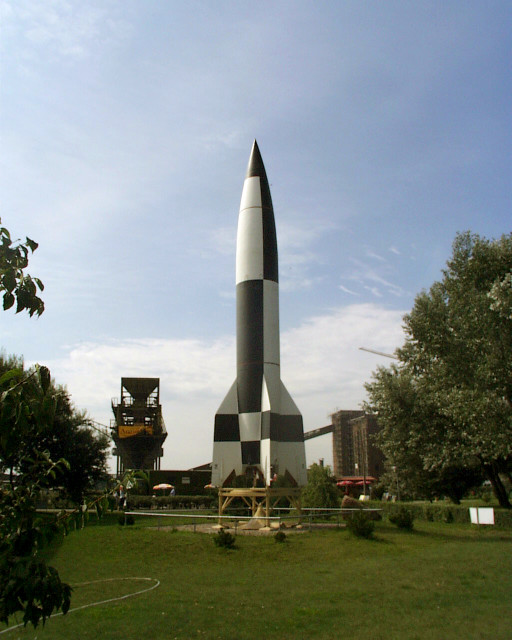
The Peenemünde Military Test Site established in 138 and it became one of the most modern technological facilities in the world. Several German guided missiles and rockets of World War II were developed and the first launch of a V-2 missile into space took place here in October 1942.
Engineers tested numerous flight objects equipped with revolutionary technology in the nearby air force testing area. The goal of the Peenemünde Military Test Site was simple and clear cut; achieve military superiority through advanced technology.
The construction of the test sites and the later serial production of the rockets was done by concentration camp inmates, prisoners of war and slave laborers. This vast pool of humans enabled the Nazis to get the V-2 into operational status is a very short period of time.
This came at a massive cost, inhumane living and labor conditions coupled with the frequent bombing of the test site by the Allies took a heavy toll, causing the death of countless humans.
The Peenemünde Historical Technical Museum is housed in the power station of the former Army Testing Site – the largest technical monument in the German state of Mecklenburg-Vorpommern. The Museum serves as an international meeting place and cultural venue. In 2002, the museum was awarded the Coventry Cross of Nails for its efforts toward reconciliation and world peace.
Historisch-Technisches Museum Peenemünde GmbH Address: Im Kraftwerk, 17449 Peenemünde, GERMANY Telephone: +49 38371 505 0 Website: http://www.peenemuende.de/en/
Hurtgenwald
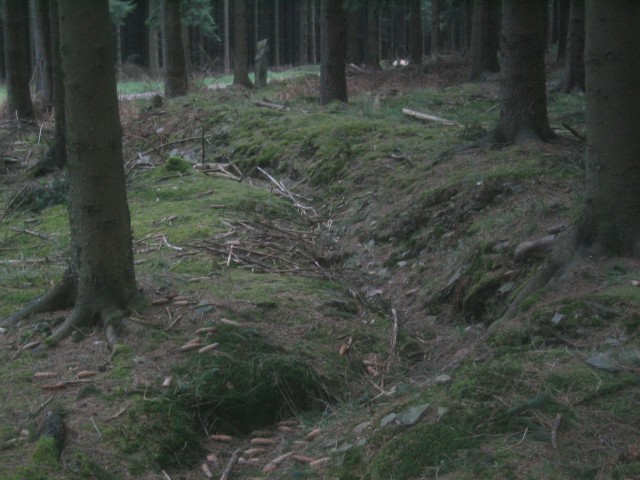
The Battle of Hürtgen Forest was the longest battle on German ground that was fought during the second world war, it lasted from 19 September 1944 to 10 February 1945. The U.S. First army tried to push through the forest and secure two Rur dams which, if opened, could sweep away an Allied bridgehead further downstream.
In 5 months of bitter fighting in the worst imaginable conditions, the U.S. First Army lost at least 33,000 killed and wounded, the German casualties were around 28,000.
Because there was no glory in the Hürtgen Forest, only death and destruction fighting an elusive and well-entrenched enemy in a damp, dark and muddy forest, the battle is largely forgotten. The Battle of the Bulge received far more media attention and ended in a glorious victory, thus it has overshadowed the Hurtgenwald ever since.
To remember the battle, the Museum of Hürtgen Forest 1944 and in Peacetime tells the story of this battle and its consequences for the local population. The museum is run by volunteers and almost all objects in the exhibition were collected in the Hürtgen Forest area after the war.
Nearby in the forest monuments, trenches, and demolished bunker can be visited.
Visit Information:
Address: Pfarrer-Dickmann-Str. 21-23, 52393 Hürtgenwald-Vossenack, Germany Hours: Sundays 11.00-17.00 (March-November) Phone: +492429 90 26 13 Website: http://www.museum-huertgenwald.de/
Königplatz, Munich
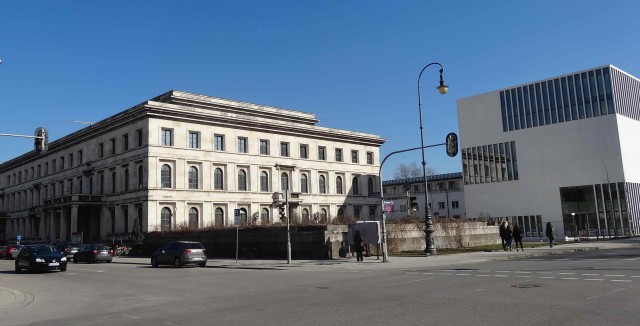
In the heart of Munchen lies a large square called the Königplatz, during the Third Reich it formed the administrative heart of the Nazi Party and mass rallies were held here. Located just off the Königplatz was the Brown House, where the National headquarters of the Nazi Party was located.
On the east side of the Königplatz the Nazis erected two Honor Temples in which they “enshrined” the remains of the sixteen Nazis that were killed in the 1923 Beer Hall Putsch. In 1947, the U.S Army demolished both temples and removed those buried there, but their platforms remain to this day.
Next to the temples, two buildings of the Nazi party constructed by Paul Troost still exist. In the Führerbau, visible on the photo above, the Munich Agreement was signed in 1938 and is now a school for music and theater.
On 1 May 2015, on the former location of the Braun Hause, the new Munich Documentation Centre for the History of National Socialism opened. It is as a place of education and remembrance documenting and addressing the crimes of the Nazi dictatorship and their origins, manifestations, and consequences right up to the present day.
Address: Königplatz, Munich, Germany Hours: Tuesday to Sunday 10 am – 7 pm Website: http://www.ns-dokuzentrum-muenchen.de/1/home/
Feldhernhalle, Munich
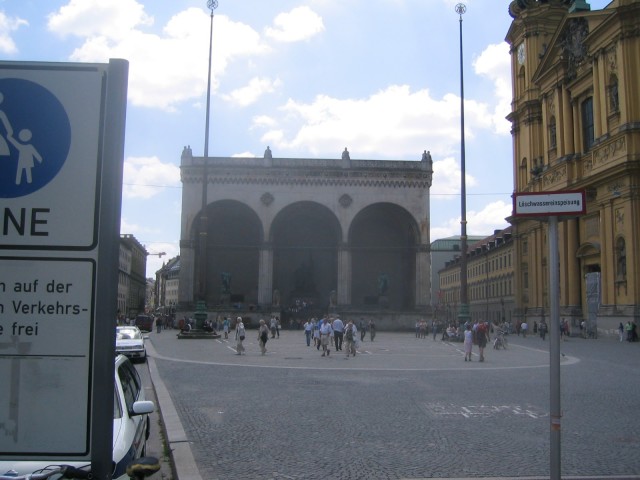
Close to the Königplatz, on the Odeonsplatz in Munich, the Feldherrnhalle is located. In 1841 it was commissioned by King Ludwig I of Bavaria to honor the tradition of his army.
It was at the Feldherrnhalle, or Field Marshals Halls, that on the morning of November 9th, 1923, Adolf Hitler’s “Beer Hall Putsch” came to a bloody end.
The Bavarian State Police halted the illegally organized march by the followers of Adolf Hitler here, which was the last desperate attempt to take over the Bavarian State.
The Nazi’s participation in the march were order to stop but continued so the State Police felt threatened and opened fire. Sixteen marchers and four policemen were killed in the ensuing gun battle.
Those that were killed were later moved to the honor temples on the Königplatz.
This meant the end of the Putsch and Hitler after which he was arrested and sentenced to a prison term in Landsberg prison.
When Hilter took over power in 1933 the Feldherrnhalle was turned into a memorial to the martyrs of the putsch. A monument, called the Mahnmal der Bewegung, was designed by Paul Ludwig Troost and placed opposite the location of the shootings. It listed all the names of the fallen SA men, which had been turned into Martyrs.
The SS had a ceremonial guard at the monument at all time and started using the Odeonsplatz for SS parades and commemorative rallies. During some of these rallies, the sixteen dead SA men were each commemorated by a temporary pillar placed in the Feldherrnhalle topped by a flame. New SS recruits took their oath of loyalty to Hitler in front of the memorial.
On 3 June 1945, local people spontaneously destroyed the Mahnmal der Bewegung, and the Feldherrnhalle was later restored to its pre-Nazi appearance.
Address: Odeonsplatz, Munchen, Germany

Get our Rail Planner app
Plan your trip, get extra discounts, and show your Pass as you go.

Our favorite spring routes
Celebrate spring with these 7 off-the-beaten-path train routes

All about seat reservations
Everything you need to know about booking your seats

Alternatives to Busy Routes
Travel between popular European cities without seat reservations

Through our Chatbot in the bottom right corner.

Ask the Community
Browse questions from fellow Eurail travellers, or ask your own!
- Plan your trip
- Suggested Itineraries
10 days in Europe: the World War II sites
- Order overview
- Reservations overview
- My Trips & Travelers
- {{translatedTraveler}} {{#promotional}} {{currencySign}} {{standardPrice}} {{/promotional}} {{quantity}}x {{currencySign}} {{finalPrice}}
- Child {{childPasses}}x FREE
- {{translatedPassType}}
- {{translatedValidityPeriodDescription}}
- {{translatedClass}}
- Remove Pass(es)
- {{variant.localizedTravelPackDescription}} {{quantity}}x Free
- {{variant.localizedPassUpgradeDescription}} {{quantity}}x {{currency}} {{price}}
- Your order will arrive by {{expectedDeliveryDate}} 1 x {{currency}} {{price}}
Your cart is empty
Discover the European sites of World War II with this 10-day itinerary. Follow in the footsteps of the Allied forces, from the beaches of D-Day to the heart of Berlin, and into Poland to witness the destructiveness of the Nazi regime.
Itinerary highlights
Visit World War II sites of great historic significance: the beaches of Normandy, the Anne Frank house, and the dreaded Auschwitz extermination camp.
Normandy, France
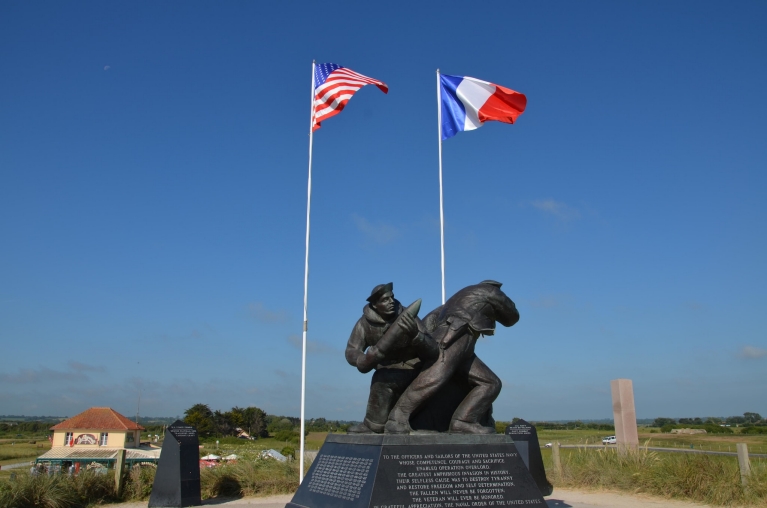
Operation Overlord: Start of the Allied invasion
On June 6 th 1944 (known as D-day), the Allied Forces launched a full scale assault on the beaches of Normandy.
Visit the impressive Utah Beach museum , built on the exact spot where the first American troops landed.
Check out the Airborne museum in Sainte-Mère-Église , the French village that was the first to be liberated by paratroopers.
Ardennes, Belgium
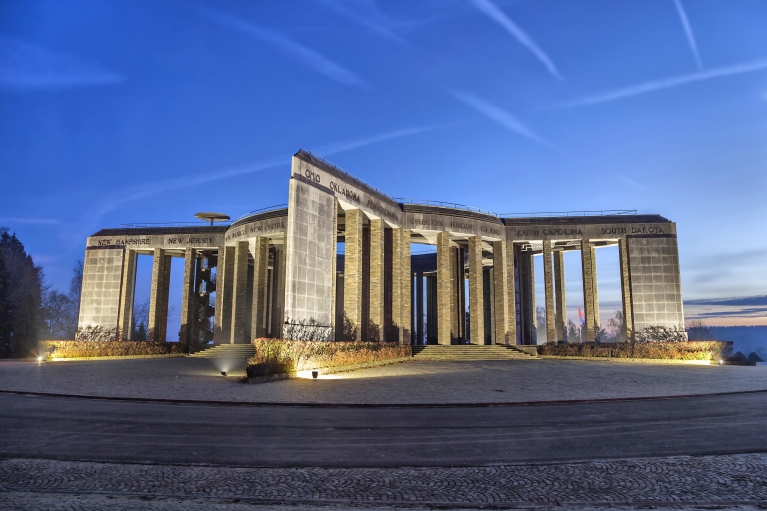
Battle of the Bulge: A cold counter offensive
On December 16 th 1944, the Nazis started their last great offensive in the Ardennes region in Belgium.
Check out the Mardasson Memorial in Bastogne , dedicated to the American troops who liberated the city.
Learn all about the Battle of the Bulge in the Bastogne War Museum.
Arnhem, the Netherlands
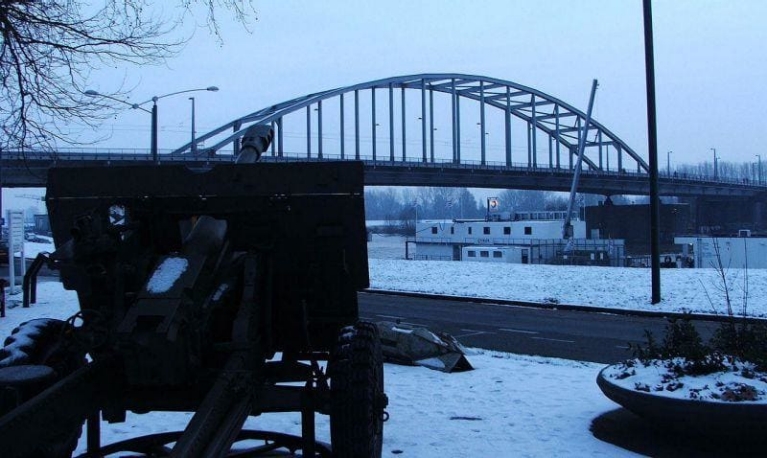
Operation Market Garden: A bridge too far
On September 17 th 1944, the Allies attempted to cross the Rhine, but failed to take the last bridge in Arnhem.
Follow the Liberation route to see the John Frost bridge and other battle sites in and around Arnhem.
Take a 1 hour trip to Amsterdam to visit the famous Anne Frank House and the Resistance Museum .
Berlin, Germany
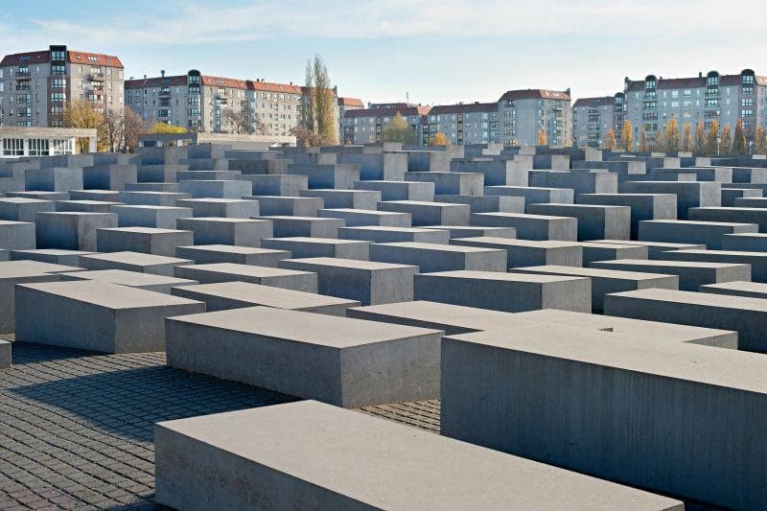
The Battle of Berlin: Road to victory in Europe
On May 7 th 1945, World War II ended in Europe with the unconditional surrender of Nazi Germany.
Visit the Humboldthain Flak Tower , the last remaining anti-aircraft tower that was built to defend Berlin.
Walk through the blocks of the impressive Holocaust Memorial and take a trip to Sachsenhausen concentration camp.
Warsaw, Poland
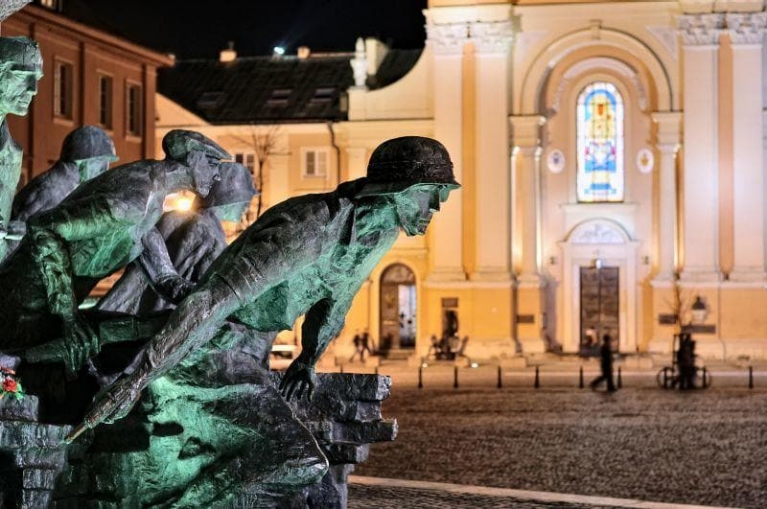
Operation Tempest: The tragic fate of Warsaw
On August 1 st 1944, the Warsaw Uprising started. It would end with the near-obliteration of the city.
Visit the Warsaw Uprising Museum to learn more about the dramatic events that took place here.
Walk through the remains of the Warsaw Ghetto , which was burned down after the Jewish revolt of 1943.
Krakow, Poland
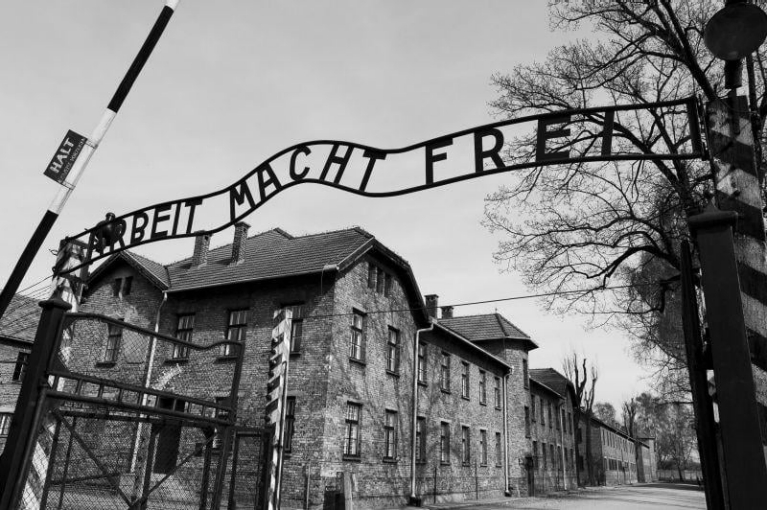
The Holocaust: The Nazis' final solution
On January 27 th 1945, Russian troops liberated Auschwitz, where over 1.1 million people were killed.
Take half a day to explore Auschwitz and learn about one of the darkest pages in history.
In Krakow, visit the factory of Oskar Schindler , who managed to save the lives of over 1,000 Jewish workers.
Which pass should I get?
The ideal rail pass for this trip is the Eurail Global Pass . With this Pass you can travel all over Europe, in no less than 33 countries.
Change of currency
You cannot change the currency once you have a Pass in your cart. Remove the Pass, and then change the currency on the website header.
- All Destinations
- United States
- European Theater
- Pacific Theater
- The Home Front
- The Holocaust
- Pearl Harbor
- WWII Events
- Wings, Wheels, & Weapons
- General WWII Travel Topics
- Work With Me
- Skip to main content
DESTINATION: WWII
A World War II Travel Blog

Welcome to Destination: WWII – Your online resource for visiting World War II battlefields, museums, monuments, and memorials around the world.
Latest Posts
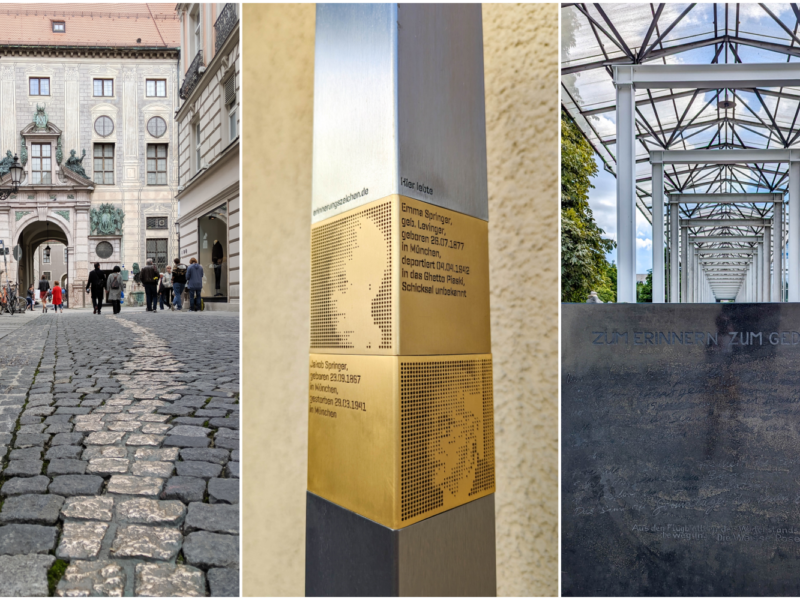
Munich WWII Sites: 26 Eye-Opening Spots You Need To Know About
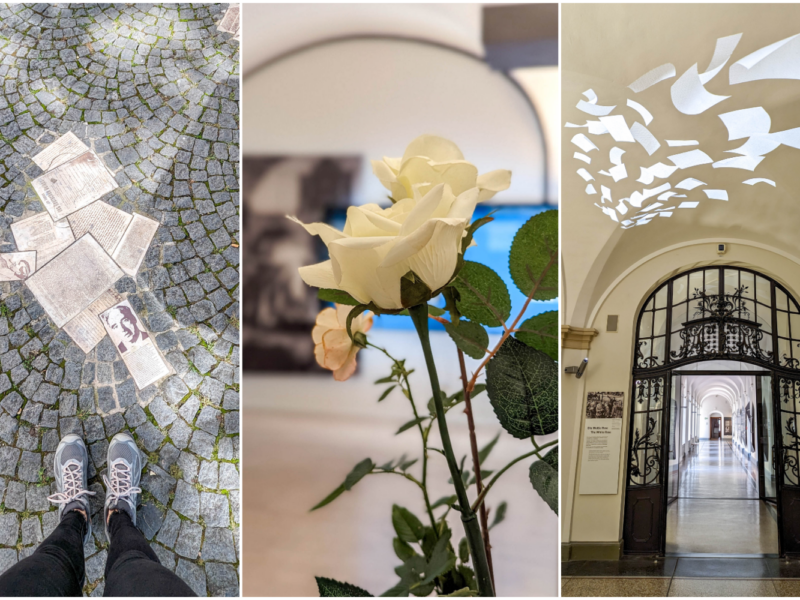
Munich’s White Rose Movement: 13+ Great Museums & Memorials to Visit in Germany
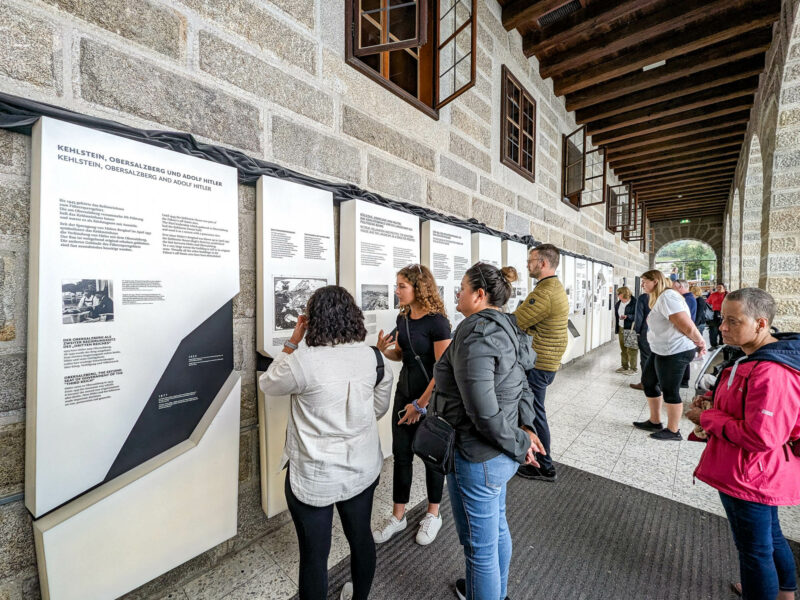
The Truth About Visiting Hitler’s Eagle’s Nest: What You Need to Know Before You Go
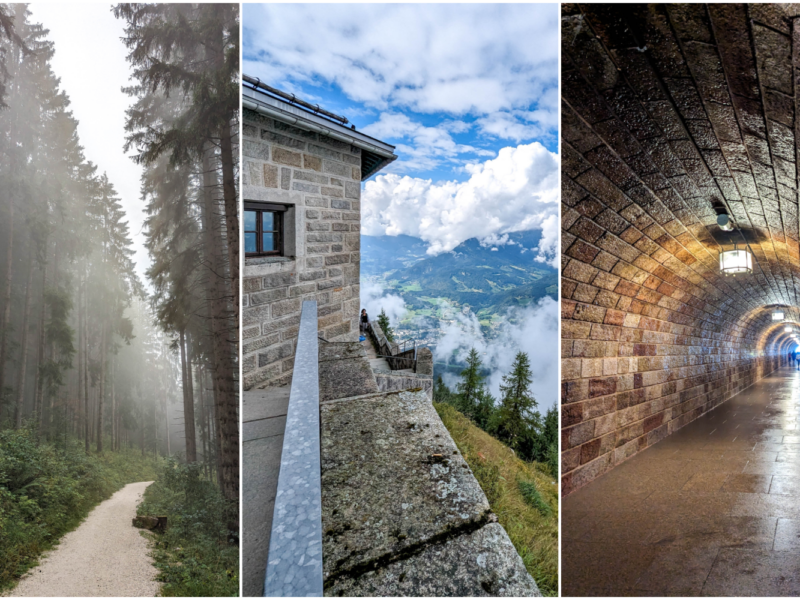
Hike to the Eagle’s Nest: 11 Reasons to Skip the Bus in Berchtesgaden
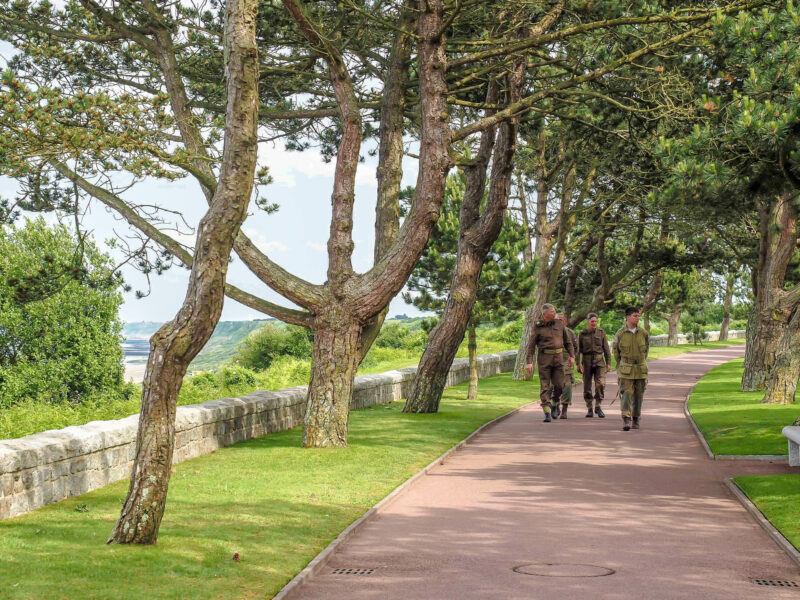
The 10 Best Local D-Day Tours in Normandy for 2024: Beaches, Battlefields, & Beyond

10 Things You Need to Know Before Visiting Normandy’s D-Day Sites
Click Here for More

Meet Your Guide
Hi, I’m Ashley! I’m a full-time travel writer, tour guide, and World War II historian based in Boston, MA who’s traveled to 32 countries on 5 continents. I formed Destination: WWII from a desire to encourage and help travelers visit WWII sites around the world.
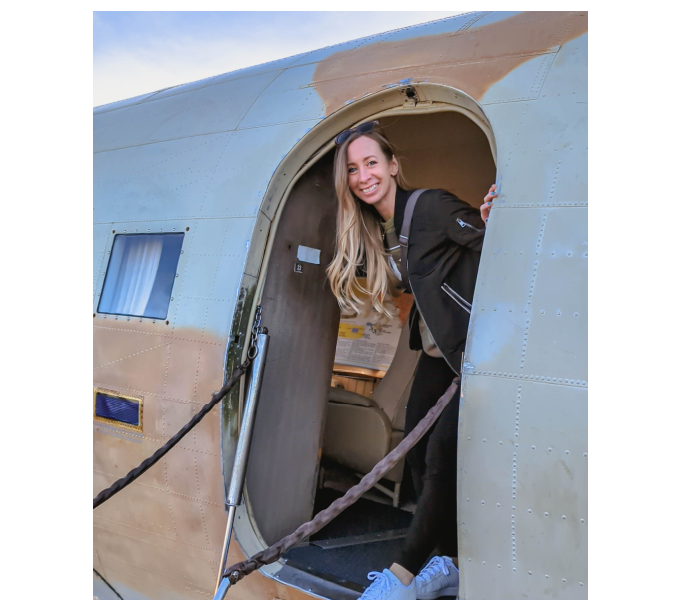
Explore These Categories
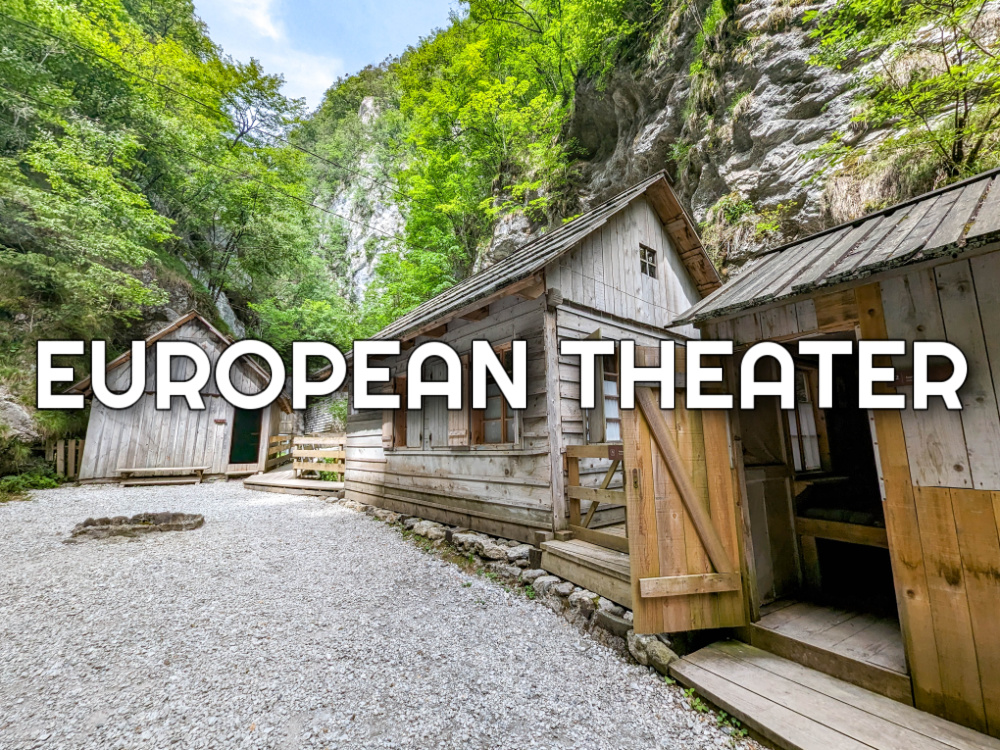
Most Popular Posts
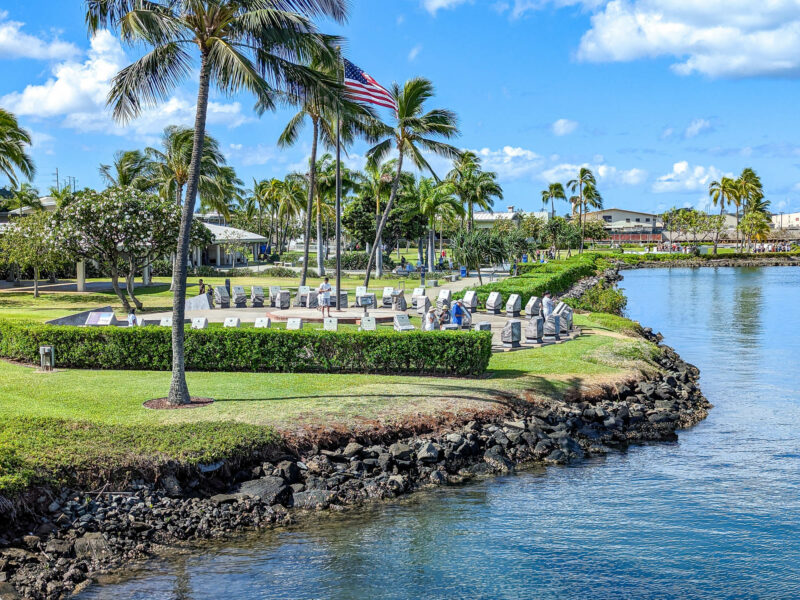
Visiting Pearl Harbor: 22 Things You Need to Know First + Helpful Tips
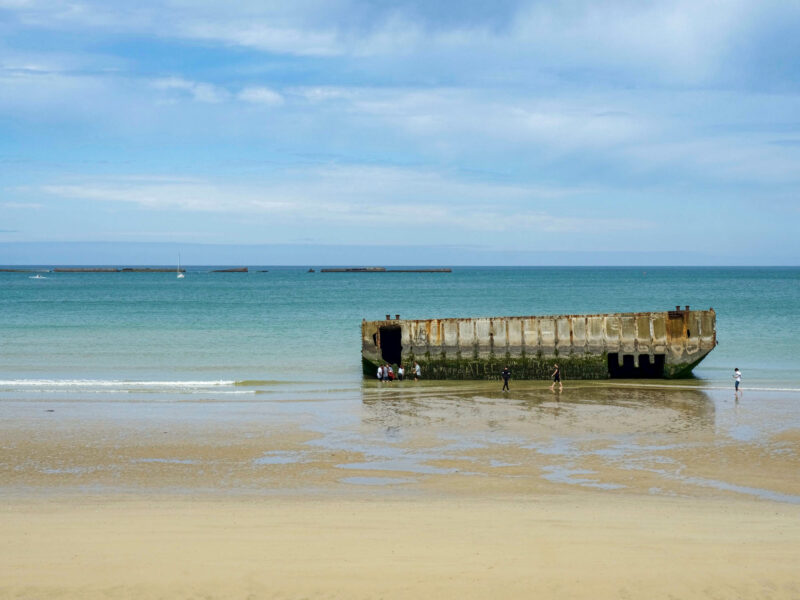
The 8 Best Normandy Tours from Paris in 2024: D-Day in a Day

Terezín Concentration Camp from Prague: How to Get There & What to See

WWII Sites in Rome, Italy: 8 Museums, Memorials & More To Visit Today

7 of the Best D-Day Sites to Visit in Normandy If You Have Just 1 Day
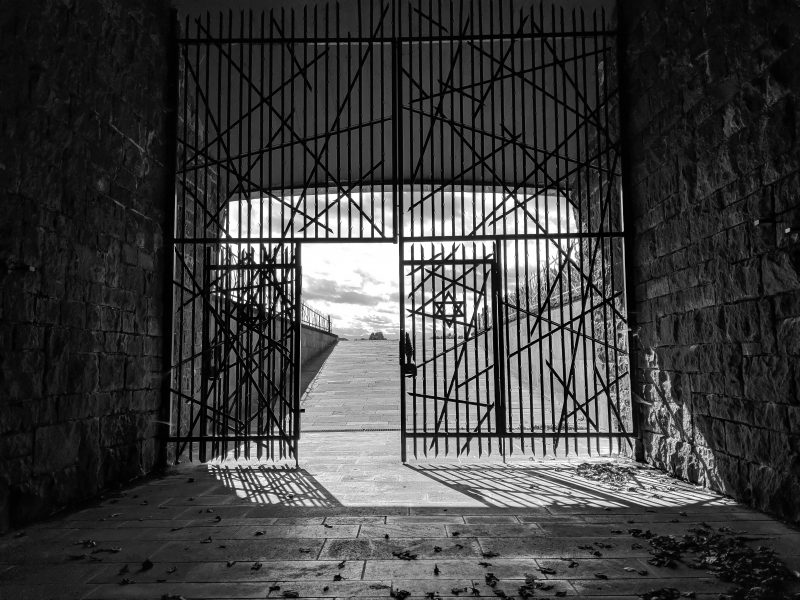
Complete Guide to Visiting Dachau Concentration Camp Outside Munich
Subscribe to dwwii.

Paris WWII Sites Map
Advertisement
10 Significant World War II Sites to Visit in Germany
- Share Content on Facebook
- Share Content via Email
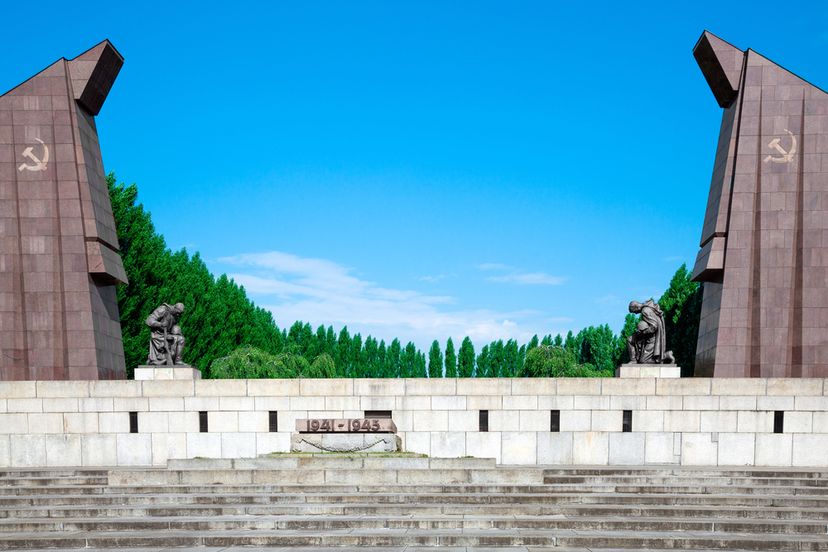
If you’re a World War II aficionado or history buff in general, there’s no other trip quite like seeing the sights left behind by the Third Reich and Nazi Germany. Some were bombed into obsolescence, others were destroyed to cover over the reminder of the atrocities of war, but many significant spots remain accessible to the public today. Here are 10 historically significant WWII sites to see in Germany:
1. Vorbunker/Führerbunker -Berlin
Vorbunker and Führerbunker were once the places where Adolf Hitler took shelter and eventually lived. The elaborate underground concrete bunker complex was designed to be a temporary air-raid shelter for Hitler, his family and his guards. While the site has been redeveloped into the current residential housing that stands today, this remains an important place of WWII significance as it was in the Führerbunker that Hitler committed suicide. Today a commemorative sign can be seen explaining the layout and significance of the bunker complex.
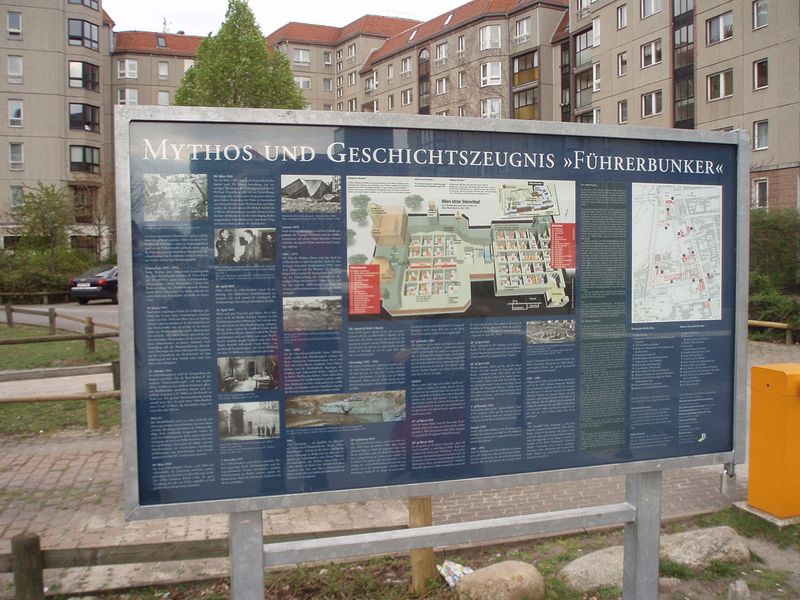
2. Dachau Memorial and Museum -Dachau
Dachau was the first of many Nazi concentration camps opened in Germany and was designed to hold political prisoners from Germany and Austria as well as Jewish prisoners. It was also open the longest, from March 1933 to April 1945 spanning nearly all 12 years of the Nazi regime. Today the site of the former concentration camp is home to a memorial as well as a museum and can be visited by the public.
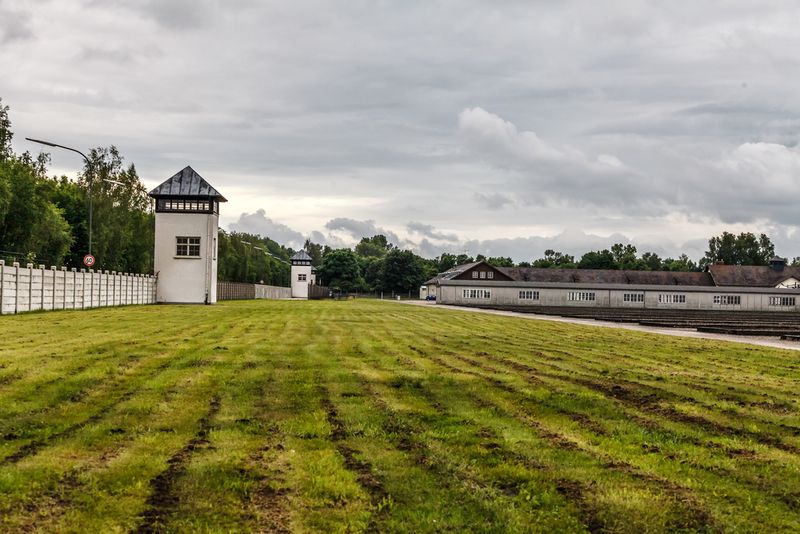
3. Nazi Party Rally Grounds -Nuremberg
The rally grounds of the Nazi party covered about 11 square kilometers in Nuremberg’s southeast and were the site of six Nazi rallies between 1933-1938. While not all of the historic buildings remain, many are preserved and can be visited by the public as the entire site is now a memorial.
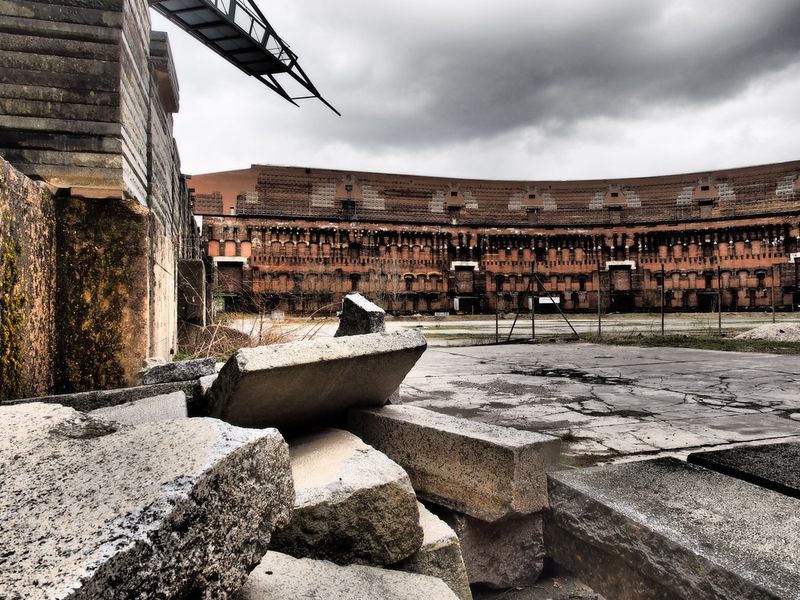
4. Holocaust Memorial -Berlin
This 4.7 acre site in Berlin was designed by architect Peter Eisenman and engineer Buro Happold and serves as a tribute to Jewish victims of the Holocaust. The site is covered with 2,711 concrete slabs known as ‘stelae’ and includes a Place of Information on the site’s eastern edge which lists the names of all known Jewish Holocaust victims.
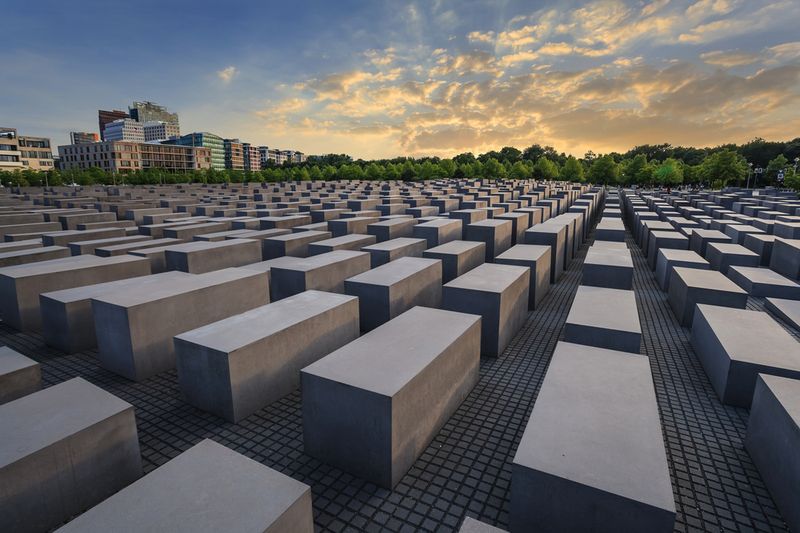
5. St. Nicholas’ Church -Hamburg
This Gothic Revival church was once the tallest building in the world from 1874-1876 and played an important role in WWII. During the extensive air raids on the city of Hamburg, the church tower served as a goal and visual orientation marker for the Allied Air Forces. Unfortunately, on July 28, 1943 the church was severely damaged by bombing and was reduced to the only remaining tower which can still be seen today.
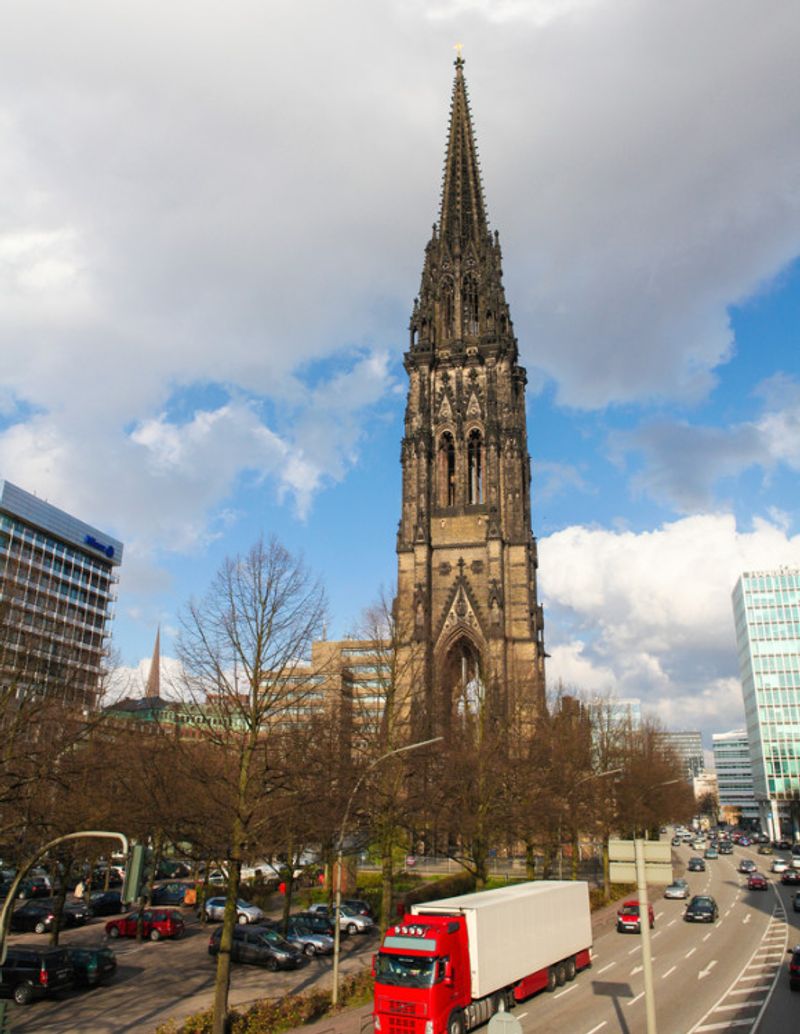
6. Kehlsteinhaus (Eagle’s Nest) – Obersalzberg
The Kehlsteinhaus or ‘Eagle’s Nest’ as it’s known in English speaking countries is a Third Reich-area complex that was given to Adolf Hitler for his 50th birthday as a retreat to entertain friends and guests. The Kehlsteinhaus sits on a rocky outcrop known as Obersalzberg near the town of Berchtesgaden. Today the Eagle’s Next can still be visited by the public as it houses a restaurant, beer garden and tourist site.
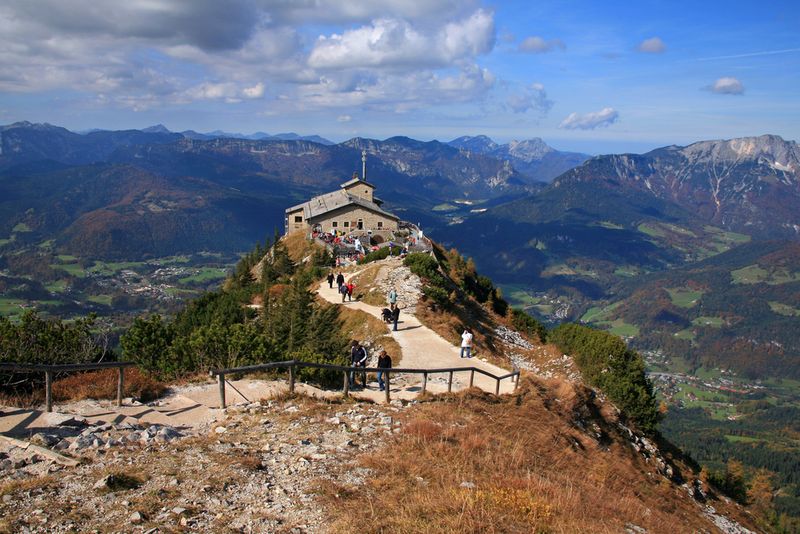
7. Colditz Castle -Colditz
Colditz is a Renaissance castle located in Germany’s Saxony state. During WWII the castle was converted and used as a high security prisoner-of-war camp for officers who were particularly dangerous or were regarded as escape risks. The German’s believed the castle’s location on a rocky outcrop above the River Mulde made it an excellent spot for a high security prison, however Colditz POW camp had one of the highest records of successful escape attempts during WWII.

8. Mittelbau-Dora Memorial -Nordhausen
Mittelbau-Dora was a WWII Nazi concentration camp located near Nordhausen in the German state of Thuringia. This camp was notorious for its extreme cruelty towards prisoners and roughly 1 in 3 of the 60,000 prisoners sent here did not survive. Today the site is home to a memorial and history museum and serves as a place of mourning and commemoration of the victims of this concentration camp.
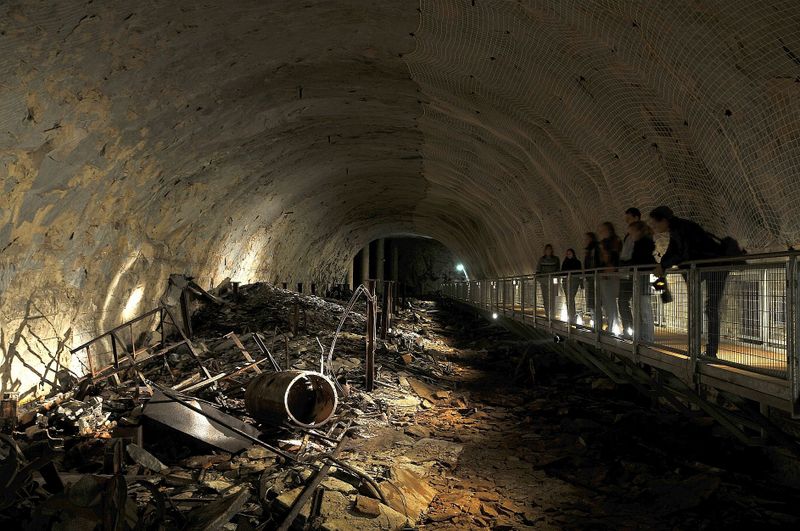
Photo by: Buchewald and Mittelbau-Dora Memorials Foundation
9. Soviet War Memorial -Berlin
The Soviet War Memorial is located in Berlin’s Treptower Park and was build to commemorate the Soviet soldiers who fell during the Battle of Berlin in 1945. The main feature of the memorial is a 12-m tall statue of a Soviet soldier with a sword holding a German child, standing over a broken swastika. The central area before the monument is lined with 16 stone sarcophagi, one for each of the 16 Soviet Republics. Each of the sarcophagi are adorned with carvings of military scenes and quotations from Joseph Stalin in both Russian and German languages.
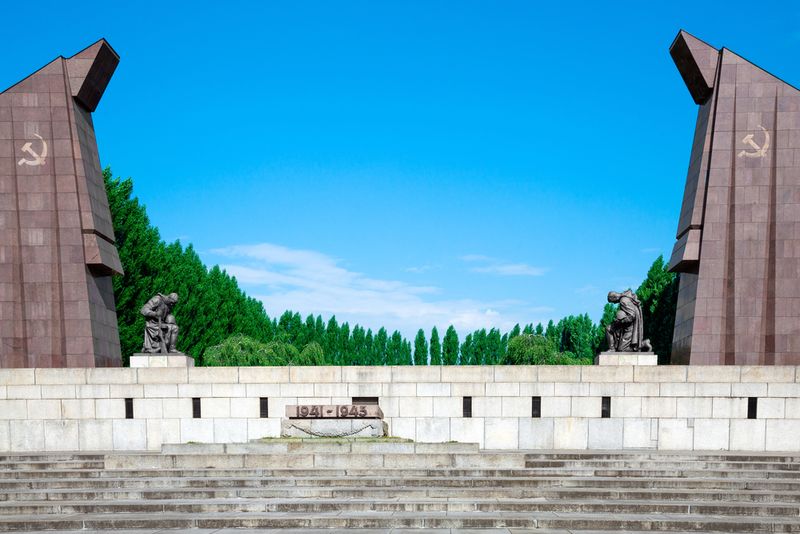
10. Besseringen B-Werk -Merzig
The Besseringen B-Werk is the only completely preserved fortification bunker located in the Siegfried Line; a 630 kilometer defensive system built between 19 and featured more than 18,000 bunkers, tunnels and tank traps. 32 bunkers in the Seigfried Line were built to construction standards or thickness ‘B’ hence the term B-Werk. Post-war, the site was used as a rubbish dump but it was restored and opened in 2005 as a museum which can be visited by the public today.
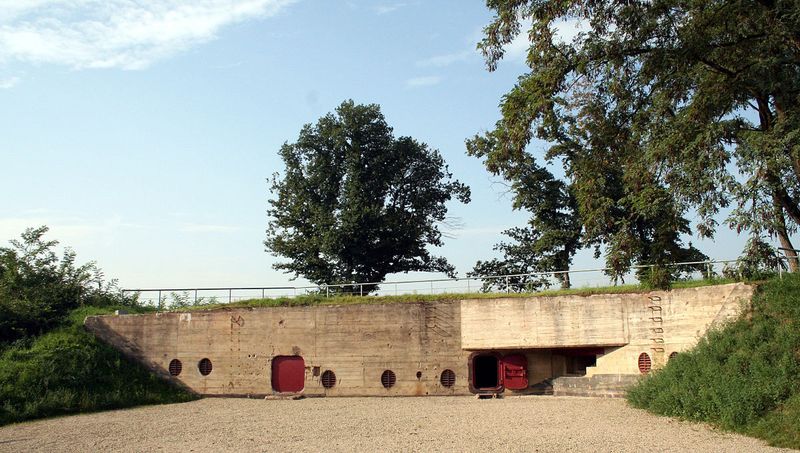
Like this? Check out 15 Must See World War II Sites in Europe
Please copy/paste the following text to properly cite this HowStuffWorks.com article:
- Outdoor Activities
- Destinations
- Book Hotels, Flights & Cars
- Advertise With Us
- Cookie Settings
Copyright © 2024 MapQuest Holdings LLC, a System1 Company
Change location
- UK / International
- Call toll-free tomorrow from 10am EDT
- 617-223-4521 617-223-4390 or
- REQUEST A QUOTE
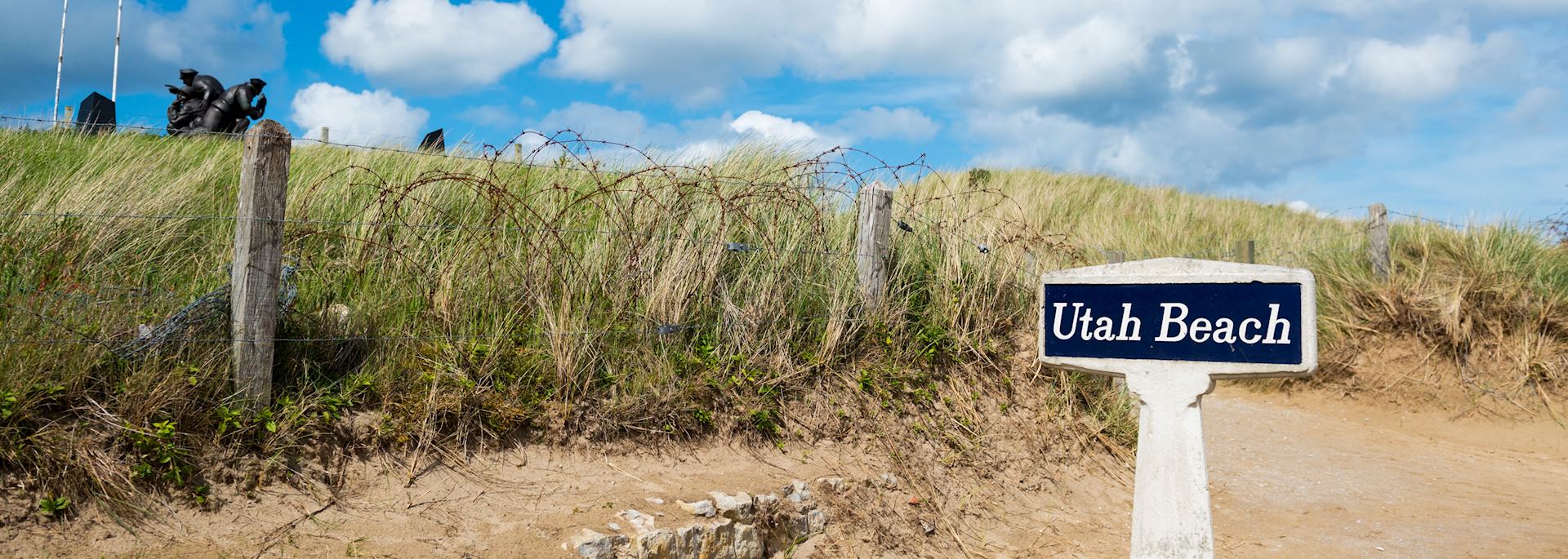
The best World War II sites in Western Europe
In London, shrapnel damage still pocks the walls of the Victoria & Albert Museum, and in Normandy, whole fields remain scalloped by craters from the D-Day invasion. In ways large and small, World War II has left its mark on the people, countries and landscapes of Western Europe.
Whether you want to add a few war-related sites to your trip or plan an entire itinerary based around military history, we’ve created a guide to some of Western Europe’s most impressive World War II sites for you. In addition to blockbuster sites like Churchill’s War Rooms and the Normandy beaches, we’ve also included smaller, lesser-known options like the Bourbon Tunnels in Naples.
Submarines and secrets in Liverpool, UK
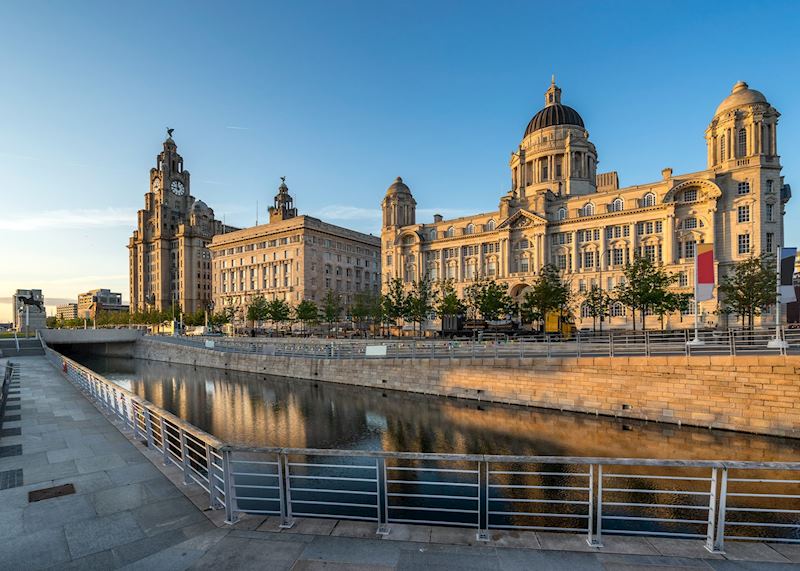
Though it’s best known for its musical history, Liverpool played an essential role in the war’s naval areas. The island nation was dependent upon convoys bringing in supplies from the Atlantic and those ships were protected by the massive, complex operation at the Western Approaches.
Left almost exactly as they were when the office closed in August 1945, the museum’s Map Room includes a huge world map, marked in white gridlines. Here, personnel plotted out the movement of ships like a huge, high-stakes game of Battleship, with real lives at risk. A visit here gives you a glimpse into the beating bureaucratic heart of the Allied operations during the Battle of the Atlantic.
This HQ played a complicated game of hide and seek with the many U-boats that prowled the Atlantic, hunting convoys in so called ‘wolf packs’. At the U-Boat Experience, located across the River Mersey from the museum, you can also look inside U-534, one of just four surviving German submarines that’s been preserved. Its rust-streaked exterior hints at the cramped, grim conditions that sailors on both sides had to contend with.
Churchill’s War Rooms and the Imperial War Museum, London
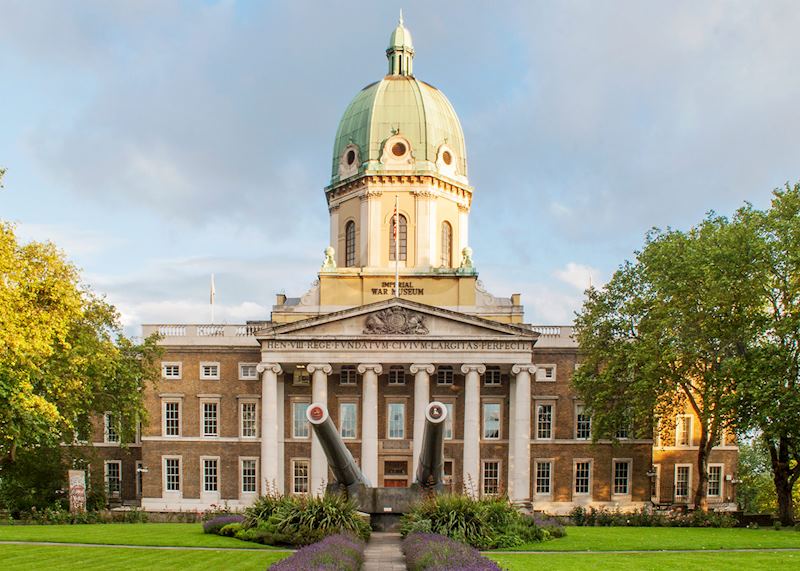
Even in a teeming metropolis like London, you can still see the scars of the war. On the Victoria & Albert Museum, for example, shrapnel from the Blitz took big bites out of the stone walls — the marks are carefully preserved and annotated with a plaque.
But the inarguable highlight of any World War II-themed trip to London is Churchill’s War Rooms. Technically part of the Imperial War Museum, it carefully preserves the underground complex that housed British command during the war, including those deadly months during the Blitz.
These spartan, joyless rooms, left as they were at the war’s end, might seem familiar because they’ve been reproduced endlessly in movies and television, down to the gleaming black Bakelite phone that Churchill used. However, a private guide can provide a fresh perspective on the headquarters.
Look for the special ‘noiseless’ typewriters that Churchill had imported from the States because he preferred a quiet working environment. You can also see a weather indicator sign, intended to convey the conditions upstairs to the isolated workers toiling away in the bunker. During particularly heavy bombing days, George Rance (an official of the Office of Works) would set it to ‘windy’.
Churchill located his command facility near Saint James Park, close to 10 Downing St, but the main bulk of the Imperial War Museum is located on the other side of the river. Set in what was once Bedlam Hospital, the museum focuses on 20th-century conflicts and the British and Commonwealth troops who fought and died in them.
The World War II exhibits here are comprehensive and often harrowing. You’ll see a German V2 Rocket and a gleaming silver Spitfire that survived the Battle of Britain, its sleek silhouette easy to pick out among the sharp angles of the atrium’s ceiling.
The museum goes well beyond the basic weapons, delving deep into the human cost of the war. One exhibit follows a real family throughout the duration of the war, and another looks at the strange-but-true aspects of espionage and counterintelligence. Perhaps the most gut-wrenching is the Holocaust exhibition, which documents the atrocities of the genocide through photos, film and objects.
Castle, cliffs and tunnels in Dover, UK
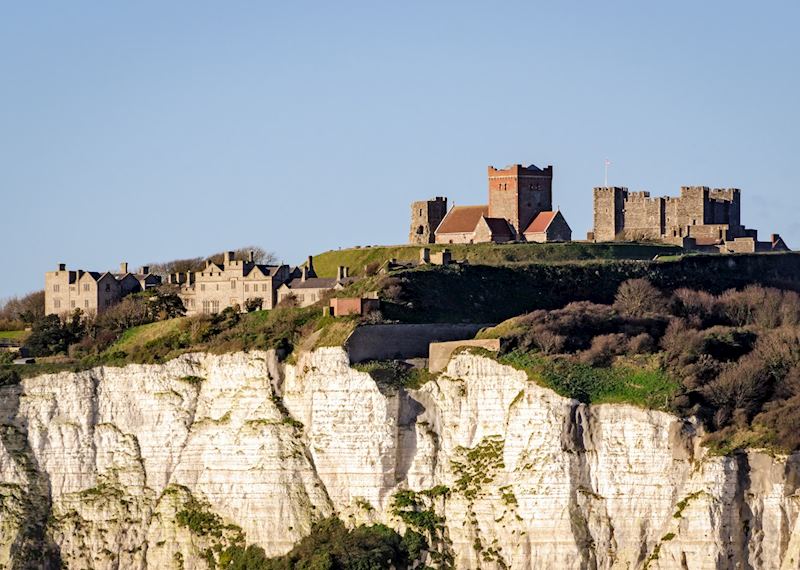
Imposing Dover Castle stands sentinel over the white cliffs that mark the narrowest point in the English Channel. Parts of this square-shouldered fortress date to the 12th century, though there have been fortifications here since the Romans.
Underneath the castle complex, carved out of the soft chalk, you’ll find a network of no-longer secret tunnels that were first created during the Napoleonic Wars. They were converted into an air raid shelter in 1939 and expanded the next year to include a secure underground hospital and Combined Operations Headquarters. Churchill himself stood on a balcony, overlooking the strait, during the Battle of Britain.
The tunnels can seem tight and very dark, the gloom barely pierced by the period-accurate lighting and, in a few places, some parsimonious windows. A tour focuses on Operation Dynamo, the rescue operation to save the soldiers stranded at Dunkirk. With immersive sound effects, projectors throwing light, and the appearance of flames on the tunnel walls, it’s a compelling tour that can be overwhelming for some.
The beaches at Normandy
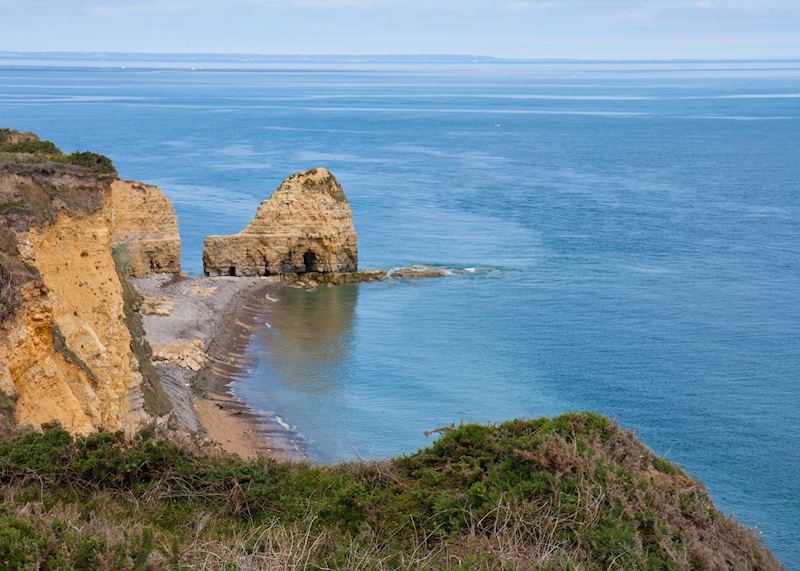
Even though the landings at Normandy have been depicted in films, it’s very different to see it in person. Standing there, on the wide golden sands at Omaha or looking down at the sheer cliffs of Pointe-du-Hoc, can give you a visceral understanding of the odds the Allied forces faced during this pivotal battle.
Plan for at least three days to see everything associated with the war, including the museums, the cemeteries, the artificial ports and the American, British and Canadian landing sites.
A private driver-guide is imperative in Normandy. The narrow roads are confusing, so simply navigating the area is a challenge without one. What’s more, a guide can put what you’re seeing into context, offering small details that don’t come from a guidebook or museum. Many of our guides are local to the area and can speak about their parents’ or grandparents’ personal wartime stories.
Paris, home of the French Resistance
The war is everywhere and nowhere in Paris . After the occupation, Parisians worked hard to erase the remnants of the war from their capital city, so you won’t find many scars from bombing or other obvious signs. However, in a city of 130 museums and countless monuments, you’ll find several dedicated to different facets of World War II.
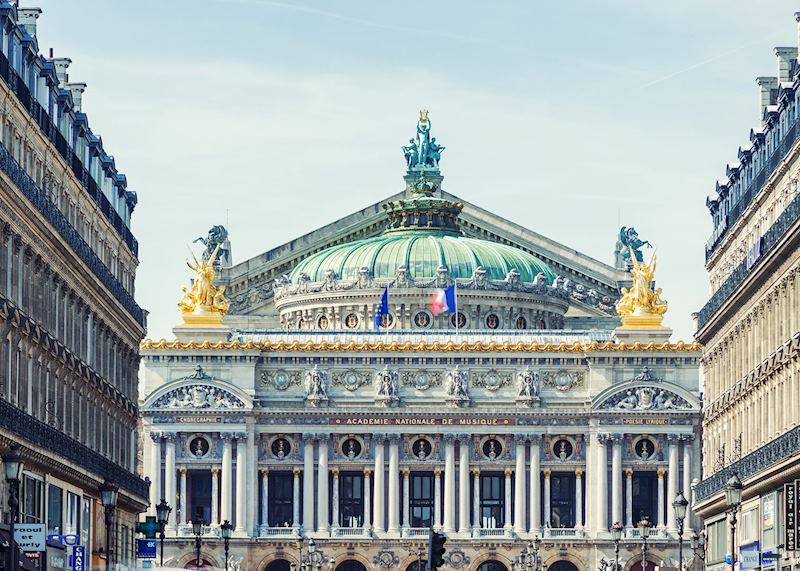
Musée de l’Armée at Les Invalides examines all of France’s military conflicts with a large, permanent exhibit dedicated to World War II. The sheer size and scope of the museum can be overwhelming, so we suggest a private guide to help you navigate the collection and put the exhibit into context, drawing out details that even those familiar with the history may not know.
Located mostly underground, on the site of a former morgue behind Notre Dame, the Mémorial des Martyrs de la Déportation commemorates the 200,000 French citizens who were deported to concentration camps. For a museum focused specifically on the Jewish experience in France during the war, Mémorial de la Shoah is located in Le Marais, an area that had a large Jewish population in the years before the war.
Away from the formal exhibits, Paris remains much as it was during the war — a city devoted to pleasure. High ranking Nazi officials certainly indulged when they were here, and German command tried to get every soldier a stint in Paris, treating the city as if it was a theme park to boost morale. The military governor of Paris, General von Choltitz, set up his HQ in the elegant palace hotel Le Meurice on the Rue de Rivoli. He also refused Hitler’s command to raze the city in the waning days of the war, seduced by the city’s beauty.
Paris was also the hub of the Resistance and a hotbed of espionage and guerrilla action. On the streets, you’ll occasionally see small, sober plaques commemorating the places where some of those fighters died as they fought for the city’s liberation in August 1944.
Today, you can attend a performance at the Paris Opera House, which was once festooned with swastikas, or take a seat at the Moulin Rouge, which remained open during the war and was popular with soldiers. You can also linger over an espresso at Café de Flore, where Picasso spent much of his time during the war. He not only created busts and paintings, but also wrote a play and sold postcards of his anti-war masterpiece Guernica .
Guernica in Madrid
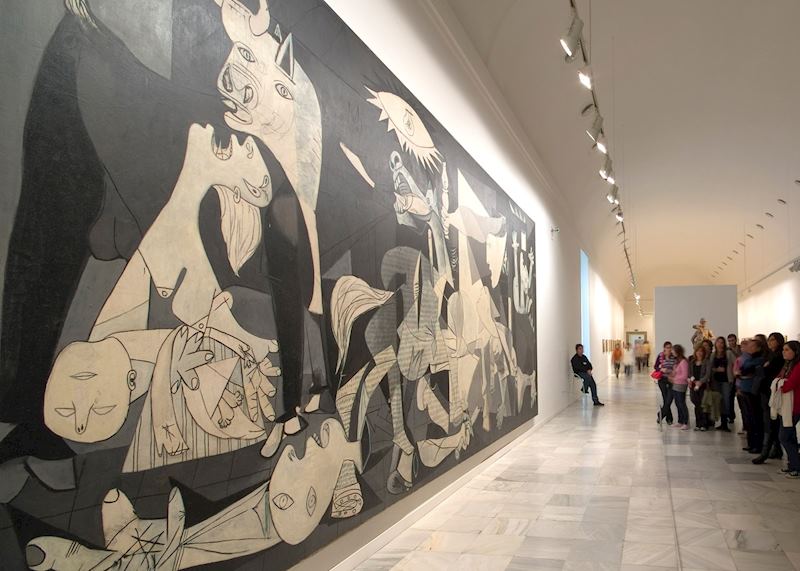
World War II’s dress-rehearsal, the Spanish Civil War left still-gaping wounds both in Madrid and across Spain as a whole. In the Cuidad Universitaria, where the main fighting in Madrid took place, you can still see bullet holes in the buildings along the main avenues and battered Francoist bunkers dotting the forests. Because Franco only died in the 1970s, the war remains fresh in Madrileños’ minds and talking about it is still frowned upon.
Despite that, Madrid is home to one of the era’s most important artworks: the massive and moving Guernica. Painted in 1937, it depicts one of Hitler’s earliest acts of international brutality — the indiscriminate bombardment by the German Condor Legion of the Basque town that shares the painting’s name. The grim, gray-scale work depicts the town’s wholesale slaughter in jagged angles and fractured figures.
The artist himself insisted that the piece not return to his home country until the Spanish people once again enjoyed democracy, a condition that wasn’t fulfilled until 1981. Today, you can see it hanging in grave solitude in a gallery at the Reina Sofía.
Bourbon bomb shelters and vintage cars, Naples, Italy

In the mid-1800s, King Ferdinand II of Bourbon ordered a secret escape tunnel to be built from his Naples palace to a military barracks, in case his fractious subjects rioted. However, the king died before the tunnel was completed.
It was rediscovered in the 1930s, when officials used it as a storage space for impounded cars. Then, once the war began, locals took shelter here from aerial bombardment and parts of the space were expanded and converted to a hospital. After the war, the space became a dumping ground for wartime rubble and fascist monuments.
Today, you can visit the tunnels, which are dark and close, and see the items that have been left here over the years. You’ll see objects left behind by sheltering Neapolitans, including toys and a hairbrush. Ranks of vintage cars slowly moulder into rust, broken bicycle skeletons have turned ghostly pale with dust, and a cracked, nose-less statue of fascist leader Aurelio Padovani leans against a wall, staring off into the darkness.
Read more about trips to Europe
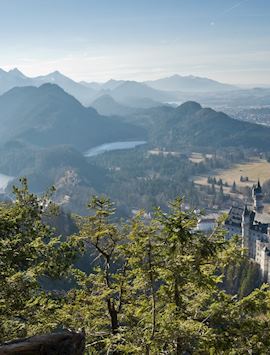
Highlights of Germany self-drive
13 days from $4,250pp
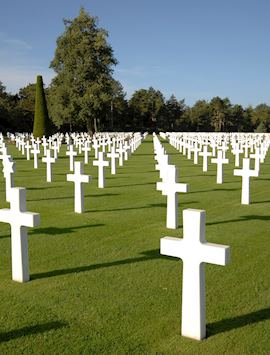
Classic Paris & the Normandy D-Day beaches
9 days from $6,995pp
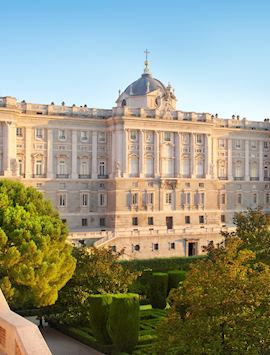
Madrid, San Sebastián & La Rioja tour
7 days from $8,920pp
Start thinking about your experience. These itineraries are simply suggestions for how you could enjoy some of the same experiences as our specialists. They’re just for inspiration, because your trip will be created around your particular tastes.
Further reading
- Historic England: exploring London, Oxford and Bath
- Introducing Normandy: from the D-Day Beaches to the Bayeux Tapestry
- In and around Madrid: our highlights
- Unlocking Italy’s key Roman sites of Rome, Pompeii & Herculaneum
Plan your trip
Tell us about your plans and one of our specialists will plan a unique trip for you...
Request our brochure, The World Your Way

Order your digital copy via email.
- Skip to primary navigation
- Skip to main content
- Skip to primary sidebar
- Skip to footer
TravelAwaits
Our mission is to serve the 50+ traveler who's ready to cross a few items off their bucket list.
10 World War II Sites To Visit In Poland

Janick C / Shutterstock
- Activities and Interests
- Destinations
- Europe National Parks
- History and Culture
- National Parks
Poland is a country few of us know much about, and it’s no wonder. Up until 1989, Poland sat behind the communist iron curtain. It was a closed country: Travel in and out was near impossible for the curious traveler.
This shroud of secrecy meant that the key to understanding some of the most impactful recent world events, namely World War II, were out of reach save for interpretations in history books and movies.
But Poland is once again accessible and this proud nation isn’t shy about allowing visitors to contemplate the atrocities of WWII that occurred within its borders.
For history buffs, Poland offers a treasure trove of intrigue, mystery and, most importantly, answers.
To learn about these sites prior to your trip, I’ve included the titles of some movies you may like to watch ahead of time. I guarantee this will enhance your experience.
During our eight weeks touring this vast country, we visited many of its WWII sites and I share our top list of must-see spots below. These are listed in order of a suggested itinerary.

agsaz / Shutterstock
1. Oskar Schindler’s Enamel Factory
This world-class museum in Krakow is a tribute to Oskar Schindler, the solitary, wealthy German businessman who saved over 1,000 Jews from certain death in WWII by purchasing and running his ammunition shells factory using Jewish labor.
This museum is part of the Krakow Historical Museum, which provides an emotive, interactive, visually impressive exhibition on the Nazi occupation of Krakow.
Booking ahead is absolutely essential. Tickets are under $7 USD and a guide is recommended.
My Movie Recommendation: Schindler’s List , 1993, starring Liam Neeson

Taiftin / Shutterstock
2. Auschwitz-Birkenau
Probably one of Poland’s most visited WWII tourist destinations, Auschwitz-Birkenau is also one of the saddest places most people will visit in Poland.
At Auschwitz, you will see the atrocious Jewish living conditions, the wall against which thousands were lined up and shot, the gallows where mass hangings took place in front of the assembled prisoners, ruptured gas canisters and mountains of shoes, spectacles, and human hair.
The vast Birkenau site, located just over a mile away, is the associated mass extermination camp.
Auschwitz and Birkenau can be visited from Krakow for a day trip. To get there, you can take the train or bus, hire a car and private driver, or join a tour.
The best time for a visit is in the shoulder season (May and June or September and October), not because there are fewer crowds — it’s always busy — but because of the heat. If it’s too hot, the tour will be cut short around Birkenau due to lack of shade.
With over 2 million visitors each year, this place books out quickly and daily numbers are restricted. You can enter for free before 10 a.m. and after 4 p.m. with a previously reserved time slot. I recommend booking a guided tour online, in advance, for about $30 for two people.
My Movie Recommendation: Auschwitz , 2011, starring Steffen Mennekes

Pavel Stasevich / Shutterstock
3. Warsaw Uprising Museum
Opened in 2004 and voted one of Poland’s best museums, this Warsaw museum is a must visit.
Here, you will find numerous interactive displays, video footage, and photographs depicting what Warsaw’s occupants were fighting against when Nazi Germany occupied the capital city in 1944.
Make sure to see the thought-provoking film City of Ruins . It’s a 5-minute aerial look at the desolation of Warsaw after the war, showing that very few buildings were left standing.
You will also find an exact replica of a B24 Allied plane, the model used to make supply drops over the besieged city.
Entrance to the museum is free on Sundays, otherwise you will pay under $10 USD per person. Allow at least two hours to wander around and learn about the Uprising.
My Movie Recommendation: Warsaw Uprising , 2014, starring Jozef Pawlowski

posztos / Shutterstock
4. Museum Of The History Of Polish Jews
Named the European Museum of the Year in 2016, this Warsaw museum, while not technically about WWII alone, gives an understanding of the Jewish population in Poland leading up to the Holocaust.
The Museum, which depicts a thousand years of the history of the Polish Jews, explains in an interactive way how the Jewish people were revered by society, how they were integrated into significant positions in the community, and how their skill set was used to bolster the economy of Poland.
Learn how the Holocaust drastically impacted the Jews of Poland. Also hear about the Jewish community revival after the Second World War.
The museum is closed on Tuesdays. Tickets are just over $7 USD.
My Movie Recommendation: The Pianist , 2002, set in Warsaw

Wikimedia Commons ( CC BY-SA 3.0 )
5. Palmiry National Memorial And Museum
Located in the Kampinos National Park, a 30-minute drive from Warsaw, this became the site of 21 separate mass executions during the war. These were performed by German soldiers against 1,700 Poles and Jews, many of whom were academic and cultural figures.
Inside the museum you will find excellent information boards, photographs, and records of the atrocities of war. You will see exhumed items from the deceased, donated to the museum by relatives of the victims, in a number of glass cases.
Outside is a large, perfectly manicured cemetery of marked and unmarked crosses.
Entry to the museum is free of charge. It is closed on Mondays.

ASkwarczynski / Shutterstock
6. Treblinka Concentration Camp
Treblinka was the second-biggest Nazi death camp in occupied Poland.
Built away from prying eyes, two camps were set up by the Germans: a forced labor camp and an extermination camp. A despicable mass extermination of between 800,000 and 920,000 Jews took place here during World War II.
Although the buildings were burnt to conceal these war crimes, today Treblinka is the site of a small museum and an open-air memorial providing space for reflection and thought.
Located fewer than 70 miles from Poland’s capital, Warsaw, Treblinka is certainly a worthy site to put on your list.
The cost of Treblinka Museum admission for two people is under $10 USD.
My Movie Recommendation: Treblinka’s Last Witness , 2016, documentary

Karolis Kavolelis / Shutterstock
7. Wolf’s Lair, Hitler’s Bunker In Poland
Did you know Hitler had his headquarters in Poland, and spent 800 days there?
Famous for the failed attempt by Claus Schenk Count von Stauffenberg on Hitler’s life, the Wolf’s Lair is a series of bunkers hidden in the forest that even housed a casino to entertain the guards.
Today, you will find a small museum , informative storyboards, and the bunker ruins overrun by Mother Nature. Don’t expect, however, to be walking inside the bunkers, as they are off-limits.
My Movie Recommendation: Valkyrie , 2008, starring Tom Cruise

Wojciech Dziadosz / Shutterstock
8. Museum Of The Second World War
This was, without a doubt, one of the best museums in Poland, in my humble opinion. Not only will you learn about WWII from Poland’s perspective, but this Gdansk museum also expands into an exploration of the Japanese side of the war.
The museum tells the story of the war in terms of politics, ideology, and civil population. It shows the lives and fates of civilians and soldiers, not just in Poland but in other European countries as well.
Admission is under $20 USD for two people and includes a recommended audio guide.

dies-irae / Shutterstock
9. Westerplatte
It was at Westerplatte that Poland was first attacked on September 1, 1939. The Polish garrison in Westerplatte held out for seven days before surrendering.
Today, you can enjoy a comprehensive outdoor museum in the form of signboards that tell the story leading up to the war.
Then visit the memorial, an 80-foot granite statue made up of 236 blocks and known as Coast Defenders .
One of the guardhouses is a small museum , while the others are left in ruin for visitors to contemplate the fate of those at ground zero.
My Movie Recommendation: 1939 Battle of Westerplatte , 2013, starring Robert Zoledziewski

Yanek / fotopolska.eu / Wikimedia Commons ( CC BY-SA 3.0 )
The Battle of Hel was one of the longest battles in Poland at the start of WWII. At Poland’s naval site, construction was still being undertaken when war broke out. Germany attacked by air, and while 2,800 soldiers fought bravely to stave off the enemy, Poland capitulated just 20 days later.
Today, you will see the tank embankments, a camouflaged tank, gun emplacements, and evidence of underground bunkers.
You can arrive at Hel by train from Gdansk and enjoy the modern seaside boardwalks that follow the ocean curvature. It is free to wander around.
Whatever sights you choose to visit in Poland, there are plenty of opportunities to fill your history cup to overflowing. Every town happily provides an opportunity to delve into its history, whether it’s a little or a lot. Poland’s efforts to provide a broader understanding of WWII will benefit anyone willing to visit its sites.
Touring the country? Here’s how to spend a day in Warsaw , seven beautiful places in Krakow , and a case for visiting the mysterious twisted trees of Poland before you leave.

Ruth is a Kiwi (New Zealander), traveling with her husband Alan through Europe full-time in their motorhome named “Betsy.“ After 30 months on the road, they have visited 30 countries, and have written over 80 articles on their blog Travel-Cook-Eat . At this stage they have no intention of an end date to their travels and look forward to learning and writing more interesting content.
Exploring World War II Sites in Italy
Where to Remember the Great War in the Italian Countryside
:max_bytes(150000):strip_icc():format(webp)/martha_bio-56a3c8865f9b58b7d0d3b5fe.jpg)
Italy has many historic monuments, battlegrounds, and museums related to World War II, some in lovely settings that belie the bloody history of the worldwide conflict. Here are a few.
Abbey of Montecassino
One of the most popular sites to visit is the reconstructed Abbey of Montecassino , the site of a famous World War II battle and one of Europe's oldest monasteries. Perched on a mountaintop between Rome and Naples, the Abbey has great views and is very interesting to explore. Allow at least a couple of hours to see everything.
There is also a small War Museum in the town of Cassino, below Montecassino and another on the coast, the Anzio Beachhead Museum , in the center of Anzio near the train station.
Cassino and Florence American Cemeteries
During both World War I and II, thousands of Americans died in European battles. Italy has two large American cemeteries that can be visited. The Sicily-Rome Cemetery at Nettuno is south of Rome (see southern Lazio map ). There are 7,861 graves of American soldiers and 3,095 names of the missing inscribed on the chapel walls. Nettuno can be reached by train and from there it is about a 10-minute walk or a short taxi ride. Also in Nettuno is the Museum of the Landing .
The Florence American Cemetery , located on the Via Cassia just south of Florence, can easily be reached by bus with a stop near the front gate. More than 4,000 identified soldiers were buried at the Florence American Cemetery and there is also s a memorial to missing soldiers with 1,409 names.
Both cemeteries are open daily from 9-5 and closed on December 25 and January 1. A staff member is available in the visitor building to escort relatives to grave sites and there is a search box on the website with the names of those buried or listed on the memorials.
Mausoleum of the 40 Martyrs
This modern memorial chapel and garden called "Mausoleo dei 40 Martiri" in Italian, is located in the town of Gubbio, in the Umbria region of Italy. It memorializes the location where 40 Italian villagers were massacred by retreating German troops on June 22, 1944.
Forty men and women aged 17 to 61 were killed and placed in a mass grave, but despite decades of investigation, authorities have been unable to take the responsible persons to trial: all of the German officers allegedly involved were dead by 2001. The white mausoleum contains marble plaques on the sarcophagi for each of the individuals, some with photographs. The adjacent garden incorporates a wall where the martyrs were shot and protects the original mass grave locations, and forty cypresses line the avenue up to the monument.
Yearly events remembering the massacre are held in June of each year. Open year-round.
Tempio Della Fraternità di Cella
The Temple of Fraternity at Cella is a Roman Catholic sanctuary in the town of Varzi, in the Lombardy region. It was constructed in the 1950s by Don Adamo Accosa, out of the broken remains of churches throughout the world which had been destroyed in the war. His first ventures were helped by Bishop Angelo Roncalli, who later became Pope John XXIII and sent the first stone to Accosa from an altar of a church near Coutances, near Normandy in France.
Other pieces include the baptismal font was built from the turret of the Naval battleship Andrea Doria; the pulpit is made from two British ships who participated in the Battle of Normandy. Stones were sent from all the major conflict sites: Berlin, London, Dresden, Warsaw, Montecassino, El Alamein, Hiroshima, and Nagasaki.
A Travel Guide Recommendation
If you're interested in visiting a few of these sites, the book A Travel Guide to World War II Sites in Italy makes a good companion. Available both on Kindle or in paperback, the book has details about visiting many sites with visitor information for each including how to get there, hours, and what to see. The book also has maps and photos taken in Italy during the war.
Liberation Day Observances in Italy
20 Best Things to Do in Florence, Italy
Top 15 Monuments and Historic Sites in Paris
8 Best Things to Do in Vatican City
The 14 Best Day Trips from Rome
Visiting Montecassino Abbey
Boston Irish Heritage Trail
Top Normandy D-Day Landing Beaches and World War II Sites
The 26 Best Washington, D.C. Monuments and Memorials
North Coast of France: The Ultimate Road Trip From Dieppe to Calais
Monasteries to Visit in Italy
Moscow - Russian Rivers and Waterways Port of Call
Lazio Region Travel Maps
A Tour of World War I Memorials in France
World War I Meuse-Argonne American Military Cemetery
Visit 8 United States War Memorials That Honor the Fallen

Sign Up Today
Start your 14 day free trial today
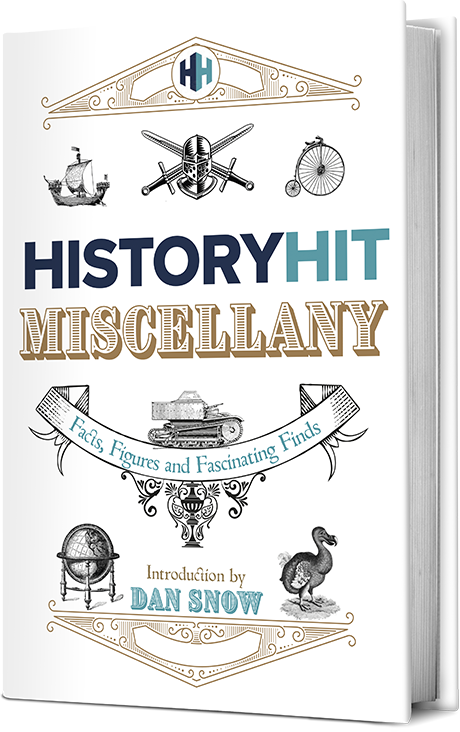
The History Hit Miscellany of Facts, Figures and Fascinating Finds
10 Places to Explore World War Two’s History in England
Experience the sights of wartime england..

19 Dec 2022
World War Two was one of the defining moments in British History. Unlike many conflicts, the war directly impacted regular people – especially during the Battle of Britain and The Blitz – along with its effects on everyday life, including rationing and black-outs.
There are many locations where you can experience the sights of wartime England and explore the history of those who fought. Here’s our guide to just some of England’s significant World War Two locations, museums and monuments.

1. The Cabinet War Rooms
Secreted beneath the streets of Westminster, the Cabinet War Rooms are part of the underground bunker complex now known as the Churchill War Rooms in London where Britain’s wartime government operated during World War Two.
Today, visitors can walk through the corridors from which Winston Churchill directed Britain and stop at the Churchill Museum. Open between 9.30am and 6pm, the museum tells a story through personal items and artefacts from Churchill’s childhood to his military and political career.

2. Bletchley Park
Bletchley Park is an English country house and estate in Milton Keynes, 50 miles north of London . Originally the eccentric home of the Leon family, Bletchley Park then came into the possession of MI6, becoming in 1938 a vital British intelligence centre.
Over the course of the ensuing Second World War, a team of British codebreakers at Bletchley Park – then known by the codename Station X – managed to decipher the machinations of Enigma , the highly effective code encryption machine used by the Nazis. The British government were thus finally able to intercept German messages, and could begin to map their enemy’s military movements.

3. White Cliffs of Dover
The famous White Cliffs of Dover stand guard at the Gateway to England. In some places over 300 feet high, the White Cliffs are a symbol of the United Kingdom and a reassuring sight to travellers. The cliffs also have a special place in our national history – used for defence in both World Wars, the Cliffs have been immortalised in song, in literature and in art.
During the Second World War, the White Cliffs of Dover were Britain’s frontline from 1941 and large gun batteries were constructed along the coast. On the cliffs close to South Foreland, important gun positions were built which would attack enemy forces across the Channel. Although quickly constructed and only fired sparingly, the guns were an important aspect of the defence of Britain.

4. Southwick House
Southwick House is a Grade II listed 19th-century manor house, 5 miles north of Portsmouth, and is the site from which D-Day was launched.
The village of Southwick was later entirely taken over by Allied Command, and Southwick House itself was used as the advance command post (Sharpener Camp) for the Supreme Headquarters Allied Expeditionary Force (SHAEF). In 1944, in the months leading up to D-Day, the house became the headquarters of the main allied commanders, with General Eisenhower, Admiral Ramsay and General Montgomery all based here.
Eisenhower made his decision to delay D-Day by 24 hours (due to poor weather) in the library of Southwick House, and indeed the whole D-Day operation was organised from here.

5. Imperial War Museum
The Imperial War Museum is dedicated to exploring worldwide conflicts throughout history. The exhibitions in the London Imperial War Museum cover, amongst other things, different aspects of the First and Second World Wars including military history, the Holocaust, women’s roles in the conflicts, wartime artwork and the political issues of the time.
At the beginning of the Second World War, the museum’s remit was extended and a collecting programme began. Vulnerable collections were evacuated to stores outside London and the museum was closed to the public from September 1940 to November 1946. There were more than 40 incendiary hits on the building during the war, which caused varying amounts of damage.

6. Western Approaches Museum
The Western Approaches Museum in Liverpool sits within a World War Two bunker complex which served as the combined services command centre during the Battle of the Atlantic – the Allied fight against the German U-boat offensive in the Atlantic ocean.
A bunker was built below Derby House, with extensive reinforced concrete protection given to the basement. It was bomb proof and gas proof, with a 7ft thick concrete roof and 3ft deep concrete walls, containing 100 rooms covering 55,000 square feet.
The museum allows you to step back in time and undertake a unique experience, where you don’t just see the history but can actually venture inside to experience it first-hand.

7. Lepe Beach
The sand and shingle shore at Lepe and nearby Stone Point was used as a troop embarkation point for D-Day, for soldiers camped in ‘Marshalling Area B’.
Lepe and the surrounding area came under the control of the shore station HMS Mastodon, and many hundreds of troops with their equipment, vehicles and ammunition were hidden along the narrow roads and in numerous closed camps hidden in the wooded areas across the New Forest in the build-up to D-Day .
From 31 May 1944 onwards, soldiers made their way down to the coast to embark onto the ships and landing craft that would take them to Normandy – some on the Lepe shore, others at sites to the east or west, notably in Southampton. Vehicles were loaded earlier, but the soldiers themselves embarked only just before D-Day, followed by those who would be landing on subsequent days.

8. The D-Day Story, Portsmouth
The D-Day Story is the only museum in the UK dedicated to the Allied Invasion in June 1944 – telling the unique personal stories behind this epic event.
Whilst the Normandy landings took place in France, the whole operation depended upon dozens of embarkation areas along the whole stretch of the south coast of England , where troops and supplies were held before loading onto the ships and landing craft.
The D-Day Story museum tells the story of this, as well as that of D-Day itself and the Battle of Normandy. It also covers the story of the liberation of Europe from Nazi Germany occupation – through the personal possessions and words of the people who took part, as well as using imagery, audio-visual presentations, authentic vehicles and hands-on interactives help to bring the story to life.

9. The Royal Air Force Museum London
The Royal Air Force Museum (RAF Museum) is located on the former Hendon Aerodrome in Colindale, North London. The museum includes five buildings and hangars which showcase a series of exhibitions dedicated to the history of aviation and which celebrate and commemorate the first 100 years of the RAF and its role today.
The museum site was one of the first civilian airfields, acquired by Claude Grahame-White in 1911. In 1914, the aerodrome was requisitioned for Home Defence during the First World War as part of the RAF Hendon Royal Naval Air Station, training new pilots in the flying schools on site.
Following the outbreak of World War Two in 1939, the site at Hendon became an operational RAF station again – home to No. 24 Transport and Communications Squadron. It also briefly served as a fighter station during the Battle of Britain.
The museum housed on the site today was officially opened on 15 November 1972 by the Queen. Housing a fantastic collection of over 100 aircraft, the RAF museum has an impressive selection of planes including some of the most famous ever to have graced the skies.

10. Langstone Harbour and Hayling Island
Langstone Harbour and Hayling Island were used as sites for the construction of components of the ‘Mulberry Harbours’ – the artificial harbours created by the Allies to enable them to land their forces in Normandy on D-Day.
As part of the planning for Operation Overlord (codename for the Battle of Normandy) and due to the lack of big port facilities in Normandy, it was decided that artificial harbours were needed in order to quickly offload the heavy and bulky crucial cargo needed to support a successful invasion.
These artificial harbours, codenamed Mulberry, were built in Britain before being towed across the Channel with the Allied invasion force on D-Day, and then assembled by the army once in the waters surrounding France.
27 Meaningful Places to See World War II Sites in Berlin
This post contains links which earn me a small commission at no cost to you.
Ali Garland, Berlin expert & long term resident What to Do
World War II shaped Berlin’s and Germany’s history, and the horrible things that occurred are never forgotten. If you’re interested in World War II history, this extensive list of places to see World War II sites in Berlin is for you.
Berlin has many World War II sites and attractions that are worth visiting to learn about this history and to remember the many victims.
Since many of the atrocities that took place actually happened before the war started, I’ve included memorials and museums that cover the time period leading up to the war.
In this list of Berlin World War 2 attractions , you’ll find museums, memorials, and other sights that have ties to the war, the Holocaust, and the events in the years before war broke out.
Please visit these places with respect. Many of these sites honor tragic events and deceased victims.

What you'll find here
Tours that focus on World War II in Berlin
Taking a tour can be a great way to see several World War II sights in Berlin while also learning the history from an expert guide. Here are a few we recommend.
- Berlin Small Group Third Reich and Cold War Walking Tour
- Berlin World War II & Third Reich Tour
- Sachsenhausen Concentration Camp Half-Day Tour From Berlin
- Third Reich Berlin Walking Tour – Hitler and WWII
- Berlin Jewish History Walking Tour
Where to stay in Berlin
Berlin has lots of great neighborhoods for you to stay in and explore. If you’re visiting Berlin for the first time, it might be best for you stay somewhere central.
Many of the attractions are in Mitte or easily connected to Mitte by Berlin’s public transport , so you should stay somewhere in that region. Here are a few hotels we recommend.
BUDGET: Circus Hostel Popular hostel with a bar/brewery downstairs
MIDRANGE: Circus Hotel Centrally located near restaurants & transport
UPSCALE: Westin Grand Centrally located, can chisel off your own piece of the Berlin Wall
UPSCALE: Westin Grand Luxury hotel where you can chisel off your own piece of the Berlin Wall
APARTMENT: Adina Apartment Hotel Kitchenette; near grocery stores, shopping, Museum Island
For a more detailed look at the different neighborhoods and our hotel recommendations, check out our guide to where to stay in Berlin .
Or read my full review of the 25Hours Hotel in Charlottenburg with fantastic views of the Zoo and Tiergarten.
Where to find World War II sites in Berlin
From the well known memorials and museums to the ones you may not have heard about, this list of places to see World War II sites in Berlin is a great way to explore the city’s dark history.
Also, check out our list of the best World War II and Cold War sites in Berlin .
Map of Berlin WWII attractions
All the memorials, museums, and other WWII sites I mention in this article are on this map, except the Stolpersteine since there are so many locations of them throughout the city.
Memorial to the Murdered Jews of Europe
The Memorial to the Murdered Jews of Europe, often referred to as the Berlin Holocaust Memorial , honors the large number of Jewish people who died at the hands of the Nazis. This is one of the most important World War II sights in Berlin, and it’s probably already on your Berlin bucket list .

The memorial consists of 2,711 concrete blocks of varying heights, and the ground they sit on is an uneven slope similar to a wave. It’s supposed to make you feel uneasy.
The information center is inside and showcases letters, diaries, photographs, and biographies of the victims to help personalize the experience.
Entrance is free. The outside section is open 24/7, but check opening times for the information center. Photography is allowed (no flash inside) but please be respectful.
Do not sit on or climb on the cement slabs or take selfies. This is a place to reflect and remember those who were murdered.
Location: Cora-Berliner-Straße 1, 10117 Berlin

A small but powerful memorial sits in the middle of Bebelplatz along Unter den Linden , an important sightseeing area that’s probably already on your Berlin itinerary . If you don’t look down, you might miss it.
It’s a square glass panel, and when you look down, you’ll see empty shelves. This is a sight that remembers what was lost on May 10, 1933 when the Nazis burned approximately 20,000 books whose stories they didn’t want told.
Location: Bebelpl. 1, 10117 Berlin

Join our Facebook group!
Have questions about planning your trip to Berlin?
Join the Facebook group here to chat with Ali (she runs this site) and other people who have been to Berlin for tips.
Topography of Terror
The Topography of Terror Museum is one of the more interesting things to do in Berlin because it sits on the location that was the headquarters of the Gestapo and the SS between 1933 and 1945. This is where persecution and killings of Nazi opponents were organized, and where the genocide of Jews, Roma, and Sinti was coordinated.

This powerful museum now serves as a place to remember history and warn us from repeating the terrors of the past. The exhibits here use photographs and documentation to tell visitors about the crimes that were organized here, plus there are excavation sites you can view through glass windows.
Topography of Terror is definitely one to add to your list of places to see World War II sites in Berlin. Read my full guide to visiting Topography of Terror for more information and tips.
Location: Niederkirchnerstraße 8, 10963 Berlin
Stolpersteine

Every so often when you’re walking around Berlin, glance down at the sidewalk below you. You might see Stolpersteine, which are small brass squares that honor victims of the Nazis.
These “stumbling stones” sit in front of the victims’ last known address before they were taken away. Their name, date of birth, date of death if known, and where they were taken are among the details listed on these humble but meaningful memorials.

Nazi Forced Labor Documentation Center
Managed by the Topography of Terror Foundation, the Nazi Forced Labor Documentation Center in the Schöneweide neighborhood is the location of a former forced labor camp. This is just one of over 3,000 that once existed in the Berlin area.
In the exhibition spaces and in the air raid shelter, you can view inscriptions, letters, and biographies of the people who were imprisoned at this labor camp. You can also tour some of the barracks, view the living conditions, and learn about the every day lives of the prisoners. This is one of many free museums in Berlin .
Location: Britzer Str. 5, 12439 Berlin
Reichstag Building

The Reichstag Building is the current seat of the German Parliament and one of the most historic landmarks in Germany . It also has quite a history with both World War II and the Cold War.
It was used by the German government until 1933 when a fire greatly damaged the building. Marking the end of the Weimar Republic and the strengthening of the Nazi dictatorship, the building was neglected and suffered more damage during WWII.
After the war, when Berlin was divided into East and West, the Reichstag Building sat in the West just steps from the Berlin Wall. The seat of the German government has moved to Bonn, and though the building was somewhat repaired, it was seldom used.
After reunification, the building was redesigned and restored. It opened in 1999, and the German Parliament returned here once again.
Today you can take a free tour of the Reichstag Building , but you must register well ahead of time. It’s one of the most popular free things to do in Berlin .
Location: Platz der Republik 1, 11011 Berlin
Jewish Museum
The Berlin Jewish Museum tells the stories of Jewish people in Germany from the Middle Ages to present day. The whole museum, inside and out, is designed to be part of the experience of learning about the diverse Jewish culture and the gaps made by the Holocaust.
You can explore three different sections of the museum that teach about different aspects of Jewish life, culture, and history in Germany. The museum uses a lot of symbolism, which makes this creative space more impactful. For example, in one area, uneven ground conveys a feeling of uncertainty.
This is a fantastic museum to visit if you’re interested in the history of the Jewish people in Germany.
Location: Lindenstraße 9-14, 10969 Berlin
Platform 17 Memorial
At the Grunewald S-Bahn station in the southwest corner of Berlin, you can see the Platform 17 Memorial. This station was used by the Nazis in the early 1940s to transport Jews to concentration camps.
Since it’s not centrally located, it was easier for the Nazis to make sure their prisoners weren’t seen while lining up to board the train. Today this memorial honors those who left from this station and were taken to horrible places where they were most likely killed.
The memorial was sponsored by Deutsche Bahn, Germany’s railway company, and track 17 is no longer used by any trains. The Platform 17 Memorial doesn’t take long to visit and is a 25 minute Sbahn ride from the Alexanderplatz station.
Location: Am Bahnhof Grunewald, 14193 Berlin
>>Check out these unique things to do in Berlin .
Anhalter Bahnhof

A little south of Potsdamer Platz is Anhalter Bahnhof, the remains of a train station. It was once one of the most important train stations in Berlin, and part of Berlin’s World War II history.
Unfortunately during the Nazi era, it was one of three stations in Berlin used to deport Jews to concentration camps. The station was damaged during WWII, but was still operational for several more years.
Anhalter Bahnhof is located in the former East. When the Soviets started using Ostbahnhof as the main train station in the East, Anhalter Bahnhof was no longer needed, and operations ceased in 1952.
Location: Askanischer Pl. 6, 10963 Berlin
>>Read: 13 Places to See the Berlin Wall + 9 Other Wall Attractions
Olympic Stadium

The Olympic Stadium in Berlin is another World War II site to visit. Built by renowned architect Werner March, this geometric masterpiece can hold up to 100,000 people.
But it has a dark history. During the Nazi regime, the Olympic Stadium was used to host propaganda events.
Today it’s an open-air venue used for concerts and other large events. If you visit the stadium on an event-free day, you can take a tour of the stadium and learn about its role during the Second World War.
Location: Olympischer Platz 3, 14053 Berlin
>>Read: 17 Top Sights in Berlin From a Local Who Knows
Kaiser Wilhelm Memorial Church

This famous Berlin landmark is one of the most important churches in Berlin. The original church was built here in the 1890s, but was damaged in WWII air raids in 1943.
Interestingly, the church was not rebuilt and instead has been left much as it was after World War II. Its been nicknamed by Berliners as Der Hohle Zahn—literally “The Hollow Tooth”.
This church is a stark reminder of the destruction of war and an interesting World War II site in Berlin.
Location: Breitscheidplatz, 10789 Berlin
Soviet War Memorial in Treptow Park
Located in Berlin’s Treptow Park in the southern part of the city, the Soviet War Memorial commemorates 7,000 of the 80,000 soldiers of the Red Army who lost their lives in the Battle of Berlin in 1945.
Part memorial, part cemetery, this is one of several Soviet War Memorials in Berlin, and was inaugurated in 1949, four years after the war. It’s an impressive example of a soaring Soviet monument.
Location: Puschkinallee, 12435 Berlin
Soviet War Memorial in Tiergarten

The Soviet War Memorial in Tiergarten Park is the other well known one in Berlin. It’s large and even includes a tank.
The memorial’s location was strategic – it’s within the park along Strasse des 17 Juni, not far from the Victory Column, the Reichstag Building, and Brandenburg Gate . Of all the Soviet War Memorials in and near Berlin, this is the only one that was built in the former West.
There are several other Soviet War Memorials in and near Berlin, but these are the two that are most central.
Location: Str. des 17. Juni 4, 10557 Berlin
Sachsenhausen Concentration Camp
One of the more popular day trips from Berlin , the Sachsenhausen Concentration Camp is located just outside the city limits, reachable on public transport with a ticket that includes zone C.

Not only did tens of thousands of people die here, but this concentration camp was the headquarters of the whole concentration camp system. Even after the Nazis were defeated and World War II ended, the Soviets used Sachsenhausen as a camp for their own political enemies, and thousands more died over the next five years.
Though this is a somber site, it’s important to learn about those who suffered and died here. Read more about how to get to Sachsenhausen from Berlin .
Entrance is free, but consider taking a guided tour like this one to enrich your experience: Sachsenhausen Memorial Half-Day Tour From Berlin .
Location: Str. d. Nationen 22, 16515 Oranienburg
Silent Heroes Memorial Center
This memorial center remembers the Jewish people who resisted persecution before and during World War II and those who helped them. The exhibit shows the plight of those who faced deportation and worse, and how they decided to go underground in order to resist.
Learn about their living conditions and how people tried to help them, including both successful and failed attempts.
The Silent Heroes Memorial is actually part of a bigger memorial center called the German Resistance Memorial Center, which honors many who resisted the Nazi rule.
The center’s location is also significant as it is the historic site of the attempted coup of July 20, 1944.
Location: Stauffenbergstraße 13-14, 10785 Berlin
Flak Tower in Humboldthain Park

From 1940-41, the Nazis built bunkers and set up an anti-aircraft gun tower in Humboldthain Park. After the war, the bunkers were mostly filled in, and nature began to reclaim the area.
Today not much is visible of its past, but it’s an interesting World War II site to see. And from the viewing platform at the top of the hill, you’ll be rewarded with some excellent views of Berlin .
The bunkers are now home to bats during the winter, but in the summer, Berliner Unterwelten offers tours of some of the underground sections of the demolished flak tower.
Location: Hochstraße 5, 13357 Berlin
Berlin Story Bunker
Near Anhalter Bahnhof is the Berlin Story Bunker museum, which is a bunker from World War I, not II. It tells the history of Berlin over 800 years.
One of the most interesting exhibits is about Hitler, how he came to power, why so many voted for him, and other questions and answers about the Nazi regime and the events leading to and during World War II.
If you’ve ever wondered how it all happened, this is an excellent museum to visit.
Location: Schöneberger Str. 23A, 10963 Berlin
Memorial SA Prison Papestrasse
This former SA prison is the only place remaining with traces of the terrors of the Nazis from as early as 1933. For much of 1933, it was a concentration camp run by the SA Field Police.
Here the SA (Sturmabteilung, or Storm Troopers) imprisoned, interrogated, and tortured political opponents, Jews and other groups persecuted by the Nazi regime. The names of almost 500 prisoners are known, but it is believed that the number is much higher.
At this museum, you can see exhibits documenting the history of this former prison. It also serves as a memorial to those who suffered here.
Location: Werner-Voß-Damm 54A, 12101 Berlin
Museum Berlin-Karlshorst
This museum documents World War II on the eastern front, but its location is also quite significant. The building is where Germany signed their unconditional surrender in front of representatives of Russia, the US, the UK, and France on the night of May 8-9, 1945.
This was the ceremonial recognition of complete defeat and victory over Hilter’s regime. The Museum Berlin-Karlshorst (formerly called the German Russian Museum) isn’t so centrally located, but it’s a significant place to visit for World War II history in Berlin.
Location: Zwieseler Str. 4, 10318 Berlin
Anne Frank Center
The story of Anne Frank and her diary is well known around the world, and if you’re ever in Amsterdam, the Anne Frank House is excellent. But Berlin also honors her memory and legacy with the Anne Frank Center.
At this museum, you can learn about Anne Frank and the history of National Socialism. It’s also an interactive museum that’s great for all ages.
Though there is a small entrance fee, this is one of many excellent cheap activities in Berlin .
Location: Rosenthaler Str. 39, 10178 Berlin
Museum Blindenwekstatt Otto Weidt
During World War II, Otto Weidt ran a workshop making brooms and brushes, and many of his employees were blind and deaf Jews. When they were in danger, he used his shop to help keep them hidden from persecution and deportation.
This museum tells the story of Otto Weidt and his workshop, and it’s another interesting and free World War 2 attraction in Berlin.
Memorial to Homosexuals Persecuted Under Nazism

Though Jews were the biggest group that suffered under the Nazi regime, they weren’t the only victims. In the southeast corner of Tiergarten, you’ll find the Memorial to Homosexuals Persecuted Under Nazism.
This memorial uses a video to tell the history of how gays were arrested, tortured, castrated, and killed under Nazi rule. The intention is to encourage tolerance and acceptance while remembering the past.
Location: Ebertstraße, 10785 Berlin, across the street from the Holocaust Memorial
Memorial to the Victims of the Nazi Euthanasia Murders
Under Nazi rule, tens of thousands of patients from sanatoriums and nursing homes as well as people who were deemed to be racially and socially undesirable were murdered. This horrific crime is considered a precursor to the mass murder of European Jews.
Today the memorial is at the location where the euthanasia murder program was planned, developed, and carried out.
Location: Tiergartenstraße 4, 10785 Berlin
Memorial to European Sinti and Roma Murdered Under Nazism

On the eastern edge of Tiergarten, you can see the Memorial to European Sinti and Roma Murdered Under Nazism. This memorial honors the memory of the many Sinti and Roma people, formerly called “gypsies”, who were killed under the Nazi regime.
You can learn about the history of this group and what happened to them, and there’s a fountain where a flower is placed every day.
Location: Simsonweg, 10117 Berlin
Memorial to the Murdered Members of the Reichstag

Political leaders in Germany were also victims of the Nazis. The Memorial to the Murdered Members of the Reichstag honors the 96 known members of Parliament who died at the hands of the Nazis before and during World War II.
You can see this memorial in Platz der Republik, in front of the Reichstag Building. It’s near the trailer type buildings where you enter for a booked free tour.
Honestly, it’s a little cramped here, almost like the memorial was inconveniencing the people who set up the trailer looking buildings. I feel like they could’ve set those trailers back a little farther to give a little space to the memorial.
Location: Scheidemannstraße 5, 10557 Berlin
House of the Wannsee Conference
This luxury villa was the location of the infamous Wannsee Conference in 1942. Nazi government officials met to discuss the so-called “Final Solution to the Jewish Question” here.
Today this location serves as a museum documenting this awful meeting and how their plan was put into action. It’s also a Holocaust memorial where you can learn about the genocide of the Jewish population.
This World War II site isn’t centrally located, but it’s a historically important attraction to visit.
Location: Am Großen Wannsee 56-58, 14109 Berlin
Cecilienhof Palace

Cecilienhof Palace was built from 1914 to 1917 in the style of an English Tudor manor house, and it was the last palace built by the Hohenzollern family. They ruled the Kingdom of Prussia and German Empire until the end of World War I.
This palace is also famous for being the location of the Potsdam conference from July 17 to August 2, 1945, when the Allies met to discuss and decide how to handle post war Europe and Asia. This meeting is seen as the end of World War II and the beginning of the Cold War.
This Cold War site is a great place to include on a day trip to Potsdam .
>>Read: How to Get to Potsdam From Berlin by Train
Location: Im Neuen Garten, 14469 Potsdam
Berlin World War II Tours
Consider taking a tour to see several World War II sights in Berlin while also learning the history from an expert guide. Here are a few we recommend.
Berlin Travel Resources
I want you to have the best trip to Berlin, and hopefully this list of World War II sites in Berlin is helpful. But there are lots more tips on the site!
- 101 Best Things to do in Berlin
- 23 Impressive Castles in Berlin (And Nearby)
- 27 Best World War II & Cold War Sights in Berlin
- 29 Fun Day Trips From Berlin
- 75 Things to Know Before Visiting Berlin: Essential Berlin Travel Tips
- What to Wear & What to Pack for Berlin, Germany: Your Ultimate Berlin Packing List
- How to Get Around in Berlin: An Easy Guide to Berlin Public Transportation
Check out my favorite travel planning sites and resources
These are the sites I like for travel planning, plus items I like to travel with.
Planning Booking.com : Find a Berlin hotel here.
Rick Steves and Lonely Planet : My favorite guidebook resources.
Tours, Activities, Tickets Viator : Great site for finding tours and other activities.
GetYourGuide : Another good option for tours and activities.
Transport Welcome Pickups : No stress option for airport pickups.
Discover Cars : Find a rental car for Germany road trips.
Deutsche Bahn and FlixBus : Best options for getting around Germany.
Packing Orange SIM & eSIM : Great option for SIM & eSIM cards for German & EU.
Collapsible water bottle , plug adapter , and stuff bag : Small things that will make your trip a little easier.
Packing Orange SIM & eSIM : Great option for SIM & eSIM cards for Germany & EU.
Book a local photographer Flytographer : Hire an amazing local photographer anywhere in the world. Use code BERLINTRAVEL to get $25 off your first photo shoot.

Related Posts


What to do in Berlin on Monday: 25+ Museums & More

What to do in Berlin on Sunday: 15+ Ideas

Best Berlin Hop On Hop Off Bus Tours
You could also add the Georg Elser memorial at Wilhelmstrasse, Berlin.
Good one, thanks!
Leave a Reply Cancel reply
Your email address will not be published. Required fields are marked *
Save my name, email, and website in this browser for the next time I comment.
This site uses Akismet to reduce spam. Learn how your comment data is processed .
TTC family of brands
My Trafalgar
Destinations
Get Inspired
866 513 1995
WWI and WWII Battlefields
339 reviews
Seasonal Sale
Save up to $600
Available Dates
Your itinerary
Dates & prices
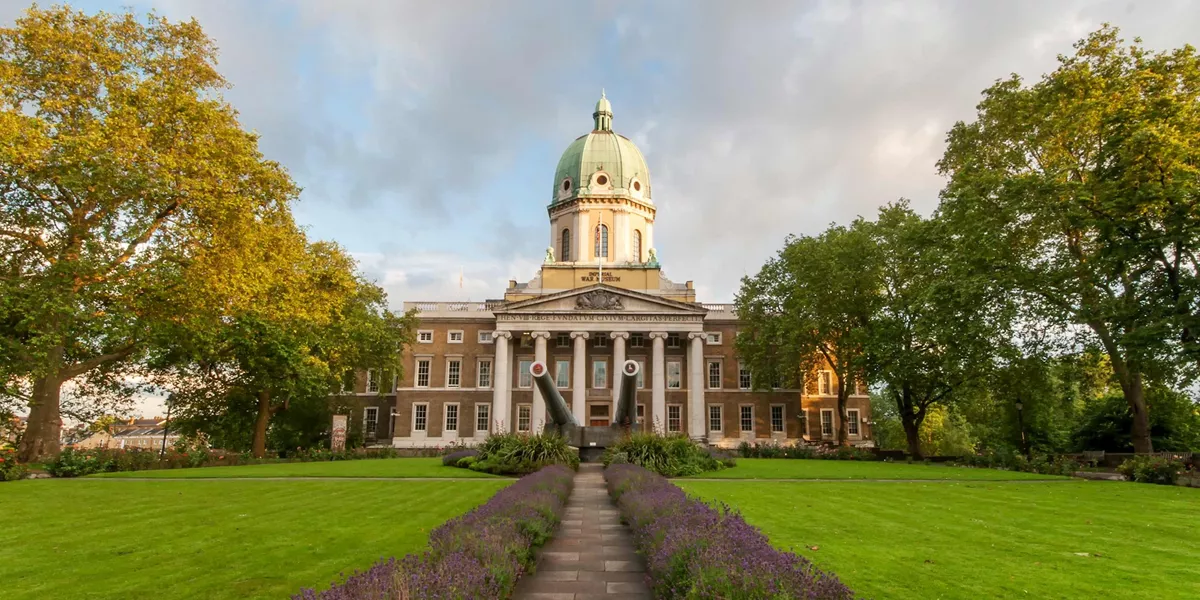
11 Day Battlefield Tour of UK, Belgium and France
11 days, 3 countries and 11 cities
Accommodation
10 Breakfasts, 4 Dinners
View day-by-day trip itinerary
Travel to the front lines of Europe, where brave soldiers once fought for freedom. On this epic battlefield tour through the countryside of Britain, Belgium and France, you’ll explore the tragedy and triumph of two World Wars.
Looking to book in a group of 9 or more?
Deals, savings and exclusive private touring options available plus if you need a different date or itinerary change we can create a custom trip. Contact us for more details
Trip code:
Low deposit from $200
Deposit protection
Free booking changes
Trip map & itinerary
Day by day itinerary
11 days itinerary trip from London to Paris visiting 3 countries and 11 cities
Download itinerary
Print itinerary
Expand all days
About this trip
Sightseeing highlights.
Explore London and Paris
Discover Normandy, Amiens, the Somme Region, Ypres, Brussels and Rouen
Visit the Imperial War Museum in London, the D-Day Landing Beaches, Saint-Sulpice church in Paris, Amiens Cathedral, military cemeteries throughout northern France and Belgium, the Australian National Memorial, the Caen Memorial, WWI & WWII Battlefields, the Dunkirk War Museum and evacuation beaches, and the Memorial Museum Passchendaele
View Buckingham Palace in London, the Eiffel Tower and the Arc de Triomphe in Paris and the Menin Gate
Travel highlights
Specific transfer information can be found here:
Airport Transfers
An expert Travel Director and professional Driver
Cherry-picked hotels, all tried and trusted
All porterage and restaurant gratuities
All hotel tips, charges and local taxes
Breakfast daily and up to half of your evening meals
Must-see sightseeing and surprise extras
Audio headsets for flexible sightseeing
Luxury air-conditioned coach with Wi-Fi in most countries or alternative transportation (such as rail journeys)
Optional Experiences and free time
Eurostar high-speed train from London to Brussels
On occasion, hotels of similar standard and location may be utilized.

MAKE TRAVEL MATTER® Experiences
Every one of our tours includes at least one conscious travel experience that supports one or more of the United Nations Sustainable Development Goals (SDGS). Look out for yours within the day-by-day trip itinerary.
Find out more

Net-zero by 2050
Travel knowing our 4-point climate action plan will ensure net-zero greenhouse gas emissions by 2050.

Support Local
Your tour directly supports local communities by visiting family-run businesses, UNESCO sites and places of cultural significance.

Sustainable Practices
Every part of our business, from trip design to how we run our offices, aligns to our 5-year sustainability strategy which ensures a positive impact on people, the planet and wildlife.

Philanthropic Efforts
Our not-for-profit, the TreadRight Foundation, invests in nature-based solutions to address climate change.
You’ll make a positive impact to people, planet and wildlife on this tour
LIVE, UNEDITED & INDEPENDENT TRAVELER REVIEWS
WWI and WWII Battlefields trip reviews
#ttbattlefields.
Real moments from real travelers, creating the greatest travel stories they’ll ever tell
Or search for something else

Help & Info
WE MAKE TRAVEL MATTER®
Unedited Reviews
Our Destination Management Companies
Frequently Asked Questions
Travel Updates
Do Not Sell or Share My Personal Information
Travel Planning
Get Your Free Brochure
Travel Insurance
Booking Conditions
Trip Deposit Level
Recommendations
Trafalgar Tours Limited is a proud member of The Travel Corporation family of companies.
#SimplyTrafalgar
Travel House, Rue du Manoir St Peter Port, Guernsey, GY1 2JH
Selected Region
United States
United Kingdom
New Zealand
South Africa
Copyright 2024 Trafalgar. All rights reserved.
Terms and Conditions
Privacy Policy
Cookie Policy

Buy Visit Rome Pass, your city pass for visiting Rome. +50 attractions and public transportation included in one tourist card.
✅ Free entrance to the main attractions of Rome ✅ Free public transport
- 7 unmissable World War II sites to visit near Rome
- Places and Tours
Here is where you can see World War II sites in region of Lazio , 7 war landmarks from Rome to Cassino.

June 4th, 1944.
It's a Sunday and the sky is clear over Rome .
General Clark proudly leads the American troops in the liberation of Rome , reaching the Vittoriano buildingat the very heart of the city ,the symbolic place of Mussolini's gatherings. The Roman citizens take to the streets to celebrate the Allies .
The Germans of Field Marshal Albert Kesselring are retreating north , saving further devastation in Rome and Lazio. The Second World War is almost over .
If you've ever wondered where to see World War II sites near Rome, you've come to the right place. We have selected 7 historical sites in Rome and Lazio showing the brutality of the conflict in this part of Italy.
Seven stages for an ideal journey to remember the absurdity of war and to see the scars it left in the Lazio region.
War tourism in the sites of World War II grew a lot in recent years. It should not be considered like a simple recreational activity: war tourism is a moment of study and reflection on an historical period whose consequences still echo strongly today.
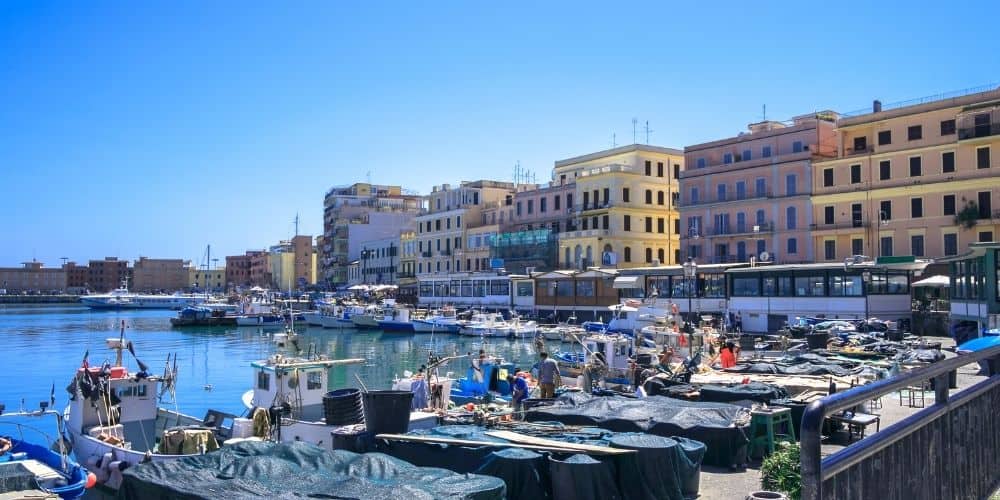
The lively harbour of Anzio.
The Anglo-American troops chose the pretty port towns of Anzio and Nettuno for their landing , at the time united in a single municipality called Nettunia.
The troops landed in January 1944 on the beaches north of Anzio: the Levante beach (codenamed X-Ray and reserved to the Americans) and the coastline that goes from Tor Caldara to Tor San Lorenzo ( Peter Beach , attacked by the English).
The Anzio Beachhead Museum (“Museo dello Sbarco di Anzio”) provides an interesting reconstruction of the landing and the fierce fighting that followed, through unique objects , weapons, vehicles, prints and uniforms. Many of these objects have been fished out few hundreds meter from Anzio's port.
The museum is hosted in the halls of the beautiful Villa Adele , about 400 meters from the train station, and is divided into four sections (English, American, Italian and German). Admission is free and it is possible to book guided tours .
The Paradise on the Sea in Anzio (“Paradiso sul Mare”) is a wonderful Art Nouveau building, born as a casino. It was later chosen by General Mark Clark as the headquarters of the allied command. After the war, the Paradiso was used as a film set for masterpieces such as Fellini's “Amarcord” and Alberto Sordi's “Polvere di stelle”.
Anzio is mentioned in a song by Pink Floyd , "When the tiger broke free", dedicated to Roger Water's father , killed near Anzio in the hours following the troops landing.
Anzio and Nettuno are well connected by train to Roma Termini (1-hour journey, around €5), making it a great day trip for history and sea lovers - there's plenty of fish restaurants too.
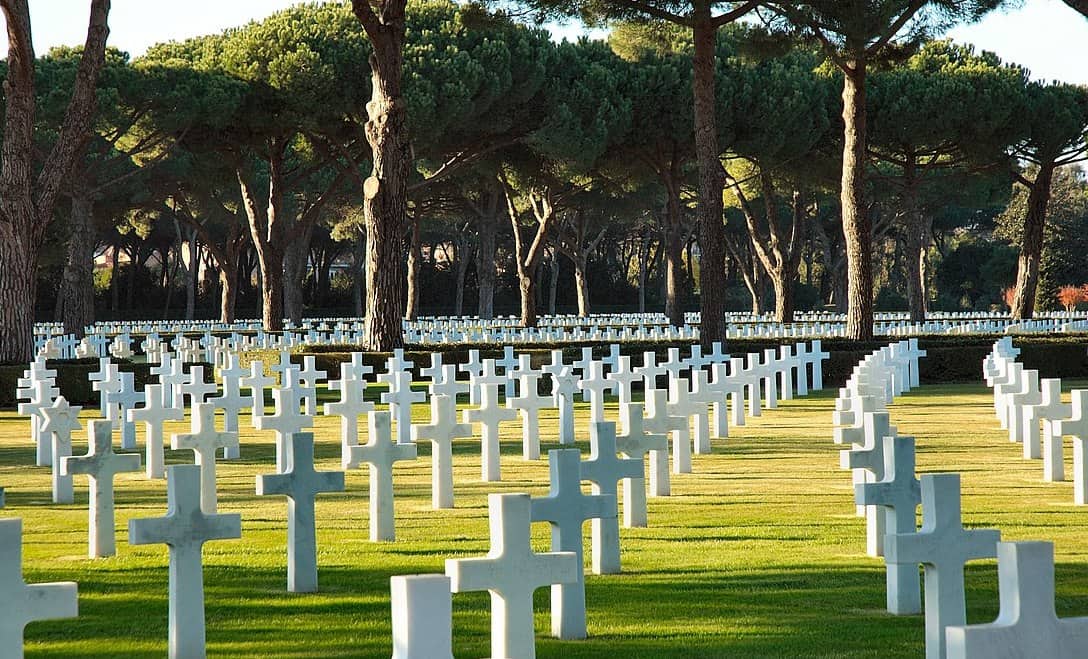
Il American Cemetery in Nettuno (PH: Stephen Sommerhalter - Own work, CC BY 3.0)
Nettuno is quite a popular tourist destination near Rome, boosting a well-preserved medieval town centre (the Borgo Medievale), with cobbled streets, a fort on the sea and a lively atmosphere .
The Sicily – Rome American Cemetery and Memorial (“Cimitero Americano di Nettuno”) attracts crowds of US and British tourists, mostly war veterans and their families, who gather to commemorate the war years and the fallen comrades. The cemetery is surrounded by trees and it's really well-kept, with thousands of white crosses perfectly aligned along the avenue, making the visit an emotional experience.
The cemetery is the resting place for the bodies of nearly 9,000 soldiers who fell in the various battles of the Italian campaign: an ode to the absurdity of war .
American Presidents Bush and Clinton also visited the cemetery on various Memorial Days.
Anzio and Nettuno are well connected by train from Roma Termini (1-hour journey, around €5), making them a perfect day trip from the capital for sea and history lovers.

5. Bunker of Monte Soratte
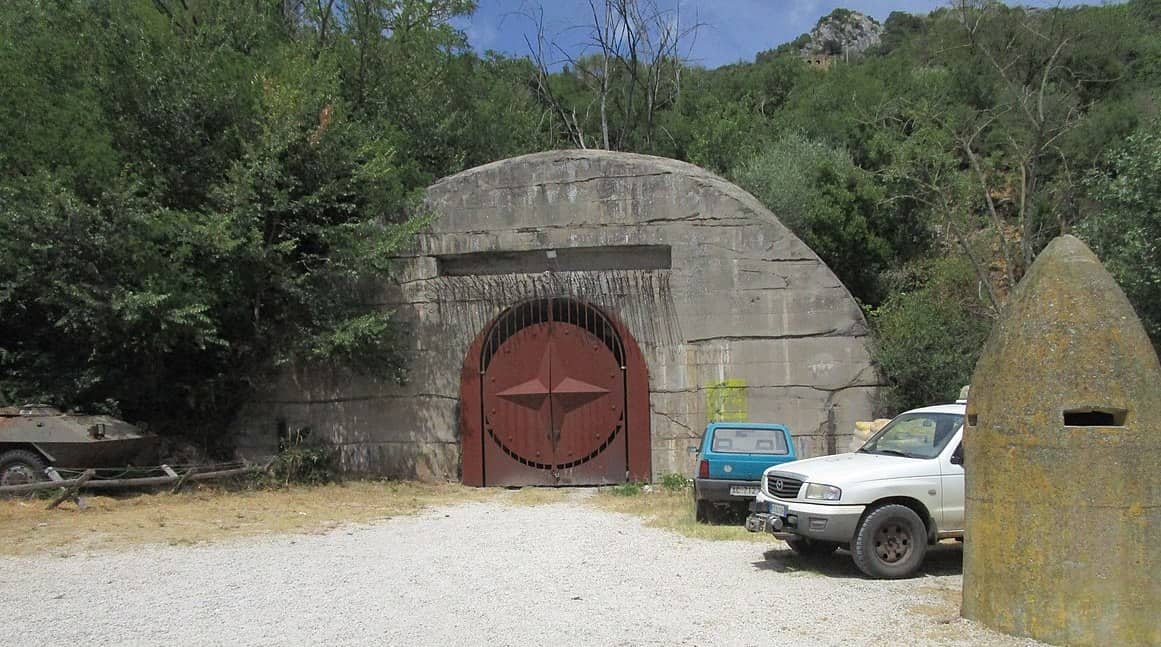
The entrance of the bunker of Monte Soratte.
The Bunker Soratte was built in 1937 by order of Benito Mussolini and remained secret for many years. It has recently been turned into a museum, an historical landmark reminding us of World War II and the Cold War .
Over 4 km of complex bunker tunnels were dug inside the southern slope of Mount Soratte, near the municipality of Sant’Oreste (50 km north of Rome).
The bunker has had different functions over the years: before the war, it was an air-raid shelter for high government officials, and in 1943 Field Marshal Kesselring transformed it into the center for the Supreme Southern Command of the German forces in Italy. After the war it became an Army warehouse and then a nuclear shelter.
The guided tour takes visitors through this maze of concrete tunnels at a depth of 300 meters , using materials patiently recovered from the bunker, making the visit very engaging.
The War Room is not to be missed: it was used by NATO and the Air Force as an operations center, this was the room from where Italy would manage its survival following a nuclear attack .
The bunker can only be visited with a booked guided tour at a cost of €10 per person (thanks to the volunteer association called "Bunker Soratte"). The village of Sant’Oreste, the perfect base for a visit, is about an hour's drive from Rome, but it can also be reached from the capital by bus or train, passing through Viterbo.

4. Museum of Piana delle Orme in Latina
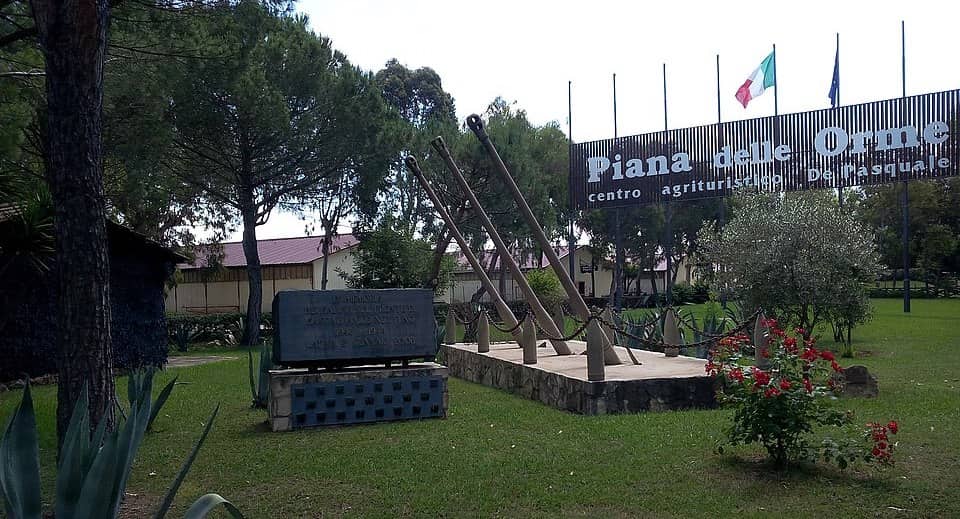
The entrance of Piana delle Orme (PH: Giorgio Pietrocola - Opera propria, CC BY-SA 4.0).
Piana delle Orme is a museum featuring 60,000 local artefacts from the recovery of the Pontine marshes through the World War II and the liberation of Rome.
The gem of the museum is the American M4 Sherman tank , used for the 1944 landing, rescued in the sea nearAnzio in 2002. Roberto Benigni borrowed the tank to shoot the famous final scene of his famous 1997 film Life is Beautiful .
The museum is located in Borgo Faiti (a few minutes drive from Latina) within a farmhouse and was founded in 1997, starting from the private collection of Mariano De Pasquale.
Piana delle Orme is divided into a War Path and a Peace Path. The pavilions are mainly devoted to the display of objects from World War II: military vehicles , dioramas, recordings and sound effects depict how Italy became involved in the war following Mussolini’s declaration of war , the North African campaigns, the amphibian landing of the Allied troops near Anzio and the battle for Montecassino.
The Peace Path focuses on peasant life and the recovery of the Pontine marshes in the 1930s. Not to be missed is the fantastic pavilion dedicated to vintage toys .
The museum is also suitable for children and the ticket costs 13€ pp: ideal time visit is 3-4 hours. After the visit, you can buy vintage gadgets from the museum shop or have lunch at the farmhouse restaurant.
3. Montecassino Abbey
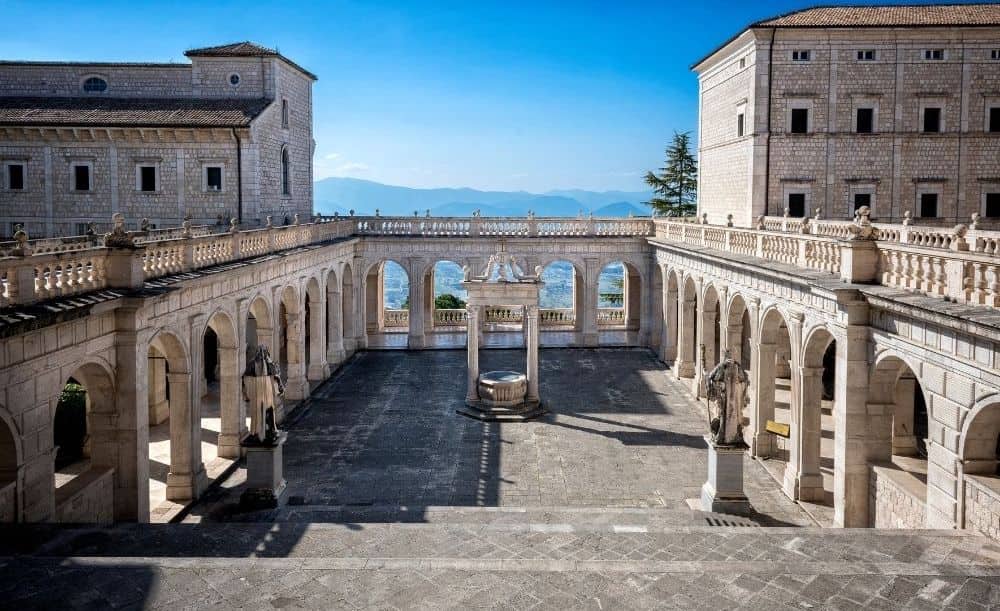
The cloister of the abbey with its scenic view.
Perched at 516 metres, the abbey of Montecassino is a Benedictine monastery founded in 529 a.C. from Saint Benedict himself.
Montecassino is the second oldest monastery in Italy (after Santa Scolastica in Norcia). Located near Cassino , south of Lazio region, this majestic abbey boasts a museum, a cathedral, an elegant Renaissance cloister and a spectacular panoramic view .
In mediaeval times, Montecassino was an important religious and cultural landmark . The abbey experienced many turbulent events , including looting (from the Lombards and Saracens) and earthquakes, before becoming the museum we know today.
In 1944, the abbey also witnessed one of the most terrible battles of the Italian front.
The Allies mistakenly believed that German troops were entrenched behind the mighty walls of the abbey, and so they mercilessly bombed the building, razing it to the ground and killing many civilians refugees there. In the useless attack to conquer the abbey, thousands of American soldiers were killed.
The ancient codices of the abbey have been saved from destruction, even though it is thought that some of them found their way to Herman Göring as a birthday gitf.
The abbey was fully rebuilt from its ashes in the aftermath of WWII. Today, Benedictine monks still live in the monastery and visitors can still see them around.
If you have a car , you can reach Cassino in about 2 hours from both Rome and Napoli. Taking the train is also a good option. The admission to the cloister and the cathedral is free , while the entry for the museum is only 5€.
2. The Liberation Museum and the Ghetto of Rome.
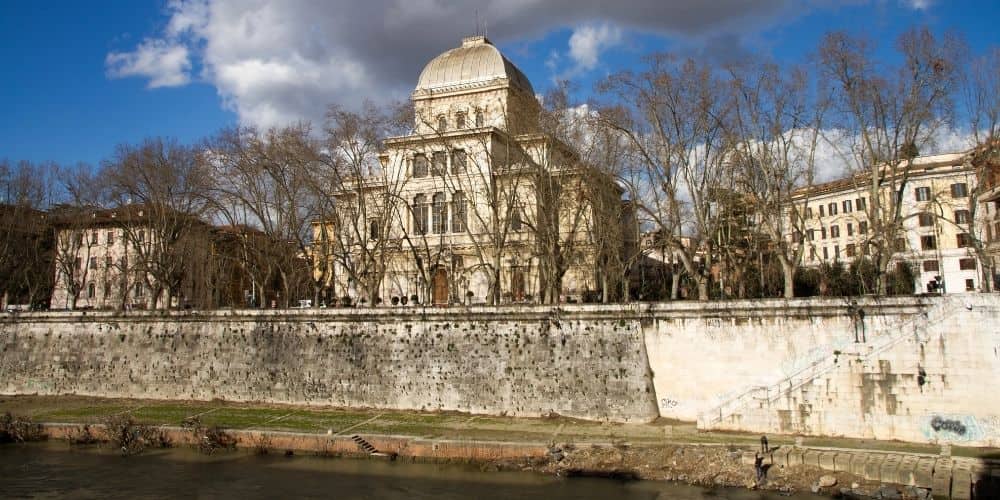
The Great Synagogue of Rome on the river Tiber.
Every corner of Rome is a window on a different time o f history: the years of World War II left deep scars , both in the urban planning and in the soul of the Capital.
Best site to start knowing more about WWII in Rome is the Museo della Liberazione ("Liberation Museum"). The museum is open every day and it's free of charge: you can find it at the famous address of Via Tasso 145. This building is sadly known as the place where the Roman anti-fascists were detained by the Nazis.
The Liberation Museum is the perfect place to keep the knowledge of these tragic memories alive for the new generations , thanks to its collection of original documents and the restoration of the cells used by the Germans for tortures .
The district of San Lorenzo is close to the museum and it's the area of Rome that suffered the most from the bombings of July '43 . The many victims of those days are commemorated in the “Parco Caduti" (or "Park for the Fallen of 19 July 1943").
In the Sant’Angelo district, on the other hand, visitors can find the Ghetto of Rome , the second oldest ghetto in Italy. This area of the capital is appreciated by tourists and locals alike for its cultural vitality and for its original restaurants offering Roman-Jewish cuisine (try the famous Giudia artichokes if you are around).
You should visit the Great Synagogue of Rome ("Tempio Maggiore") a wonderful synagogue facing the river Tiber. It's a landmark for the local Jewish community, also housing the Jewish Museum of Rome. If you walk through the streets of the Ghetto, keep your eyes open for the so called pietre d'inciampo (or " tumbling blocks "), small blocks that recall the name of the citizens deported to lagers by the Nazi-fascist forces.
1. Via Rasella and the Fosse Ardeatine Memorial in Rome
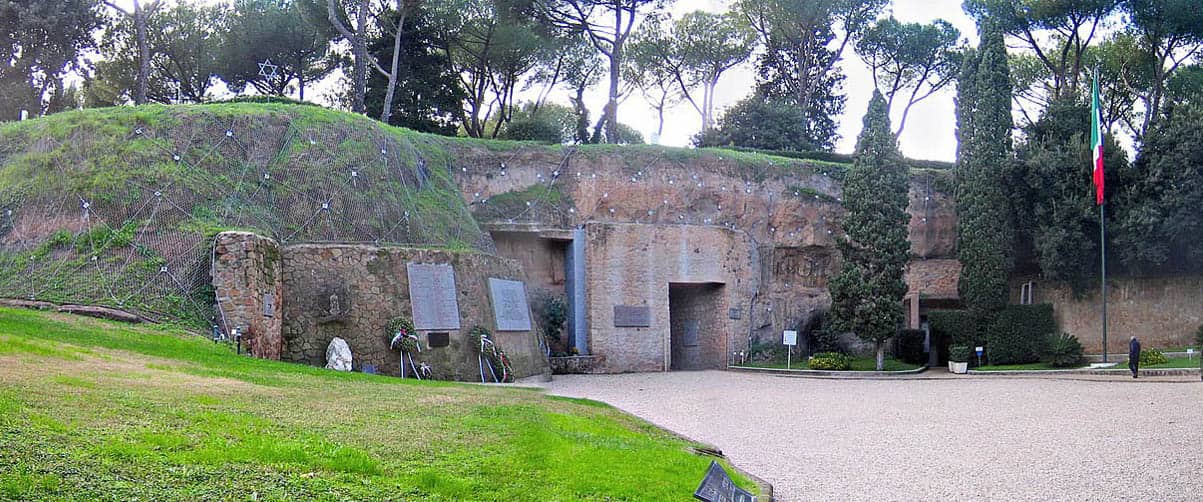
Entrance to the monument for the Ardeatine cave massacre (PH: By antmoose - Flickr, CC BY 2.0).
To complete our journey, we recommend visiting two Roman war landmarks: Via Rasella and the Memorial and the Museum of the Fosse Ardeatine .
Via Rasella is the site of one of the most important partisan actions, a bomb that exploded at number 139 hitting a Nazi-Fascist unit on March 24, 1944. On the walls between via del Boccaccio and via Rasella, you can still see the marks of the German machine guns firing in response to the attack.
The Nazis reaction was the retaliation of the Fosse Ardeatine , where 335 innocent citizens were killed in the quarries named "Fosse Ardeatine", later blown up with dynamite to cover their tracks.
This shrine was built in 1949 and includes the massacre caves and the mausoleum where the bodies are buried. The visit to the Fosse Ardeatine is a touching and highly educational experience , to keep alive the memory of the war.

We recommend


19 WW2 sites in London to visit – explore the city’s historic wartime locations
History lovers looking for WW2 sites in London will find a wealth of museums and sites at their disposal. It’s probably not the sole reason people will visit London, but if you enjoy learning about World War 2 you’ll find plenty there to keep you occupied.
Having a son who loves learning about World War 2 we’ve almost always sought out places to learn more about it and being in London was no different. Each time we go we find something else interesting to explore!
If you’re an enthusiast as well and you’re visiting London you’re in luck because there are a host of WW2 things to see in London . As well as museums you’ll find a number of memorials in the city centre dedicated to those who served.
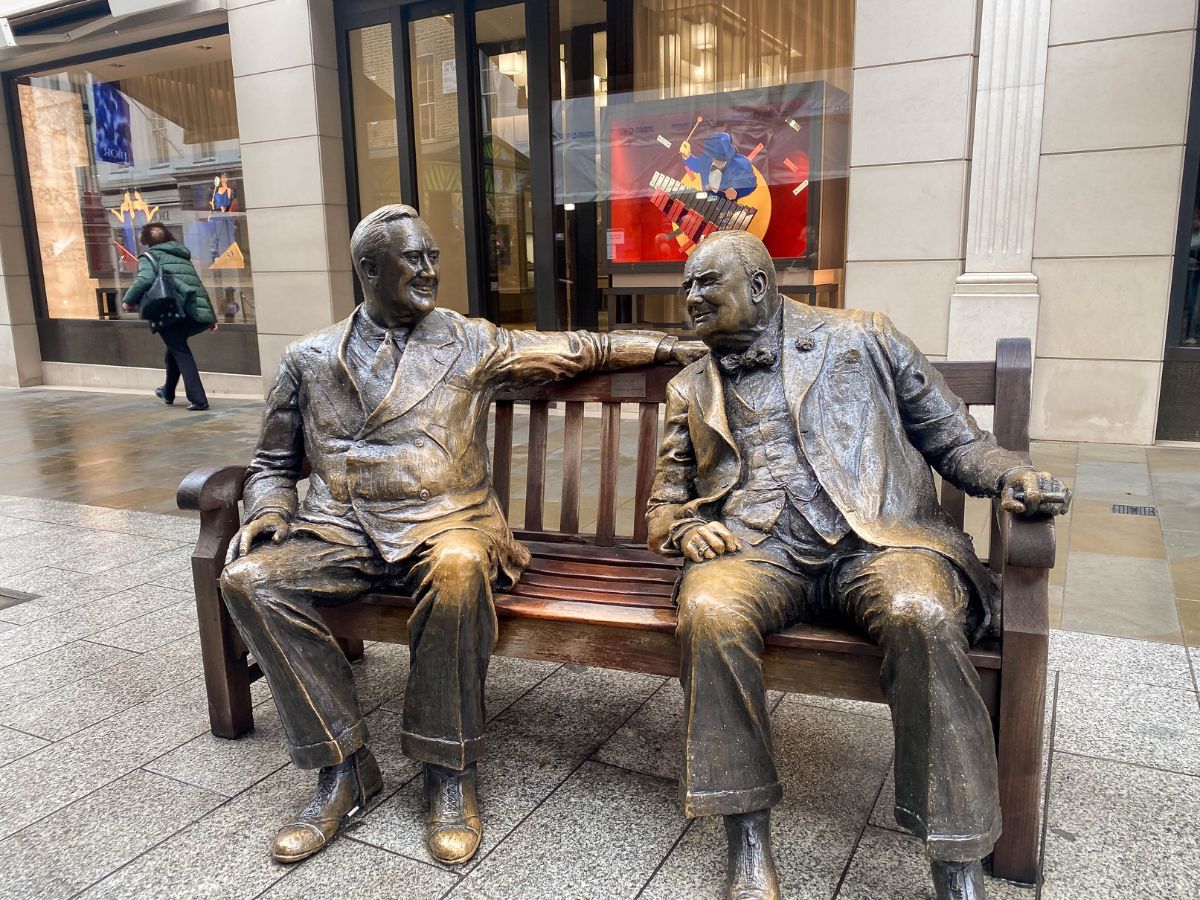
This article probably contains affiliate links. This means that if you buy or book after clicking, I may get a commission at no extra cost to you. Thanks!
These are by no means just for the history buffs amongst us but they can be great for those with just a passing interest and for visitors of all ages.

Thinking about visiting as a family? all of these places tend to have child friendly sections so don’t worry too much about whether they are suitable – most will be. Obviously use your discretion if your child is sensitive to war stories though – mine were never particularly sensitive but I know some friend’s children were and would have struggled!
Our Top Pick

Winston Churchill Guided Tour
This WW2 and Winston Churchill tour will help you see some of London’s most interesting World War 2 sites alongside an enthusiastic guide!
Table of Contents
Walking tours of london’s ww2 sites.
There are some great WW2 tours in London and they are really well worth the time for a number of reasons but the biggest one is enthusiastic guides!
Some walking tours cover the Blitz, some cover Winston Churchill and his time in Politics and sometimes they cover both.
If you want a knowledgeable guide to show you round London’s WW2 sites then take a look at these:
- 3-Hour WW2 Blitz Private Tour
- WW2 Westminster walking tour and Churchill War Rooms
- Wartime London – Guided Small Group Tour
World War 2 Museums in London
You’re always spoilt for choice in London when it comes to museums but even more so when it comes to WW2 museums! Some of these are solely about WW2 and others might just have small sections dedicated to them
1. Churchill War Rooms

Number one on most people’s list to visit when coming to London is a visit to Churchill’s War Rooms. It’s one of the few sites in London that has been preserved from war time.
Inside you can see how Winston Churchill, Britain’s Prime Minister for much of the war, ran the campaigns and strategised. As it lies beneath the streets of London it also provided shelter for him and the workers from incoming bombing raids. You cannot see the war rooms from street level, except from the entrance.
The museum contains:
- a maze of corridors and rooms that held top secret messages and plans
- rooms that looked just as they did during WW2 – the map room is as it was left when war ended in 1945
- exhibitions of artefacts from WW2
- an exhibition about the life of Winston Churchill – he lived to 90 and although is remembered mostly for his WW2 contribution, he also had a part to play in many other world events both before and after WW2
- an audio guide in included in the ticket price – definitely use this to get the most out of your visit
Leave a good couple of hours for looking round the museum and beware that it can get really busy in the summer months. If you can, head there early or late to avoid the crowds and definitely buy your ticket online in advance to skip the queue.
It’s open from 9.30am – 6pm with the last admission being 5pm.
The museum is located in Westminster and the nearest Tube stop is St James’s Park or Westminster
Buy tickets here: Churchill War Rooms
*you might also like: historic walking tour and cabinet war rooms entrance
2. Imperial War Museum London

Just south of the River Thames sees the Imperial War Museum London and as the name suggests, its focus is entirely on war.
So that means that it’s not specifically just about WW2, although there’s plenty there to satisfy that if that’s your sole interest.
The building is pretty impressive and can’t be missed as it has 2 large guns (from the ships HMS Ramillies and HMS Resolution – both WW1 ships) outside.
The history of the Imperial War Museum actually goes back before WW2 as it was set up after WW1 as a place to house the artefacts from the time. It originally was based in Crystal Palace but moved to its current home just 4 years before WW2. It had to be closed for most of the war and even sustained some damage from bombs as well.
In the museum there are some permanent World War 2 exhibitions and some temporary exhibitions too so do take a look at the website before going to check what’s on.
Don’t discount it if you have children, it’s a fantastic London Museum for kids and my children visited lots and thoroughly enjoyed it.
The museum is free to enter and it’s open every day except 24th, 25th and 26th December from 10am – 6pm.
Nearest Tube Stop is Lambeth North or Elephant & Castle
3. HMS Belfast

You can’t miss HMS Belfast, a WW2 naval ship moored on the River Thames and if you ever need to convince any travel companions to go with you on your WW2 museum trips just mention the amazing views of London you can get from here!
You have Tower Bridge, the Tower of London and The Shard as landmarks for your backdrop so perfect for some photo memories or Instagram pictures!
Of course, if you’re here to learn more about World War Two then none of that matters and what matters is what there is to see aboard!
HMS Belfast is one of only 3 surviving ships from the D-Day bombardment of Normandy shores and that period was the last time she fired a shot and is one of very few ships from WW2 left.
When visiting you can explore all the decks of HMS Belfast and get a feel of what life was like aboard. There are also some exhibitions about the history of the ship and what she went through.
HMS Belfast is open every day (excepth the 24th, 25th and 26th December) from 10am – 6pm with the last admission beign at 5pm. You’ll want to allow a good couple of hours for your visit at least. Nearest Tube stop is London Bridge or Tower Hill (this one is the other side of the Thames though you can walk over Tower bridge to get there easily)
Get tickets here: HMS Belfast Tickets
4. National Army Museum
The National Army museum is a free attraction that is located in Chelsea. As you can imagine it covers solely the British Army and the history of it so we’re talking about a lot more than just the second world war.
If military history is something you find interested then I’d highly recommend a visit here. There have many changing exhibitions at the museum so even if you’ve been before you’ll likely see something new.
Check their website to see what’s on.
The National Army Museum is closed on Mondays and is open Tues-Sun 10am – 5.30pm with last entrance at 5pm.
The museum is based in Chelsea and the nearest Tube stop is Sloane Square.
While you’re there, why not visit the Royal Hospital Chelsea – home of the Chelsea Pensioners, veterans of the UK army – there’s a museum here also and it’s perfect if you’re interested in our Armed Forces.
5. The Guards Museum
A museum dedicated to the five regiments of foot guards that protect the monarchy and also that serve in the frontline of war, including WW2.
While no Guards served in the Far East they were quite active in the European battlefields. There’s lots of artefacts, uniforms and stories to uncover in the museum.
Located right in the centre of London this is a great one to add on to your day if you’re doing some sightseeing already. It would combine well with a trip to Buckingham Palace, to Churchill’s War Rooms or to the Horse Guards (see below too)
Entrance to the Guards Museum is £8 for adults and free for under 16s (included in the London Pass ). Nearest tube stop is St James’s Park

6. Household Cavalry Museum
Another museum about specific parts of the army, this time the Household Cavalry . You’ll have no doubt seen the modern members of this regiment on horseback in ceremonies involving royalty.
While Horse Guards can be visited as well (and it should part of any London itinerary) including the changing of the Life Guard (daily at 11am or Sundays at 10am), the museum can show a little bit more including how they were involved in warfare through the years, including WW2.
Great if you’re interested in animals in war and how the horses are trained.
Like the Guards Museum above this one is located in central London and so great for sightseeing days. Nearest tube stop is Embankment or Westminster.
Entrance is £10 for adults and £8 for children (included in the London Pass )

7. National Maritime Museum, Greenwich
Although much of the National Maritime Museum focuses on the general themes of life at sea and some more earlier history, it’s a must see museum if you’re interested in the Navy and battles at sea. You’ll find old uniforms, paintings and all sorts of artefacts on display.
The museum is free to visit which always bumps it up the list in my mind! It’s located in Greenwich and is a great place to spend quite a few hours, especially if you have kids with you as well.
8. RAF museum Hendon
Heading out of Central London and North we have the RAF museum in Hendon – another amazing free museum.
Like the National Army Museum it covers this branch of our Armed Forces and also covers times both pre and post WW2. It contains hangars of planes and aircrafts, exhibitions about the history of the Royal Air Force and different events as well (some have admission charges).
Check the website to see what’s on when you plan to visit. There are many planes on show from all countries, not just RAF aircraft. Some examples of World War 2 aircraft on display are:
- Supermarine Spitfire Vb
- Junkers Ju87G-2 “Stuka”
- Messerschmitt Bf-109E-3
- P51 Mustang
- Lancaster Bomber
- Bristol Beaufighter
- B17g Boeing Fortress
- Curtiss Kittyhawk IV
The museum is open every day from 10am -6pm (March – October) and 10am – 5pm in the winter (November – February). Last admission is 30 minutes before the closing time.
As it’s outside of central London it takes around 30 minutes by tube on the Northern Line – the station you need is Colindale (this is a Zone 4 station). There is also parking at the site if you’re coming from afar and want to take a car. There is a parking charge.
You might also like… 3 Day D-Day beaches Road Trip in Normandy
Other WW2 sites of interest in or near London
9. st paul’s cathedral.

St Paul’s Cathedral was a huge symbol of hope during WW2 for Londoners especially during the Blitz. It stayed standing, although was slightly damaged, even though many of the buildings around it had been bombed. Inside the cathedral there is an American Memorial Chapel which is dedicated to the soldiers of D-Day.
Get tickets here – St Paul’s Cathedral Fast-Track Entrance
10. Mudchute Farm nr Canary Wharf
Ok, so you might be wondering why there’s a WW2 attraction in a random part of East London that’s now a children’s play area and city farm! Well, that’s because it contains an anti aircraft gun that was used to protect the docklands area of London during the war years.
The Ack Ack gun seems an unlikely addition to a children’s area but if you’re looking to get a bit of fresh air while in the city you could definitely head east to here for a bit of a different trip out! Plus you get to see pigs, sheep and a number of other animals – what’s not to love!
Nearest DLR station – Mudchute
You might be also interested in a trip to Dover Castle too which I included in my best castles around London article. Many tours go from London, it’s not too far and is where the Dunkirk evacuation was managed from. We loved our trip there! See tours here .
11. Bletchley Park

Although not in London itself it’s a short train journey from the city and so it’s worth including I think!
Bletchley Park is the location of where the codebreakers worked in WW2 and it had a huge impact on the course of the war. It helped to intercept messages from both sea, air and land battles. Unfortunately I’ve not made it to here first hand but I’m hoping to get ourselves there soon and I’ve heard some great things about the place.
There’s a lot to see in the museum and so well worth it for a slightly different story to be told of what went on in the war.
See their website here for more information. It’s open from 9.30am – 5pm and 4pm in winter (Nov-Feb). Trains go from Euston Station to Bletchley and take around 45 – 60 mins. I like Trainline for booking tickets and find it best to see what options are available.
WW2 Memorials and Statues in London
There are a number of memorials and statues in London dedicated to WW2. Most of them are located within walking distance of each other so it could make a nice afternoon stroll if you wanted to take in them all.
12. Animals in War memorial

Location – North East end of Hyde Park. Nearest tube stop – Marble Arch.
13. Bomber Command Memorial

Location – West side of Green Park along Piccadilly. Nearest Tube stop – Hyde Park Corner
14. The Women of World War II statue

Location – Whitehall. Nearest Tube stop – Westminster
15. Sir Winston Churchill Statue

Location – Parliament Square. Nearest Tube stop – Westminster
16. Monument to the RAF – Battle of Britain

Location – Next to River Thames just up from Big Ben. Nearest Tube stop – Westminster
17. Royal tank regiment Memorial Statue
Location – Whitehall Place, next to Horeseguards . Nearest Tube stop – Embankment

18. The Cenotaph
Location – Whitehall. Nearest Tube stop – Westminster

18. Allies Sculpture – Winston Churchill & Roosevelt
Location – New Bond Street. Nearest Tube stop – Green Park
Accommodation Options for London WW2 sites
If you want to stay close by to the majority of these sites then I’d definitely recommend the Central London area. It does come with a more higher price tag but you’ll be able to take in most of these sights really easily. Top End – if your budget allows and you want to stay in one of the best areas of London then check out The Berkeley. Even their most basic rooms are simply stunning – check prices out here Mid Range – The Park Plaza Riverbank is on the other side of the Thames to Big Ben but really close to all you’ll need. Some of the rooms have a view of the river and London’s Skyline too. Check the prices of this hotel here . Budget – A little further away in Covent Garden but still very central is the Travelodge Covent Garden. I love Travelodge for no frills hotels and they are often my top choice when finding a London hotel! See the latest price and availability here
London is really easy to get around so don’t feel like you need to stay in the centre, although it is convenient.
Planning a Britain vacation? Join our FREE trip planning community!
Come and join our FREE Facebook group where you can get help with planning your Britain vacation of a lifetime!
🇬🇧💂♀️ London Travel FAQ 💂♀️🇬🇧
Do I need insurance for traveling to London?
YES! I always recommend people take travel insurance when exploring the world!
Check Travel Insurance Master for quote comparisons from different providers.
Do I need a car for visiting London?
NO – If you’re just visiting London then a car is not recommended and can be more of a hindrance than a help.
If you plan to explore more of the UK then I recommend DiscoverCars to compare car rental prices
How to book accommodation in London?
For hotels I recommend Booking.com
For apartments and cottages check out VRBO
Will my phone work in London?
Perhaps – it depends if you have roaming enabled and beware this can be an expensive way to use your phone.
If you need a SIM for use in the UK I recommend GiffGaff which you can get and set up before traveling.
What’s the best guidebook for London?
I really like the Lonely Planet Guidebooks
Where to get flights for London
Expedia is my first port of call for finding cheap flights to London.
Do I need a visa for London?
Many countries don’t need a visa for visiting England as tourists (USA, Canada, Aus, NZ and Europe) – it’s always best to check first though .
Pin for later!
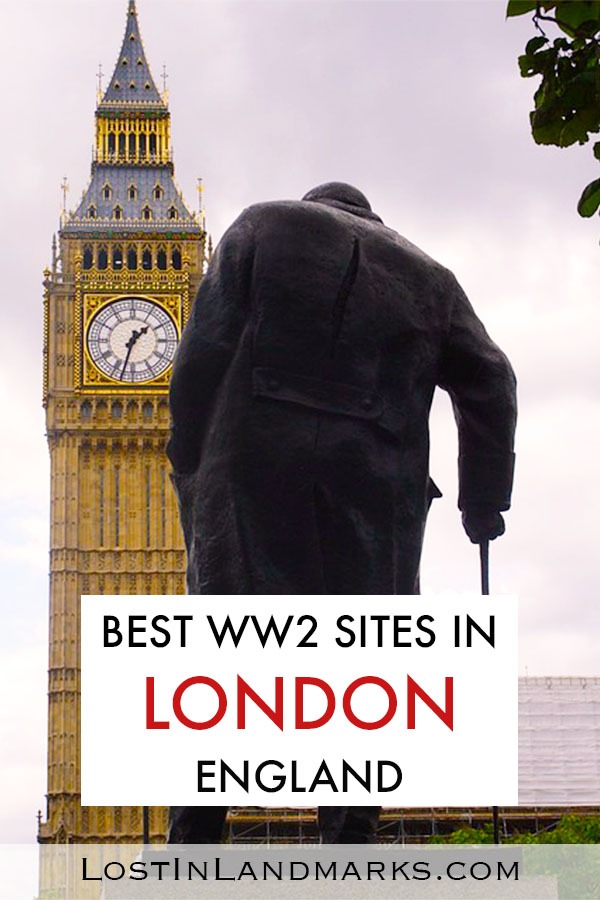
Kirsty Bartholomew
2 thoughts on “19 WW2 sites in London to visit – explore the city’s historic wartime locations”
Great article Kirsty! Extremely helpful information – thanks! Just to let you know, the App, StatueFindr includes specific categories dedicated to War Memorials, The British Army, The Royal Air Force and The Royal Navy.
Thanks so much Grace – yes I need to download and use your app for my next visit to London in a couple of weeks!
Leave a comment Cancel reply

- Travel Guides
- Nightlife Guides
- Food Reviews
- Destinations
- Itineraries
3 Important Japanese World War II Places To Visit In Tokyo
Aug. 20, 2013 by Matt van Vuuren
Understanding history is essential to grasp the dynamics that have shaped pivotal events. My visit to the Yasukuni Shrine and the Yushukan War Memorial Museum in Tokyo was an insightful exploration into Japan's extensive military heritage. The Yasukuni Shrine, with its comprehensive record of over 2.4 million individuals, starkly illustrates the broad impact of wars from the Boshin War through World War II.
- What: Tokyo War Museum & Yasukuni Shrine
- Why: Educational experience on the military history of Japan
- Where: 3-Chome-1-1 Kudankita, Chiyoda, Tokyo [ Map ]
- Hours: 9:00am - 4:00pm
- Price: ¥800 Yen ($7.25 USD) per person
- Travel Itinerary: 7-day Tokyo Itinerary for an amazing Tokyo trip
- Related: Yamato Museum in Kure for world's biggest battleship
Buy Tickets for Tokyo

The Yasukuni Shrine in Tokyo, established by Emperor Meiji , stands as a solemn testament to Japan's military past, initially commemorating those who perished serving the Empire of Japan during the Meiji Restoration. Over time, it has expanded its memorial to include 2,466,532 individuals who participated in conflicts from the Boshin War in 1867 through to the end of World War II. This shrine meticulously records their names, origins, birthdates, and places of death.
- Yamato Museum in Japan: World's Biggest Battleship Ever Built in 1937
- History of Tokyo at Edo-Tokyo Museum
Tokyo Map Download
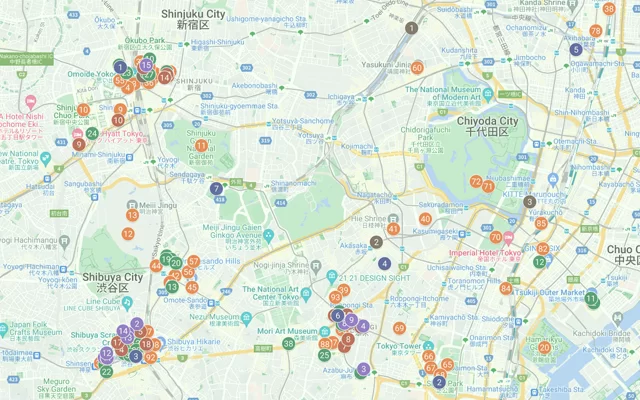
Best Places in Tokyo
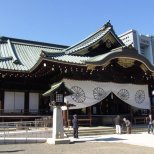
1. Yasukuni Shrine
A notorious shrine across from the Emperor's palace, often the subject of controversy, pays tribute to those who lost their lives in service of the Empire of Japan.

2. Yushukan Museum
Japanese military and war museum located within Yasukuni Shrine. Including a large collection of model battleships, tanks and kamikaze planes. Entrance fee is ¥800 ($7.25 USD)

3. Edo-Tokyo Museum
Mesmerizing elevated museum with a detailed section on Tokyo during World War II
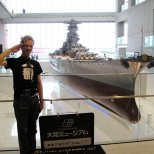
4. Yamato Museum
World's biggest battleship was built by Japan. You can visit the museum in Kure to see a 1/10 scale model of the ship. Entrance fee is ¥500 ($3.50 USD)
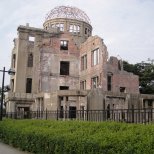
5. Hiroshima Peace Memorial Museum
Dive deep into World War 2 history in Hiroshima by visting the Atomic Bomb Dome and the read testimonials of the A-Bomb survivors.
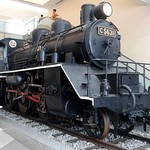
The main sanctuary of the shrine, the Yasukuni Honden, is specifically dedicated to the souls of those who died in service to the Empire of Japan . This dedication aligns with its founding purpose by Emperor Meiji, reflecting the nationalistic spirit of the era and the emperor's intent to honor the fallen warriors of Japan.

Adjacent to the Honden, the Yasukuni Chinreisha shrine presents a broader commemoration. It honors not only the Japanese soldiers of various historical epochs, including the Tokugawa Shogunate and the Republic of Ezo, but also individuals from foreign military forces such as the British, American, Chinese, Korean, and Southeast Asian armies, showcasing a more inclusive approach to remembrance.

Within the shrine’s precincts lies the Yushukan War Memorial Museum , an extensive repository of Japanese military history. The museum showcases a range of artifacts and documents that narrate the story of Japan's military engagements from the Meiji Restoration to the devastating end of the Pacific War, offering visitors a comprehensive view of Japan's martial legacy.

A highlight for those interested in naval history is the Yamato Museum in Kure City, near Hiroshima. This museum features a 1/10 scale model of the Yamato, the iconic battleship of the Japanese navy during World War II. The Yamato, with its massive 46 cm Type 94 main guns and a displacement exceeding 70,000 tons, symbolizes the zenith of Japanese naval engineering and ambition during the war.

In Tokyo, the War Museum, established in 1882, claims the title of Japan’s oldest military museum . Despite controversies over its portrayal of Japan's wartime actions and accusations of glorifying the country's militaristic endeavors, it serves as a crucial resource for understanding the complexities of Japan's military history.

Exploring these sites offers a deep dive into the historical and military fabric of Japan, providing a nuanced understanding of the nation's past conflicts and the evolution of its military traditions and capabilities.

After a day steeped in history, a visit to the nearby Tokyo Canal Cafe , in operation since 1918, provides a serene setting to reflect on the day's experiences. The cafe, with its historic charm and tranquil ambiance, offers a moment of respite in the bustling city.

For those planning a trip to Tokyo, delving into these historical sites can be profoundly educational and moving. I recommend complementing this historical exploration with my meticulously crafted 7-day Tokyo Pocket Itinerary , derived from over a decade of personal experiences, to ensure a comprehensive and enriching visit to Japan's dynamic capital.

Book Your Hotel in Tokyo
Related posts for tokyo.
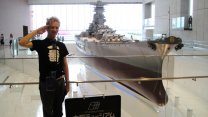
What's New?

FREE Newsletter!
Subscribe to the monthly newsletter and get updates on latest posts.
Who is Matt?

- Privacy Policy

Liberty & Wealth
10 Historic Military Sites Every Patriot Should Visit
Posted: May 18, 2024 | Last updated: May 18, 2024

The United States is dotted with historic military sites that tell the stories of bravery, strategy, and the evolution of our national defense forces. Each site offers a unique glimpse into the periods of conflict that have shaped the nation. Here are ten historic military sites across the USA that will fill you with pride for the country’s military heritage.
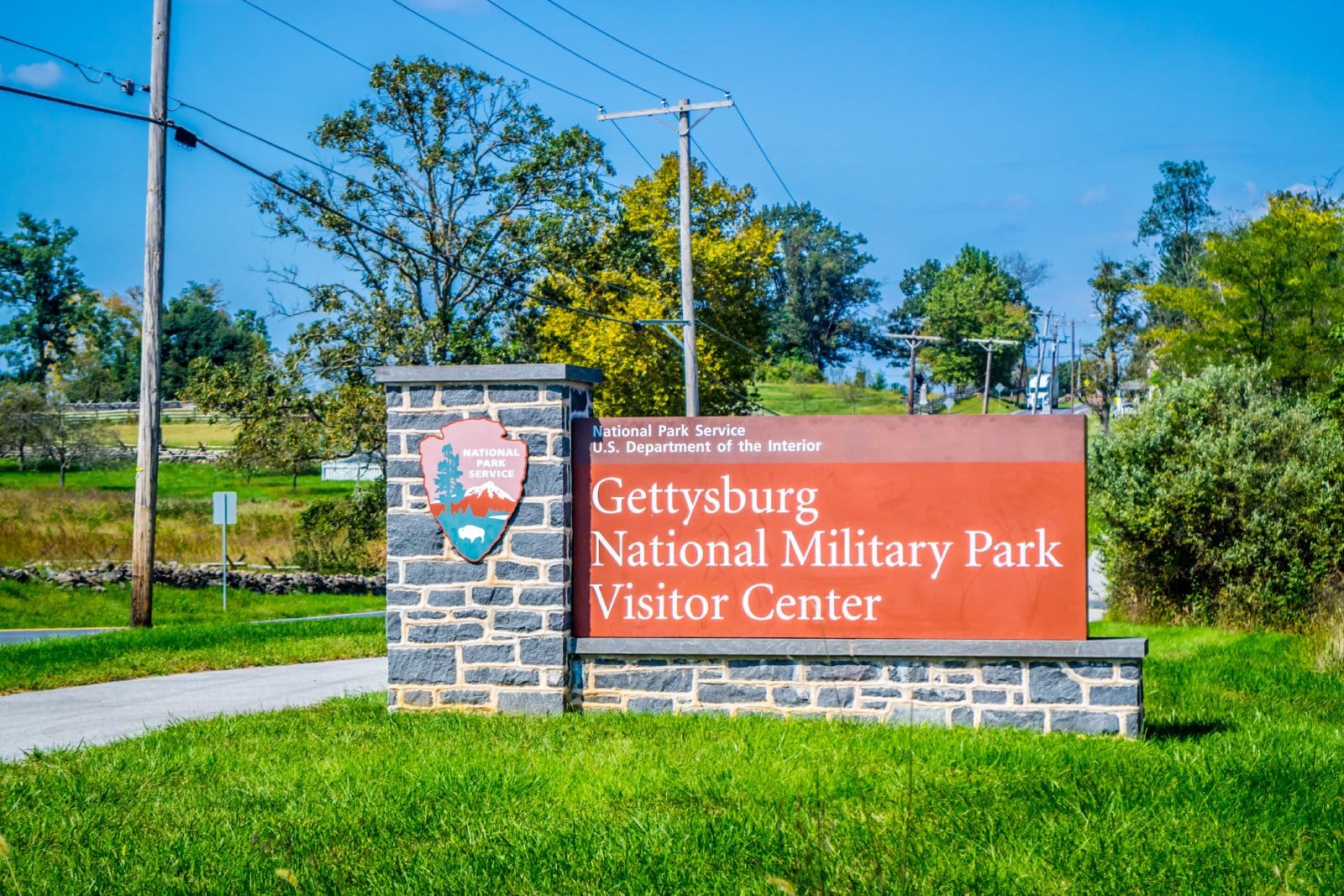
#1. Gettysburg National Military Park, Pennsylvania
The site of the Civil War’s most famous battle, Gettysburg is where President Abraham Lincoln delivered his iconic Gettysburg Address. The park preserves the landscape of this turning point in American history, offering visitors a profound look at the sacrifices made for unity.

#2. USS Arizona Memorial, Pearl Harbor, Hawaii
This memorial honors the lives lost during the December 7, 1941, Japanese attack on Pearl Harbor, which precipitated the United States’ entry into World War II. The sunken USS Arizona remains a somber reminder of the sacrifices of war.
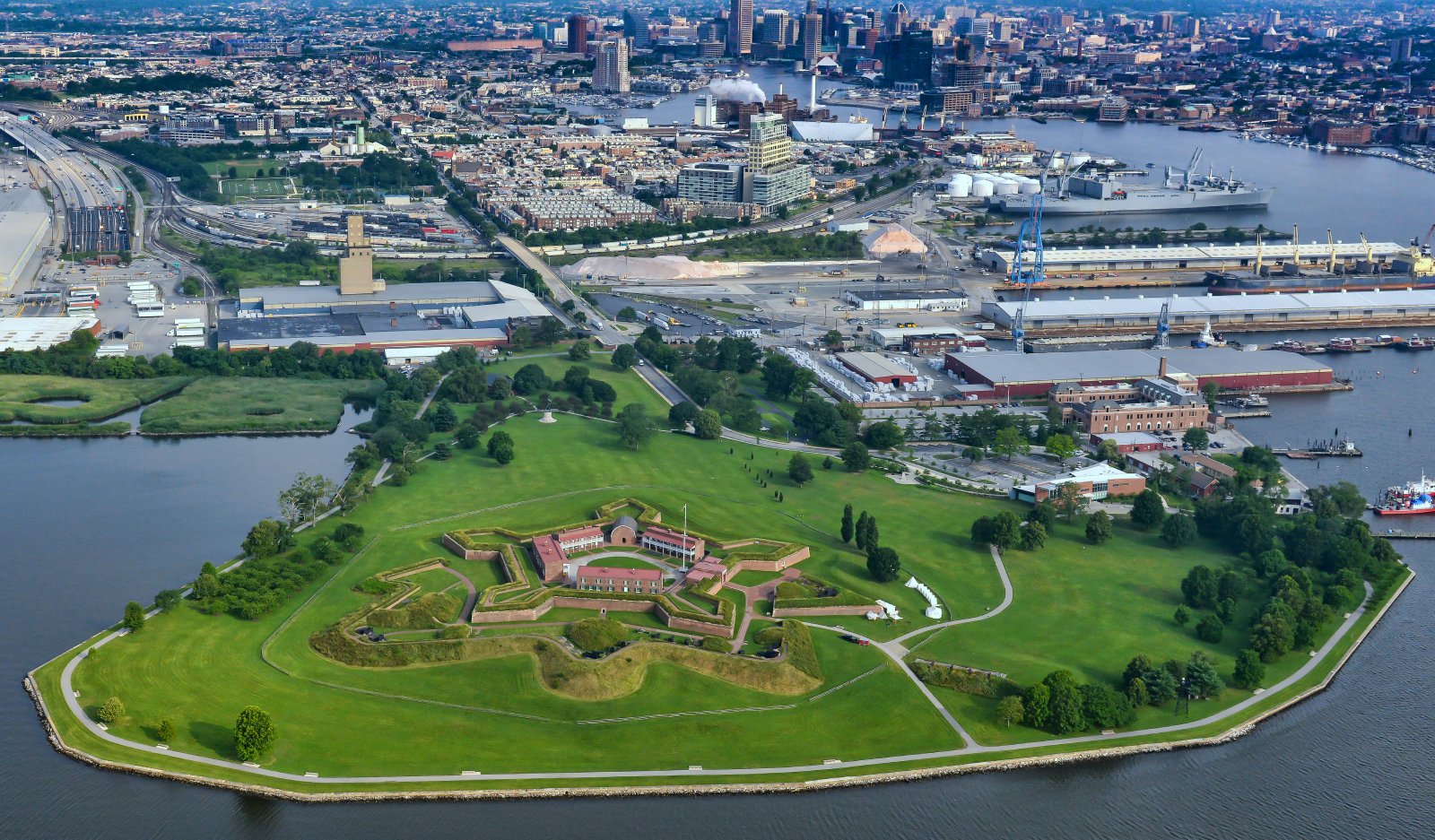
#3. Fort McHenry, Maryland
Best known for its role in the War of 1812 when it successfully defended Baltimore Harbor from an attack by the British navy, Fort McHenry inspired Francis Scott Key to write what would become the national anthem, “The Star-Spangled Banner.”
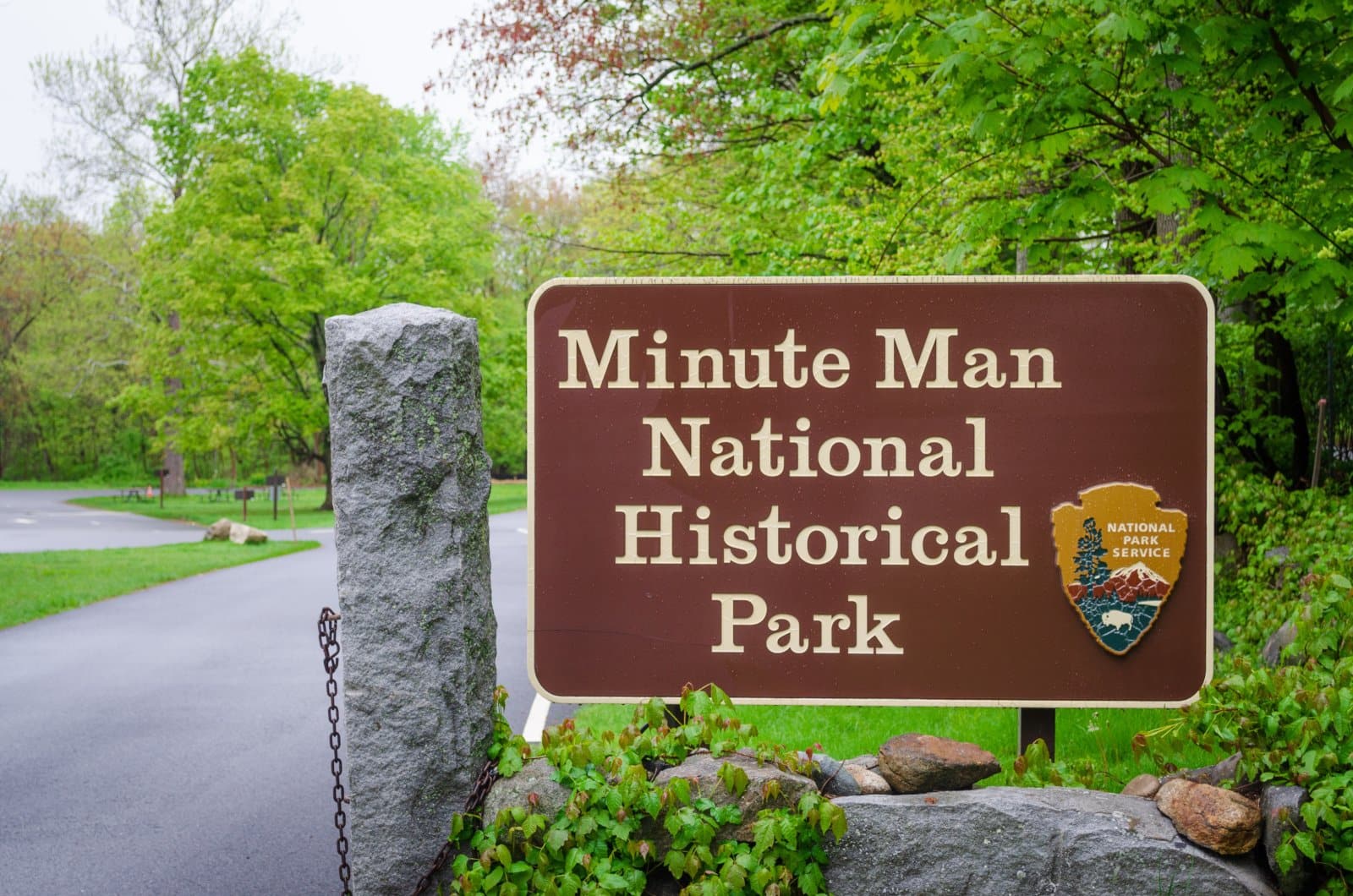
#4. Minute Man National Historical Park, Massachusetts
Visit the battlefields and structures associated with the first battles of the American Revolution in April 1775. The park is a tribute to the minute men who stood ready at a moment’s notice to defend their homes and freedom.
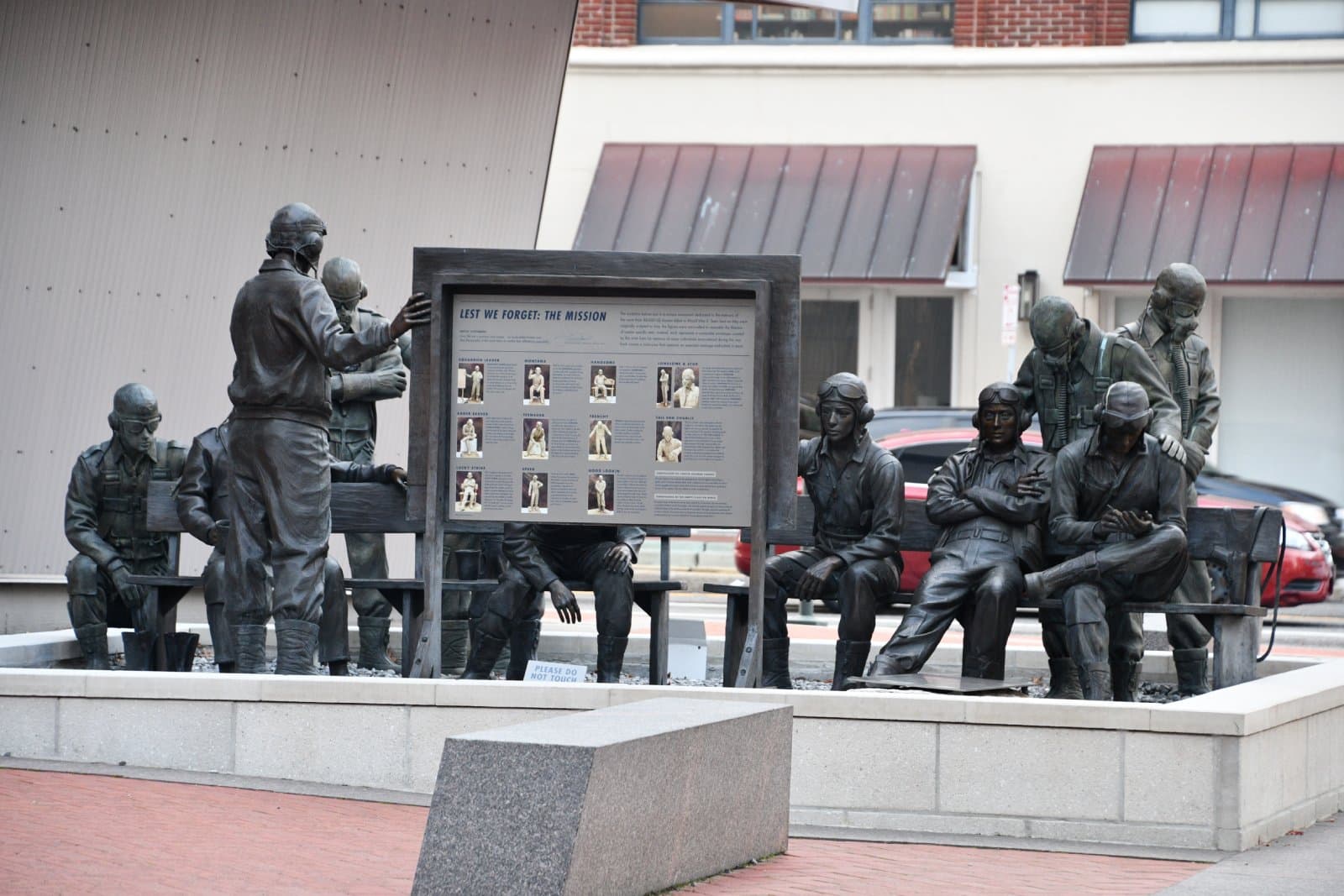
#5. National WWII Museum, New Orleans, Louisiana
Originally founded as the D-Day Museum, this museum offers a comprehensive look at the American experience in WWII, celebrating the American Spirit, teamwork, and the industrial effort of the war years.
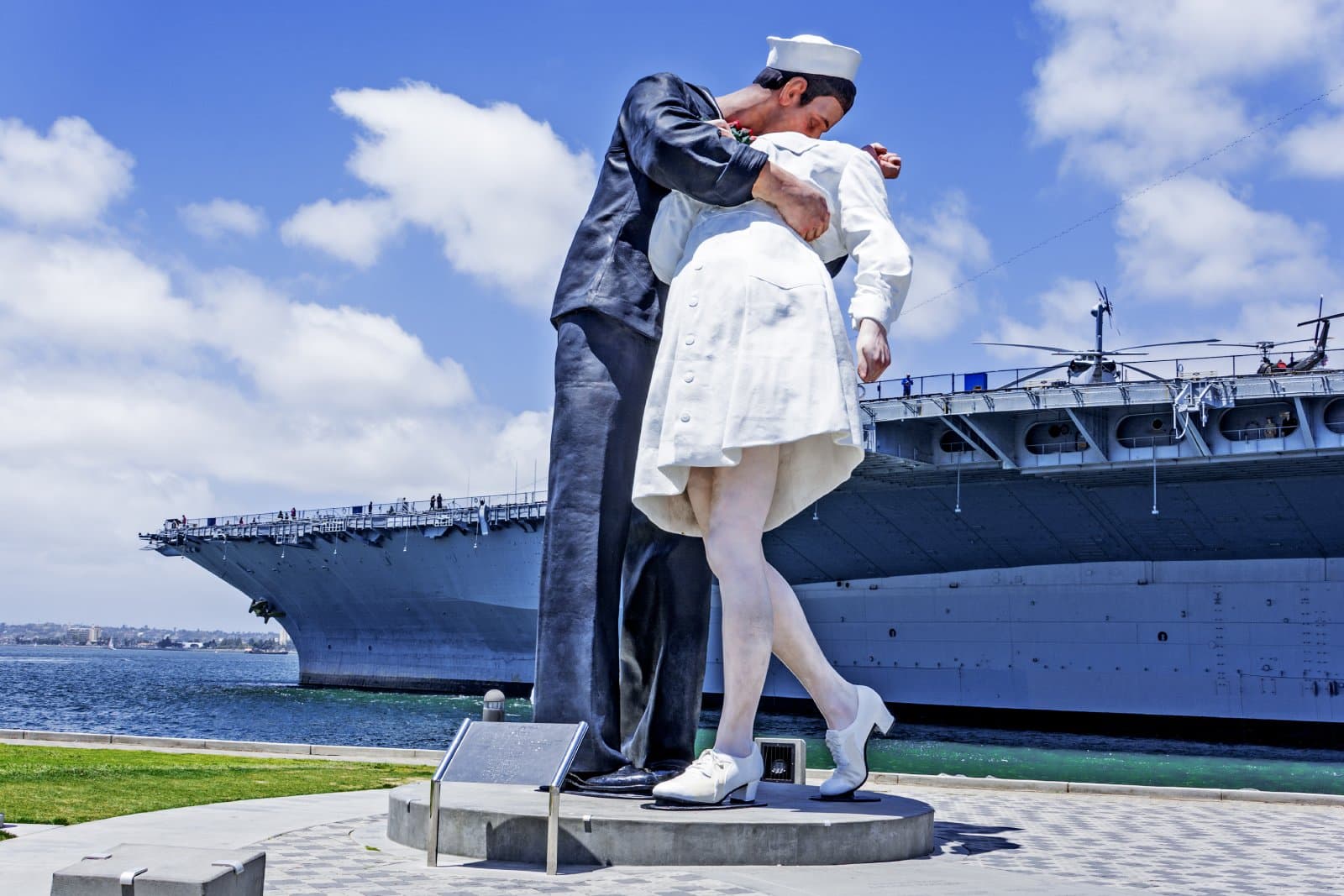
#6. USS Midway Museum, San Diego, California
Located aboard the aircraft carrier Midway, the museum offers a dynamic and enriching experience through numerous restored aircraft, exhibits, and interactive experiences, highlighting the carrier’s role from WWII through Operation Desert Storm.
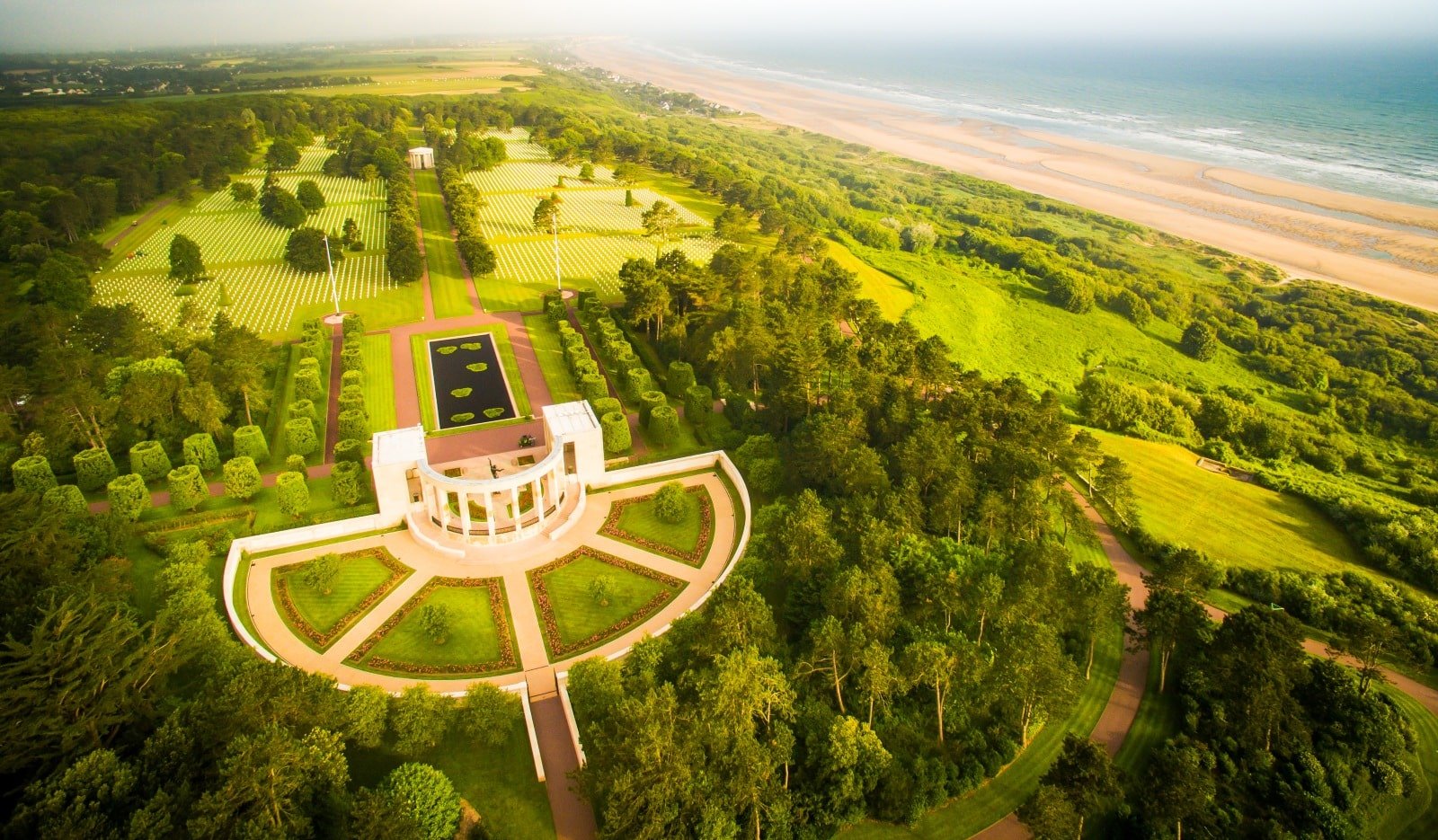
#7. Normandy American Cemetery and Memorial, Virginia
Though located in the U.S., it commemorates the lives of the U.S. military members who died in Europe during World War II. It’s a powerful symbol of the transatlantic bonds that have shaped our military and political history.
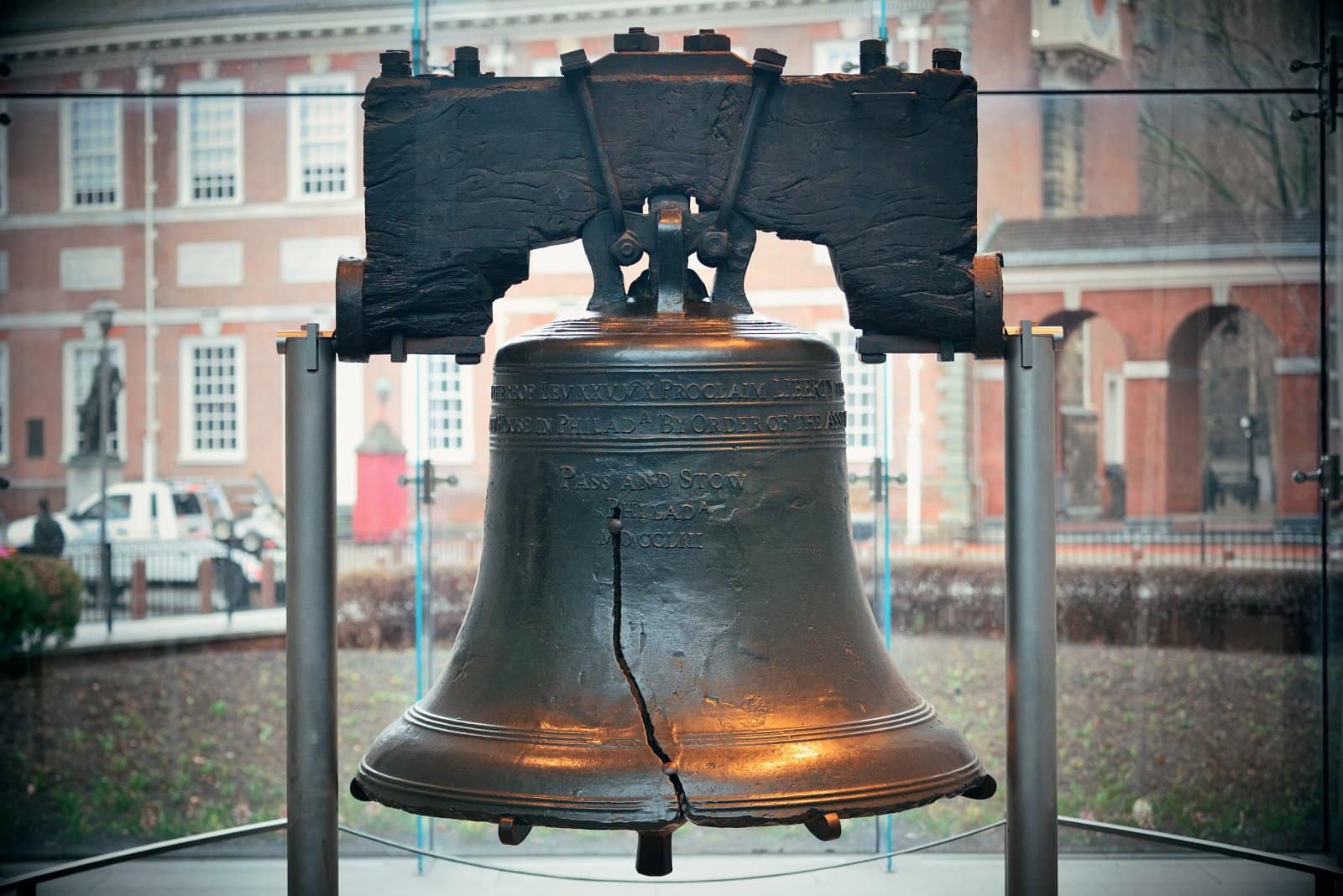
#8. Independence Hall, Pennsylvania
While primarily known as the birthplace of the United States, Independence Hall also has a military history as the meeting place of the Second Continental Congress, which managed the Colonial war effort during the American Revolution.
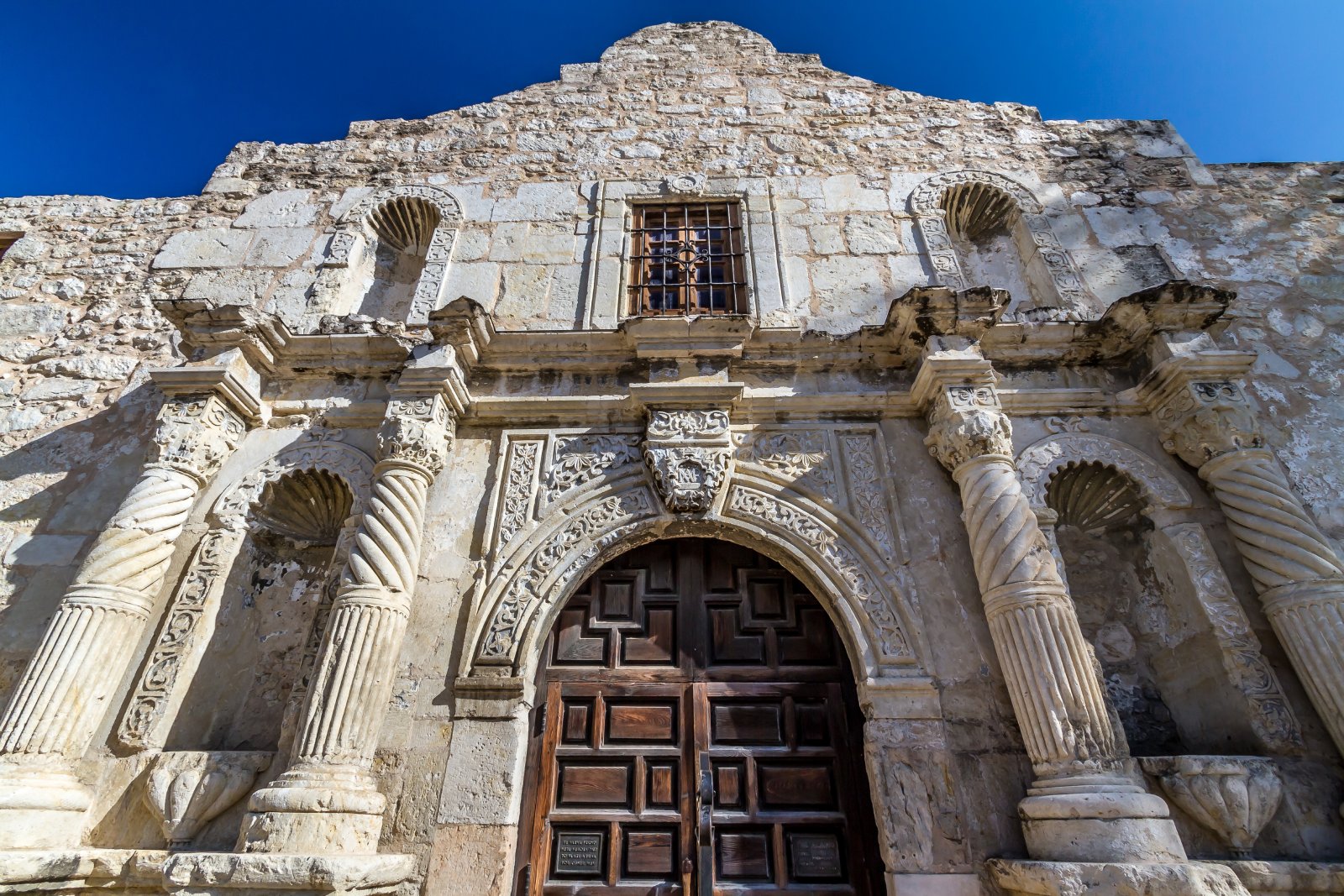
#9. The Alamo, San Antonio, Texas
Remember the Alamo, where a small group of Texan defenders held out for 13 days against the Mexican army in 1836. The site symbolizes courage and sacrifice in pursuit of liberty.
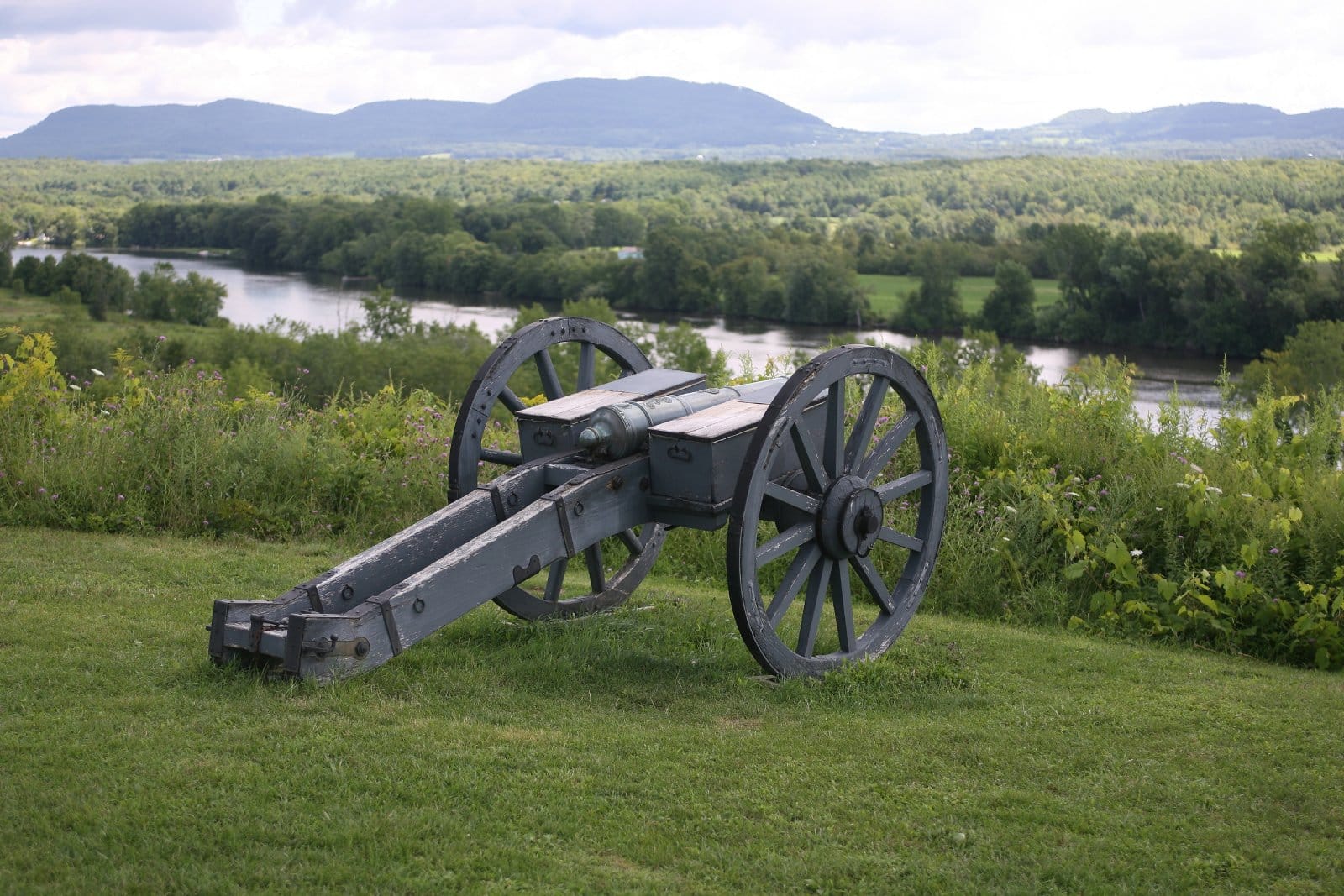
#10. Saratoga National Historical Park, New York
Site of the Battle of Saratoga, this park commemorates the decisive victory that proved to be the turning point of the Revolutionary War, convincing France to recognize and support the United States.

Never Forget
These sites not only offer a journey through critical moments in U.S. history but also serve as memorials to the courage, determination, and sacrifice that defined generations. Visiting these locations provides a profound sense of pride in America’s military past and its ongoing legacy.
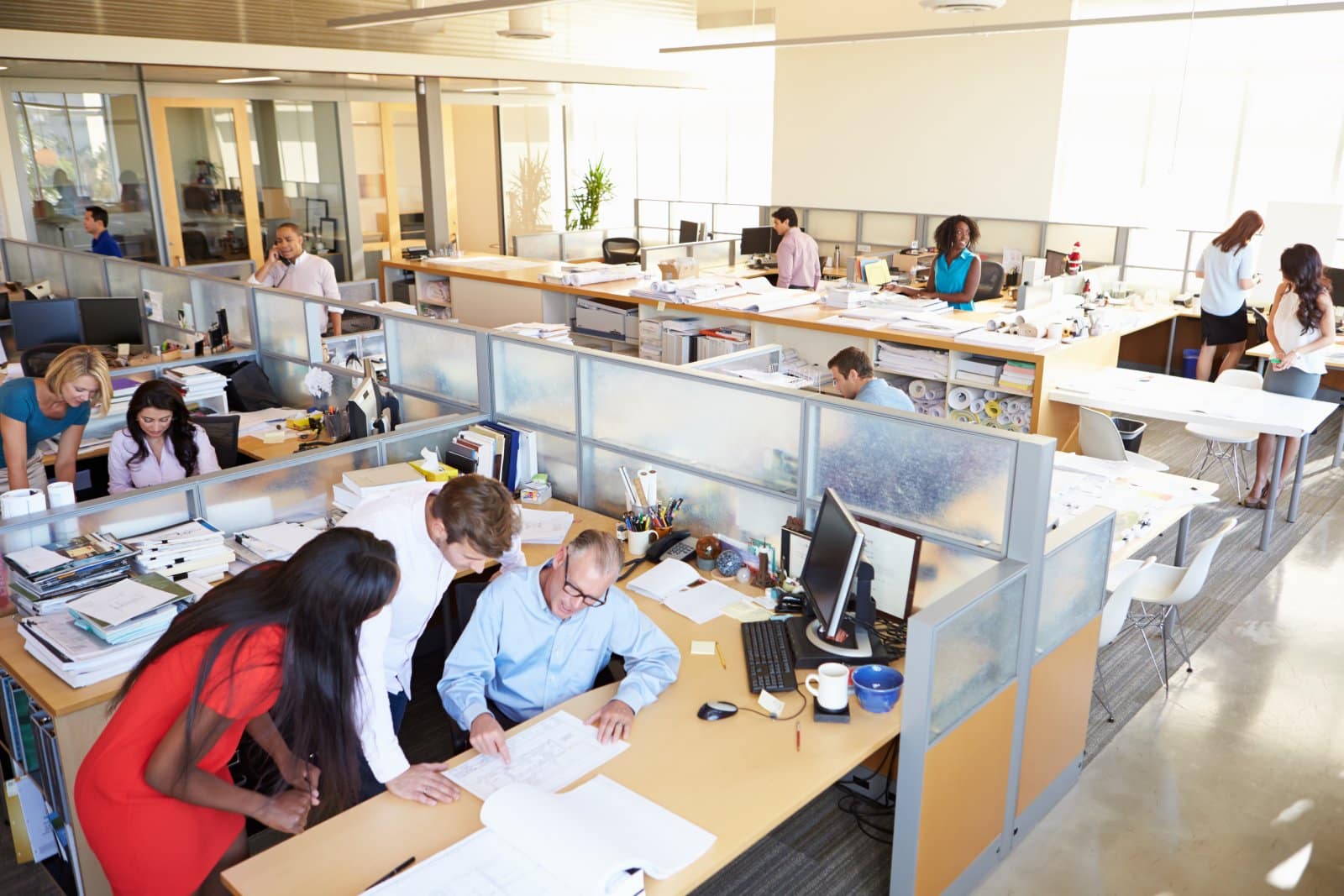
Remote No More: 19 Companies Returning to the Office
As the pandemic wanes, companies are recalling remote workers back to the office, sparking debates on fairness, costs, and convenience. However, there are also notable productivity, coworking, and mental health benefits to consider. Feeling the effects of these changes? Remote No More: 19 Companies Returning to the Office

8 Costco Must Buys and 8 to Leave Behind
Ever wandered Costco’s aisles, questioning if that giant jar of pickles is a real bargain? Or debated buying tires where you get your rotisserie chicken? Welcome to the definitive guide to Costco shopping—a journey to save money, prevent regrets, and offer quirky insights into bulk buying. 8 Costco Must Buys and 8 to Leave Behind
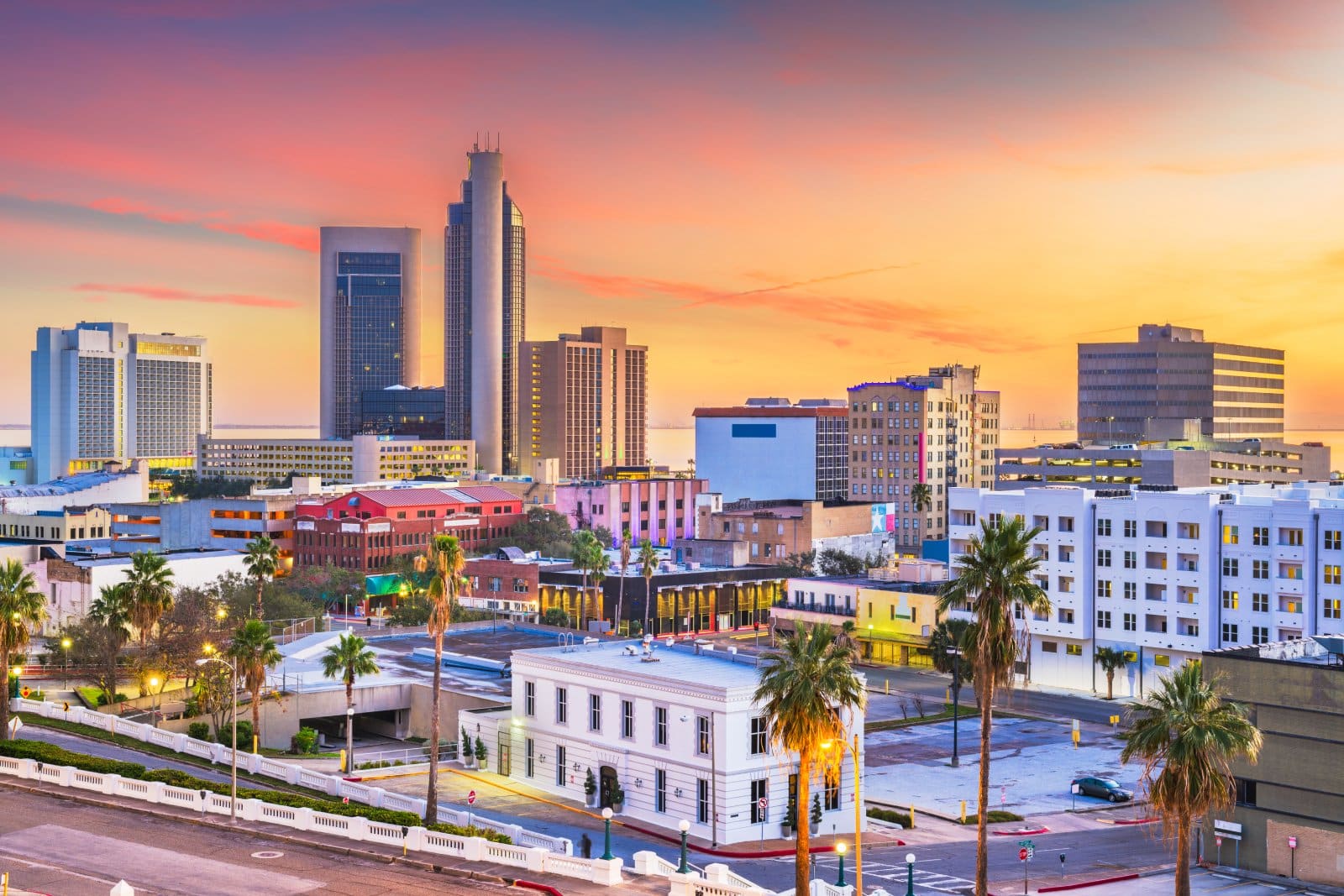
23 Reasons Texas Is the Next Big Thing
Texas is becoming a beacon of opportunity, blending cultural heritage with economic growth. From its landscapes to its industries, the Lone Star State offers a dynamic lifestyle. Here are 23 reasons why Texas stands out, attracting entrepreneurs, artists, tech professionals, and families seeking new beginnings. 23 Reasons Texas Is the Next Big Thing

15 Top Sites to Sell Your Unwanted Goods Besides Craigslist
Selling your unwanted items can declutter your space and boost your income. While Craigslist is popular, there are many alternatives with unique features and wider audiences. Explore these 15 Craigslist alternatives for selling everything from furniture to electronics, finding the perfect platform to turn clutter into cash. 15 Top Sites to Sell Your Unwanted Goods Besides Craigslist

Work from Anywhere: 19 Companies Still Supporting Remote Work
Tired of commuting and craving work flexibility? You’re not alone. Many companies now offer remote work, benefiting both employees and employers. Ever wondered how this shift could enhance your work-life balance? Work from Anywhere: 19 Companies Still Supporting Remote Work
The post – 10 Historic Military Sites Every Patriot Should Visit – first appeared on Liberty & Wealth .
Featured Image Credit: Shutterstock / Songquan Deng.
The content of this article is for informational purposes only and does not constitute or replace professional financial advice.
For transparency, this content was partly developed with AI assistance and carefully curated by an experienced editor to be informative and ensure accuracy.
More for You
Stephen Hawking once gave a simple answer as to whether there was a God
Should You Caulk Your Toilet to The Floor?
Gardener issues warning over the dangers of a common tomato-growing mistake: ‘Why do we all have to learn this the hard way?’
Carpenter's Easy Trick for Keeping Screws Separate Is Nothing Short of Brilliant
Experts share the worst thing you can do in the morning for your sleep cycle
‘It doesn’t work’: This Florida waitress says she tried doing what she loved but couldn’t afford to live — can collecting degrees just leave you feeling burned?
"It Saves Me Roughly $400 A Month": People Are Sharing The New Frugal Habits That They Actually Really Love
Paris Jackson steals the show in black mini dress at party in Cannes
Kamilla Cardoso Has Strong Words About Caitlin Clark, WNBA Growth
Home maintenance expert reveals simple trick that could add years to your washing machine’s life: ‘I never knew this’
Sleep experts say brushing your teeth right before bed is a common nighttime routine mistake — here's why
Supreme Court Issues Overwhelming 8-1 Decision on Second Amendment Preservation Act
This abandoned Greg Norman course near Los Angeles can be yours, but you better bring a mower
Lady Gaga rocks car part on red carpet to delight of fans: ‘Weird Gaga is back’
Priyanka Chopra Proves Peplum Can Be Glamorous in Two Major Gowns
George Karl on why he benched Kobe Bryant in '98 All-Star Game: "A couple of players came to me and said, 'I don't want to play'"
Avoid Using These Toilet Papers If You Want To Keep Your Septic Tank Healthy
Donald Trump's Former Lawyer Pours Cold Water on Bronx Rally Turnout
US assault ship USS Bataan raced at 'best speed' into the Red Sea fight ready to 'punch somebody in the face' if needed, top officers say
California's Wealthiest Billionaire Farming Family Threatens to Tear Down a Small Town
You will be redirected to your dashboard shortly. We will also call you back in 24 hrs .
- Discover The Mesmerising Serenity Of Ross Island In Andaman
20 May 2024
A stunning reminder of India’s colonial past, Ross Island is in the middle of the Bay of Bengal. During the British colonial era, this little island, located near Port Blair, served as the administrative centre for the British. Its overgrown woodlands and decaying ruins are quiet reminders of a bygone age, calling tourists like you to travel back in time and discover a piece of history. The first thing that hits you as you approach Ross Island in Andaman is the strange calm that permeates the area. The smell of tropical flora fills the air, and the sound of the waves gently lapping against the coast creates a calming atmosphere.
Ross Island In Andaman: An Overview
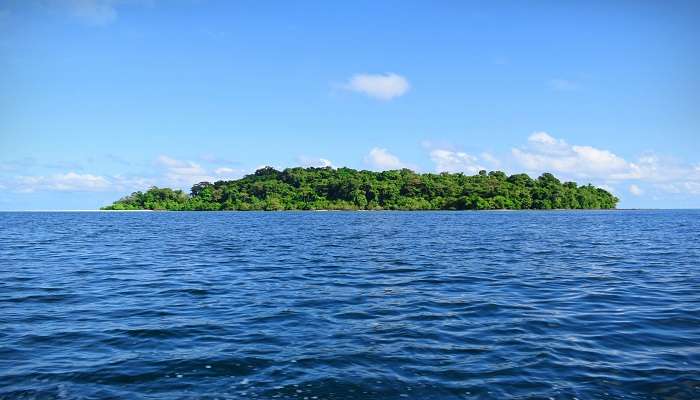
Image Source: Shutterstock
Ross Island is part of the Andaman Islands, specifically the South Andaman administrative district. Its geographical coordinates are 11.675°N latitude and 92.763°E longitude. It is located 3 Km east of central Port Blair, making it easily accessible for visitors. Once known as the “Paris of the East,” Ross Island served as the administrative headquarters of the British colonial establishment in the Andaman and Nicobar Islands during the 19th and early 20th centuries.
Must Read: Cruises To Andaman
Immersing Into The History

Ross Island in Andaman was named after British marine surveyor Daniel Ross. The history of Ross Island dates back to the 18th century when the British established a settlement by building medical facilities. However, following the Sepoy Mutiny of 1857, the island’s purpose changed dramatically. In 1858, the British Raj established the Ross Island Penal Colony to house Indian political prisoners. This penal colony became the administrative centre for the entire Andaman and Nicobar Islands.
During its colonial era, Ross Island witnessed the construction of various structures like bungalows, a church, a bakery, a hospital, and even a swimming pool, catering to the British residents. However, the island’s fortunes shifted in the mid-20th century. 1942 during World War II, the Japanese captured Ross Island in Andaman. While the British presence dwindled, the island held immense significance for Indian independence leader Subhas Chandra Bose. In 1943, during his visit to Port Blair, Bose made a historic gesture by hoisting the Indian tricolour at the Government House on Ross Island, a moment that resonates with respect and admiration even today.
Following the war, the British recaptured the island but eventually abandoned it in the late 1940s. Today, Ross Island is a fascinating reminder of its colonial past, with its now-ruined structures overtaken by nature. It’s a popular tourist destination in Andaman, a testament to the island’s transformation from a penal colony to a place of historical intrigue, offering a glimpse into a bygone era. In 2018, to honour Indian independence leader Subhas Chandra Bose, the Indian government renamed Ross Island to Netaji Subhash Chandra Bose Dweep. This name change reflects the island’s significance in India’s freedom struggle, particularly Bose’s raising the Indian flag there.
Climate And Weather

The climate on Ross Island in Andaman is tropical, characterised by high temperatures, humidity, and significant rainfall all year round. The island experiences warm temperatures throughout the year, with average highs fluctuating between 25°C and 32°C (77°F to 90°F). The summer months from April to June are usually the hottest, sometimes exceeding 35°C (95°F). The winter months from December to February are relatively more relaxed, with temperatures ranging from 20°C to 25°C (68°F to 77°F). The island receives moderate to heavy rainfall throughout the year, with an average annual rainfall of 3180 mm.
Suggested Read: Hotels In Havelock
3 Tourist Attractions To Explore On Ross Island In Andaman
There are several tourist attractions to explore on Ross Island in Andaman. Some of them are:
1. British-Era Buildings And Ruins
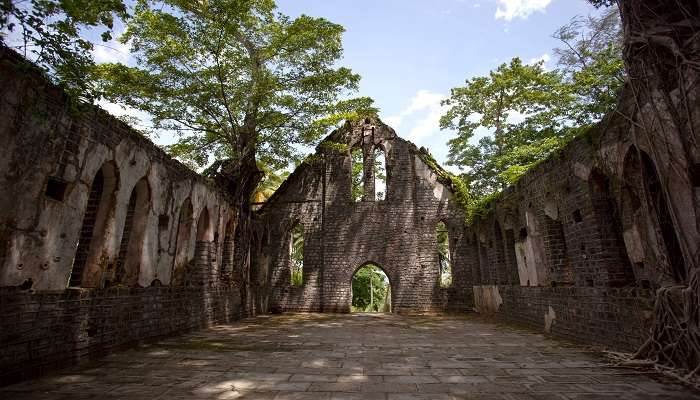
The island’s transformation began in 1788 when the British established their initial settlement in the Andamans. This included the construction of a hospital and infirmary on Ross Island itself. Following the Sepoy Mutiny of 1857, the British incarcerated Indian political prisoners on the island, and Ross Island subsequently flourished as a prominent British colonial settlement for nearly 85 years. During this period, the island witnessed the construction of numerous grand buildings that served as the nerve centre of the British administration. Elegant homes for high-ranking officers, a Presbyterian Church, a bustling marketplace, and a well-equipped hospital were all prominent features of the island. Today, these structures stand in various states of decay, their shells serving as a poignant reminder of the island’s colonial past.
2. Ross Island Museum
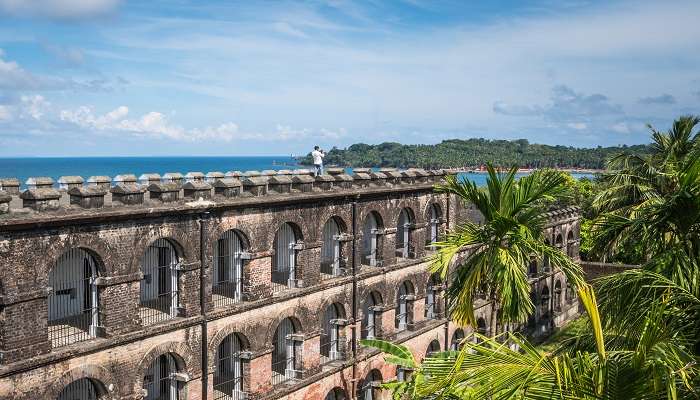
The Ross Island Museum, a quaint establishment, is home to various artefacts and photographs that offer a glimpse into the island’s history and culture. It sheds light on the lives of British officers and the island’s past as a penal settlement. The museum boasts a remarkable collection of antiques and images that narrate the island’s rich history.
Suggested Read: Places To Visit In Neil Island
3. Japanese Bunkers And World War II Remnants
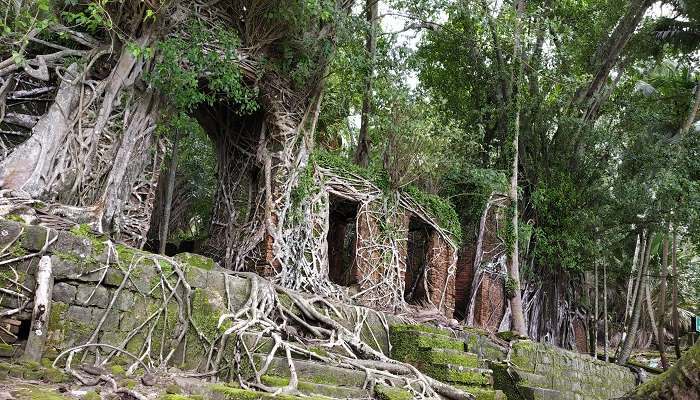
The Japanese Bunkers and World War II Remnants are historical landmarks that bear witness to the past. Built during World War II, these fortified structures served as shelters and strategic points for the Japanese. These remnants narrate tales of fierce combat, tactical defences, and the human toll of warfare.
Best Time To Visit
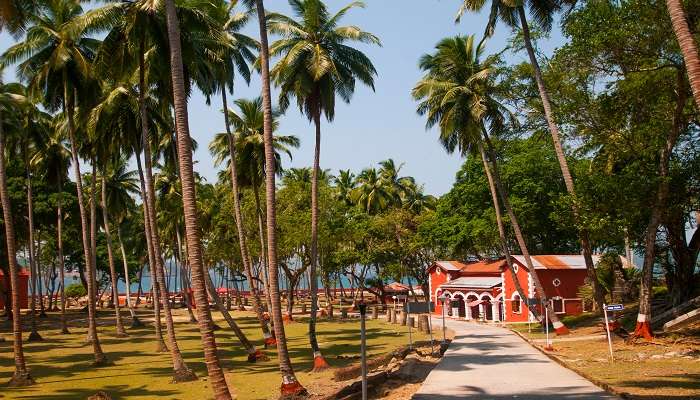
Ross Island in Andaman is best explored from October through March. During these months, the weather is pleasant, and there’s little chance of unexpected rain, which allows for uninterrupted sightseeing. The temperature typically varies between 20℃ and 30℃, perfect for discovering the island’s historical landmarks and natural splendour.
Suggested Read: Resorts In Havelock
How To Get There?

Ross Island in Andaman, located approximately 3 Km east of central Port Blair, is accessible via boat or ferry from various points in Port Blair. Daily ferries depart from the Water Sports Complex and offer combined Ross Island and North Bay Island tours. Alternatively, boats are available from the Phoenix Bay Jetty or the Rajiv Gandhi Water Sports Complex jetty. The Port Blair to Ross Island journey takes about 15 minutes. Private ferries from Phoenix Bay Jetty also provide round-trip options ranging from ₹300 to ₹500.
Further Read: Things To Do In Port Blair
Ross Island stands as a testament to the diverse and fascinating past of the Andaman Islands. Its serene beaches, historical landmarks, and natural wonders create an unforgettable visitor experience. Whether you are a history enthusiast, nature lover, or simply seeking a peaceful getaway, this island promises to leave you spellbound. Are you ready to go on an extraordinary journey and immerse yourself in the magic of Ross Island? So, why wait? Book your trip to Andaman today and unlock a world of adventure, relaxation, and cultural discovery. Plan your trip with your family or friends and create memories that will last a lifetime.
For our editorial codes of conduct and copyright disclaimer, please click here .
Cover Image Source: Shutterstock
Frequently Asked Questions About Ross Island In Andaman
What is Ross Island famous for?
Netaji Subhash Chandra Bose Island, formerly known as Ross Island, is famous for its historical significance and verdant landscapes. It served as the administrative hub during British rule, and the remnants of structures built by Indian prisoners still stand, offering a peek into the past.
Who owns Ross Island?
In southwest Portland, Ross Island sits in the center of the Willamette River. Ross Island Sand and Gravel, a business that has been mining river gravel there since the 1920s, owns the most of it.
How much is the ticket from Port Blair to Ross Island?
The ferry fare from Port Blair to Ross Island varies. The entry fee is 50 for adults (above 9 years) and Rs 25 for children. The boat fare is Rs 100 for all.
How much time is required for Ross Island?
A trip to Ross Island typically takes about 2 to 3 hours. This gives you enough time to explore the ruins, watch the light and sound show, and appreciate the natural beauty.
Why is it called Ross Island?
The island was named Ross Island after Daniel Ross, a British marine surveyor. In December 2018, it was renamed Netaji Subhas Chandra Bose Island in honour of the Indian freedom fighter Netaji Subhas Chandra Bose.
People Also Read:
Philippines Islands Ibo Island Havelock Island
Recent Posts

Guide Singapour En Juillet: Pour Visiter Une Destination Impeccable, Propre Et Moderne

Top 6 Places To Visit Near Colva Beach For An Additional Joy

कर्नाटक में घूमने के लिए सबसे अच्छी जगहें जो आपको पूरी तरह से मंत्रमुग्ध कर देंगी
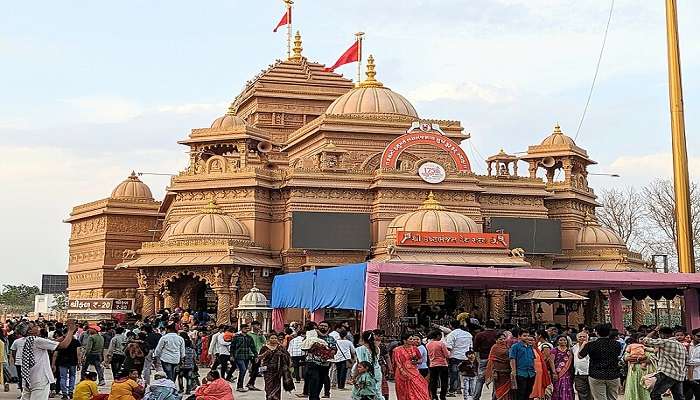
6 Reasons Why Sarangpur Hanuman Mandir Is A Must-Visit Destination
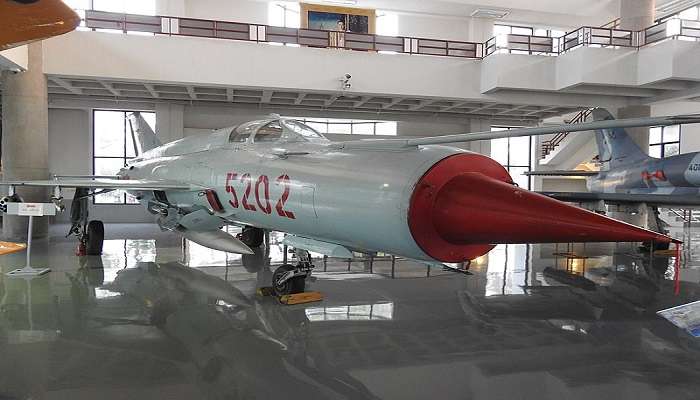
Visit The Royal Thai Air Force Museum For A Fascinating Dive Into Aviation History
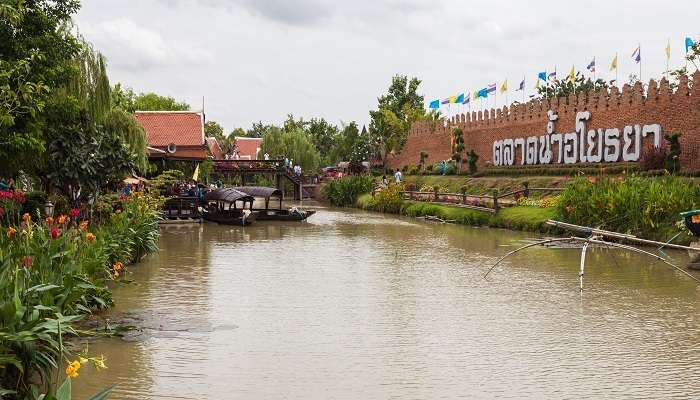
Taling Chan Floating Market Which Serves As A Delightful Feast For Your Sense
Trending Blogs

20 Mysterious Places In India To Visit In 2024 More Bizarre Than The Bermuda Triangle

10 Scariest Roads In India That Are A Driver’s Nightmare

101 Places To Visit In India Before You Turn 30 in 2024

35 Exotic Places To Visit In December In India 2024 To Enjoy A Surreal Vacation

60 Best Honeymoon Destinations In India In 2024

95 Best Honeymoon Destinations In The World In 2023 For A Romantic Escape!
Best Places To Visit In India By Month
Best places to visit outside india by month.
- TravelTriangle
- Andaman »
- Tour Packages
- Honeymoon Packages
- Family Packages
- Budget Tour Packages
- Luxury Tour Packages
- Adventure Tour Packages
- Group Tour Packages
- Kerala Tour Packages
- Goa Tour Packages
- Andaman Tour Packages
- Sikkim Tour Packages
- Himachal Tour Packages
- Uttarakhand Tour Packages
- Rajasthan Tour Packages
- Tour Packages From Delhi
- Tour Packages From Mumbai
- Tour Packages From Bangalore
- Tour Packages From Chennai
- Tour Packages From Kolkata
- Tour Packages From Hyderabad
- Tour Packages From Ahmedabad
- Kerala Tourism
- Goa Tourism
- Sikkim Tourism
- Andaman Tourism
- Himachal Tourism
- Uttarakhand Tourism
- Rajasthan Tourism
- Hotels in Kerala
- Hotels in Goa
- Hotels in Sikkim
- Hotels in Andaman
- Hotels in Himachal
- Hotels in Uttarakhand
- Hotels in Rajasthan
Sun Packages

Tour Operators
Popular departure gateways, popular destinations.
CALL US TO BOOK
Top Vacation Destinations
- Florida Vacations
- Las Vegas Vacations
- Mexico Vacations
- Hawaii Vacations
- Cuba Vacations
- Jamaica Vacations
- Punta Cana Vacations
- Costa Rica Vacations
Vacation Packages Types
- Disney Parks Vacations
- Disneyland Vacations
- Disney World Vacations
Vacation Packages From
- Vacation Packages from Toronto
- Vacation Packages from Vancouver
- Vacation Packages from Montreal
- Vacation Packages from Calgary
- Vacation Packages from Edmonton
- Vacation Packages from Ottawa
- Vacation Packages from Halifax
- Vacation Packages from Winnipeg
- Vacation Packages from Victoria
Browse Flight Centre's carefully chosen vacation package deals or have us design your cheap all-inclusive, last minute vacation, or luxury holiday to give you the best value on your trip!
Check out some of our awesome cheap vacation package deals here, or call a Flight Centre travel consultant at 1 877 967 5302 for 24/7 Customer Care.
There are few things in life as precious as vacation time and with that, finding the perfect holiday. Whatever your taste may be, beach, city, the luxurious or the value-packed, we've got the perfect getaway for you in Mexico, the Caribbean, USA, Europe, Asia, South America, Africa, Australia, and the Middle East.
Check out some of our awesome cheap vacation package deals here, or call a Flight Centre travel consultant at 1 877 967 5302 , ready to help you 24/7.
Family Vacations
Pack up the kids! There's no better way to reconnect and enjoy some much needed family time than by enjoying a great holiday together. Our selection of family focused hotels and resorts cater to all ages and provide the perfect backdrop to the perfect family vacation .
What sets a great family resort apart from the rest? It's their focus and ability to cater to both the kids as well as you. Amenity-rich and activity-laden family-friendly hotels and resorts provide all the fun for the kids while remembering to pamper those who brought them there. From Disney vacations to Atlantis , we've got you covered.
Wedding, Honeymoon & Romantic Getaways
Looking to say 'I do' someplace exotic? Planning your honeymoon or maybe just looking to get away with someone special? We've got just the thing.
From Wedding and Honeymoon Specialists to experts that know all the top romantic destinations and resorts, couples getaways have never been so fun and easy to book. Be it a Caribbean Luxury Included Vacation with Sandals or an over-water bungalow in Bora Bora, our sexy getaways are designed for maximum fun and relaxation offering the best value on the market, creating sun-kissed memories to last a lifetime.
Budget Vacations
From Florida's beaches and amusement parks, authentic Cuba and non-stop Las Vegas to iconic European city centre stays and charming bed & breakfast getaways, our convenient air inclusive packages put you in the heart of the world's most exciting cities and beach towns, complete with extras to keep the fun and value at a maximum.
A great getaway can mean the theatre and museums to some, great restaurants, shopping and nightlife to others. From fun-filled family destinations to cosmopolitan cultural gems, we've got ultimate adventures to suit just about every taste.
Luxury Vacations
Enjoy the finer things in life? Then you'll love our luxury vacation escapes that put you in the heart of the action in some of the world's most sought after destinations. Take in the beauty of Paris from only the most central hotels or arrive in amazing London at the front of the plane, ready for adventure. Simply put, this is the best of the best.
The Seychelles, Tahiti, Bora Bora and Fiji all evoke exotic images of far-away, unspoiled islands with secluded beaches and the ultimate romantic hideaway.
We are processing your request
Please don't press back or refresh the page while we search.
General election latest: Labour attack Sunak's 'desperate' National Service pledge
Rishi Sunak says he will introduce a new form of mandatory National Service for 18-year-olds if the Conservatives win the general election - but Labour says the "desperate" pledge is "only needed because the Tories hollowed out the armed forces to their smallest size since Napoleon".
Sunday 26 May 2024 00:55, UK
- General Election 2024
Please use Chrome browser for a more accessible video player
General election called for 4 July
- Starmer confirms support for extending voting age to 16
- 'No pneumonia yet': PM laughs off election launch deluge
- Tories deny Sunak taking 'duvet day' on first campaign weekend
- Housing Secretary Michael Gove to stand down at general election
- Sunak doesn't rule out Johnson joining Tory campaign
- PM agrees to take part in Sky News leaders' event on one condition
- Live reporting by Brad Young
Expert analysis
- Beth Rigby: Starmer launched in Scotland but he needs to keep his base
- Tamara Cohen: What the Mail's front page means for the campaign
- Sam Coates: Gove stepping down shows the political winds are shifting
- Sophy Ridge: This is what the Tories don't want to talk about
Election essentials
- Trackers: Who's leading polls? | Is PM keeping promises?
- Subscribe to Sky's politics podcasts: Electoral Dysfunction | Politics At Jack And Sam's
- Read more: What happens next? | Which MPs are standing down? | Key seats to watch | How to register to vote | What counts as voter ID? | Check if your constituency's changing | Sky's coverage plans
The Conservatives would bring in National Service for 18-year-olds, they will announce on Sunday.
In the first new policy announcement of the election campaign, the prime minister has unveiled a plan that would see new adults given the choice of a full-time military placement for 12 months or a scheme to volunteer for one weekend a month for a year.
The placement would be selective - with tests used to decide who is eligible - and involve working with the armed forces or in cyber defence.
Read more from our political correspondent Rob Powell :
At a breakfast with veterans on Saturday morning, Rishi Sunak made light of the wetter-than-hoped election announcement earlier this week.
Standing at a lectern outside Number 10 on Wednesday, the prime minister had to ignore the steady rain as he outlined his plan for the upcoming polling day.
This morning - a sunnier one - he met the group of eight veterans and sat in The Buck Inn, a Wetherspoon's pub on the High Street in his Richmond constituency, where the group were sipping tea and some tucked into breakfasts.
But it was the wet weather that was the subject of conversation...
The Conservatives would introduce National Service for 18-year-olds, it will be announced on Sunday.
Hailed by the party as a "bold new model", the plans would see new adults working in the armed forces or volunteering in their community.
The scheme would be mandatory.
"We have so much to be proud of in the United Kingdom, but we also need to be open and honest about the long-term challenges that our country and our society faces," the party said.
"And one of the problems in our society is that we have generations of young people who don’t have the opportunities they deserve."
Young people would be able to choose from:
- A selective, full-time 12-month placement in the armed forces or UK cyber defence
- Volunteering the equivalent of one weekend per month (25 days per year) in their community with organisations such as fire, police and the NHS as well as charities tackling loneliness and supporting older, isolated people
It has not been confirmed that the 12-month placement option would be paid.
This National Service will provide valuable work experience and ignite a passion for a future career in healthcare, public service, charity or the armed forces, the Conservatives say.
Prime Minister Rishi Sunak said: "This is a great country but generations of young people have not had the opportunities or experience they deserve and there are forces trying to divide our society in this increasingly uncertain world."
What was Labour's reaction?
Responding to the plans, a Labour Party spokesperson said: “This is another desperate £2.5bn unfunded commitment from a Tory Party which already crashed the economy, sending mortgages rocketing, and now they’re spoiling for more.
“This is not a plan – it’s a review which could cost billions and is only needed because the Tories hollowed out the armed forces to their smallest size since Napoleon.
“Britain has had enough of the Conservatives, who are bankrupt of ideas, and have no plans to end 14 years of chaos. It’s time to turn the page and rebuild Britain with Labour.”
UNISON has commented on Sir Keir Starmer's package of workers' rights.
Earlier, the Unite criticised Labour's plans for having "more holes in it than Swiss cheese".
General secretary Sharon Graham accused the party of watering down its policies after rebranding "Labour's new deal for working people" as "Labour's plan to make work pay".
But Christina McAnea, UNISON's general secretary, backed the plans.
She said: "Labour's new deal best illustrates that choice. It will make work fairer and boost the economy too."
She said its measures are "proving popular on the doorstep" and said that "bad employers" will no longer be able to cut corners and costs by exploiting staff.
"An end to dodgy zero-hours contracts, paid travel time for care workers and a new fair pay agreement to help boost recruitment in that crisis-stricken sector too. Plus a wave of bringing public service contracts back in-house to end the profiteering in frontline services. Labour is the only party with a plan to help working families."
The Liberal Democrats are "way more in tune" with young voters than "any other party", their leader has argued.
Sir Ed Davey spoke in Chichester in reaction to Labour's pledge to lower the voting age to 16.
He pointed to his party's position on housing, calling for a ceasefire in Gaza and their pro-European stance as policies that may appeal to younger people.
Sir Ed welcomed Labour's promise to reduce the voting age to 16 but said "bolder" reform is needed to fix the country's "broken" political system.
When asked how the Lib Dems could regain the trust of young voters following the U-turn on their pledge to scrap university fees during the 2010 coalition government, Sir Ed said his party had "fought the Conservatives every single day" during the power-sharing agreement but "weren't able to get everything we wanted".
Under the coalition, university tuition fees were trebled to a maximum of £9,000-a-year from 2012.
Now that Rishi Sunak has called the next general election for Thursday 4 July, the nation is preparing for its first polling day since December 2019.
Here's everything you need to know about the general election and how it's going to work...
Scottish First Minister John Swinney has defended his decision to challenge the sanction ordered against his colleague Michael Matheson.
Mr Matheson drew criticism over a near-£11,000 data roaming bill on his parliamentary iPad.
The Scottish parliament's standards committee backed a 27-day suspension for the MSP.
But SNP leader Mr Swinney said he did not support the cross-party committee’s sanction as one of its members, Conservative Annie Wells, had previously made critical comments about Mr Matheson’s explanation for the bill, which Mr Swinney believes therefore prejudiced the decision.
Speaking to journalists, he said: "I’m not going to have prejudice taken forward in any part of Scottish life, it shouldn’t happen in the Scottish Parliament."
Flight logs appear to show Rishi Sunak used a Tory donor’s helicopter to travel from his Yorkshire home to campaign in London this afternoon.
Online route data shows a helicopter believed to be owned by millionaire businessman Richard Harpin landing in grounds next to Rishi Sunak’s mansion this morning after previously taking off from an airfield 15 minutes’ drive away in Bagby.
It then flew via Nottingham to Central London.
Rishi Sunak has since been photographed campaigning in Wimbledon and Carshalton in South London – two Tory-held Lib Dem marginals.
It comes after Labour accused the Prime Minister of taking a day off in the first week of the election race.
Conservatives denied that saying Mr Sunak was leading "from the front".
On Thursday and Friday he campaigned in all four nations of the UK, using a plane to visit Wales, the North of Scotland and Northern Ireland.
The Prime Minister then met veterans in his Richmond constituency this morning, but the media had not been made aware of any other visits.
A Conservative source did not deny that Rishi Sunak used a helicopter to travel from Yorkshire but said the London visits were "pre-planned".
"As with literally all campaigns, politicians do canvassing, door knocking, meeting activists and volunteers without media as well as with", the source added.
Rishi Sunak has hit out at Labour and said a Keir Starmer-led government would be marked by "uncertainty" and mean a "more dangerous world".
In a lengthy thread on X, the prime minister claimed that Labour "doesn't have a plan".
Expanding on what he said would be the uncertainty of a Labour government, he said: "Who knows what they would do in government? They won't tell us how they would fund any of their policies. They refused to meet our defence spending pledge."
He argued that an "uncertain future" has consequences.
"Our enemies notice. The world becomes more dangerous as they take advantage of our weakness. This leads to higher prices of food and fuel, as well as a greater risk of attacks against our nation."
Mr Sunak is referred to his pledge to raise defence spending to 2.5% of GDP, at a time when Russia appears to be on the front foot in Ukraine.
Meanwhile Sir Keir, who has sought to re-establish Labour's security credentials in recent years, has said he wanted to commit to the 2.5% "when resources allow".
Earlier we brought you discussion of Richard Tice's somewhat tenuous links to Skegness in Lincolnshire.
The Reform Party leader is standing to be an MP in the seaside destination, but how well he actually knows the town is an open question.
Here's what he told Sky News:
Be the first to get Breaking News
Install the Sky News app for free

- NEW COLOURS
- Classic Tech
- Classic Plus
- Classic Pro
- Classic Flight
- Military Backpack
- Underseat Bags
- Laptop Backpacks
- Gym and Work Backpacks
- Minimalist Backpack
- > Show All
- Classic Cross Body Bags
- Packing Cubes
- British Airways
- Backpack Size Guide
- > More Backpack Guides
- Carry On Luggage Size Guide
- > More Cabin Bag Guides
- Travel Gift Guide
- Digital Nomads Hub
- Travel News
- Destinations
- Product & Style
- Travel Light
- Packing Tips
- Packing Lists
- Air Travel Tips by Airlines
- Luggage Tips
- Pre-flight Checklist
- In-flight Checklist
- Layover Tips
- CABIN MILES
- Backpacks CLASSIC NEW COLOURS Classic Classic Tech Classic Plus Classic Pro Classic Flight ADVENTURE NEW COLOURS ADV ADV Pro ADV Dry MILITARY Military Backpack SIZE 28L 30L 32L 36L 42L 44L SHOP BY FUNCTION Cabin Bags Underseat Bags Laptop Backpacks Daypacks Gym and Work Backpacks Minimalist Backpack
- Shoulder Bags > Show All SHOULDER BAGS Sidekick Flipside Flapjack Classic Cross Body Bags
- Bum Bags > Show All BUM BAGS Hustle Hip Bags
- Accessories > Show All ACCESSORIES Rain Cover Packing Cubes Gift Cards
- Blogs Product Guides Backpack Size Guide > More Backpack Guides Carry On Luggage Size Guide > More Cabin Bag Guides Travel Gift Guide Our Journey Digital Nomads Hub Travel News Destinations Product & Style Cabinzero Travel Tips Travel Light Packing Tips Packing Lists Day Trips Air Travel Tips Air Travel Tips by Airlines Luggage Tips Pre-flight Checklist In-flight Checklist Layover Tips
Best Places To Scuba Dive In The World For Your Next Diving Trip
The best places to scuba dive in the world for your next diving trip are closer than you think. From the famous Great Blue Hole in Belize, Central America to the divers’ favourite Maldives in South Asia, choose the next location and let’s go on an underwater adventure.
Scuba diving is a beautiful way to immerse yourself in pristine waters and learn more about the vibrant world of marine life. People love scuba diving for various reasons. And there are plenty of gorgeous diving sites to choose from.
Whether a beginner or a seasoned diver, a diving trip always offers new learning experiences about yourself and the magnificent ocean. Scuba diving is definitely an experience that everyone should try at least once.
With so many stunning diving spots to discover around the world, read on, pack your things and get ready to visit some of the world's top scuba diving spots with beautiful crystal waters, colourful reefs and plenty of sea life.
Top 10 Dive Destinations In The World
A good diving site means different things to different divers, in line with their preferences and experience. Overall, a good diving spot can offer various marine life with clear visibility. Before searching for your next diving spot, let's figure out a few criterias to consider.
First of all, determine your diving experience and choose your next dive site accordingly. If you are new to diving, deep dive sites are not recommended. You should practise more in places with calm water and low currents.
Secondly, logistics are often overlooked. Consider how far it is to reach your diving spot, how you can travel there, and whether it is financially suitable. Take note if there are dive shops and places to rent diving equipment.
After knowing the basic criteria for your next diving spot, here is the list of all the best places to scuba dive in the world for you to choose from.
The Maldives

Lively fish and colourful coral reefs in the Maldives. Photo by feel4nature on stock.adobe.com
An island paradise loved by both new and experienced divers. Known as one of the best tropical islands in the world , the Maldives is an ideal place for divers of all levels.
This is due to its year-round warm waters (about 27-29 Celsius degrees) and good visibility (approximately 30 metres). If you are looking for island resorts, plenty of them have PADI Dive schools. The Maldives is also where you can find whale sharks at any time of the year.
Maaya Thila is a popular diving site in Maldives with extraordinary marine life, such as sharks, turtles and frogfish. Kandooma Thila is a dive site recommended for experienced divers. Here is where you explore Jack's Corner - a submerged cage covered in soft corals.
Thanks to its unique formation, Broken Rock is one of Maldives' most popular dive sites. This place is home to beautiful corals, turtles, pufferfish, barracudas and moray eels.
Our recommended sites are Hurghada , El Gouna and Marsa Alam . Aside from spectacular marine life such as beautiful fish, lively turtles and dolphins, there are many fun places to visit in Egypt for travellers as well.
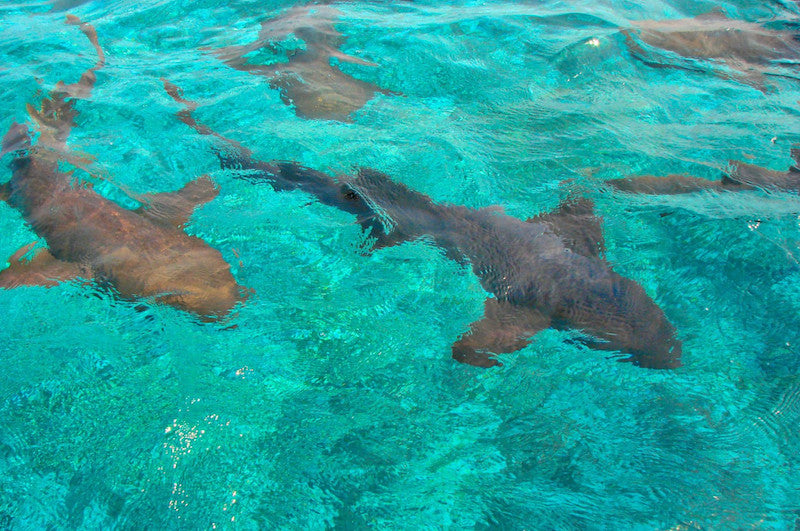
Sharks are among the various marine life that can be seen in Belize. Photo by eskystudio on stock.adobe.com
With over 400 islands and the longest barrier reef in the Western Hemisphere, Belize is an ideal destination for scuba divers.
Outlined by full-of-life coral reefs and inhabited by sharks, Belize's Great Blue Hole is best discovered by a liveaboard. This is one of the most unique diving spots in the Caribbean, as it is the world's biggest ocean sinkhole.
Divers can observe the one-of-the-kind rock formations and enjoy a serene dive down the hole. Different types of sharks can be seen here, including bull, hammerhead, nurse, and blacktip tigers.
Other great places for scuba diving in Belize are Half Moon Caye , Hol Chan Marine Reserve and Long Caye Wall . Half Moon Caye is a beautiful island with plenty of marine life to explore. Hol Chan Marine Reserve is a lovely area that is good for shallow dives and is snorkel-friendly.
If you are new to scuba diving and looking to dive recreationally, Koh Tao is an excellent place to start, with reasonably priced classes, plenty of dive shops and diving trips. Scuba diving in Thailand is widely loved due to its colourful reefs and warm waters.
Aside from the full-of-life coral reefs, other diving experiences that every scuba diver should try are wreck diving at popular sites such as the HTMS Chang , HTMS Khram , HTMS Sattakut and scenic drift diving in Turtle Rock , Koh Rok Nai , East of Eden and Koh Similan .

The panoramic view of Komodo National Park, a popular dive site in Indonesia. Photo by tanarch on stock.adobe.com
A biodiversity hotspot with over 17,000 islands, there are plenty of fun activities to do in Indonesia and beautiful diving places to visit. Indonesia is a spot frequently visited by experienced divers thanks to its high level of biodiversity and an impressive number of over 13,000 islands. Raja Ampat , Komodo National Park and Alor are voted among the best places to scuba dive in Indonesia by divers.
Cayman Islands
The Great Barrier Reef is one of the world's most famous reefs with over 2,300 kilometres long and is blessed with a wonderful collection of tropical marine life and coral. Scuba diving on Lord Howe Island is one of the most rewarding experiences for divers, with maximum visibility of around 30 metres.
Kangaroo Island is the third largest island in Australia that is famously known for its stunning coastline, clear waters and wonderful sea life such as the leafy sea dragon.
South Africa

Diving with sharks and other marine life is a unique experience. Photo by Pexels User on Pexels
For divers with a taste for adventure, diving in South Africa is a must-try experience. From big sharks to tiny sardines, from tropical reefs in the north to rocky reefs in the west, there are many rewarding experiences that South Africa has to offer.
Cape Town is a unique dive site as it is the cross point off the warm Agulhas currents and the cold Benguela currents. This made for a diverse underwater ecosystem with a great variety of marine life.
Cage diving with great white sharks is a recommended experience for shark enthusiasts. Port Elizabeth with their incredible reefs and colourful sea life is a diver's paradise. There are different wrecks for divers to explore in the area such as the famous Harlem.

The islands of Micronesia are an ideal place for both scuba divers and snorkelers. Photo by JAY PARK on Pixabay
The tropical islands in Micronesia are the home of vibrant coral reefs. Known as one of the top diving spots in the South Pacific, Micronesia is an ideal place for scuba divers with pristine waters and affordable costs.
Because of how remote the islands of Micronesia are, the area is a diver's paradise and snorkelers' dreamland. There is extraordinary marine life, colourful corals and epic wreck from World War II.
Chuuk is a natural wonder and a must-visit diving spot with beautiful hills covered by forest and rare flowers on land. Meanwhile, its underwater paradise is filled with vibrant coral reefs and a diverse world of dolphins, pelagic fish and rays.
CABINZERO's Tips For Divers
Logistics and flight booking.
Take transportation time into account. Choose your diving spots accordingly depending on how much time you have on your trip. For example, a 2-3 week vacation opens you up to more destinations while a long weekend getaway is only suitable for closer places.
Air travel can significantly shorten your travel time. However, it can be expensive at times. If you are planning to fly, start searching for flight routes early to track airfares and find the best flight rates.
Be Aware Of The Local Weather
Know what type of weather to be expected. There are many factors that affect how water moves during your dive such as temperature, wind, tides and water density. Research how the local weather is expected to be on your planned travel dates to choose the most suitable dive sites during the best time of the year. For example, avoid difficult diving conditions such as strong winds, heavy rain and large waves as they can be dangerous.
Bring Your Documents
Prepare travel documents required for your next diving spot in advance. Before planning to travel internationally, be sure to check your passport and its expiration date. Give yourself enough time to apply for passport renewal and tourist visas if necessary. Some countries require travellers to enter with travel insurance as well. Remember to bring your diver certification for booking dive trips and hiring equipment.
Safety Checks
Be sure to always check the safety of your equipment before diving. Diving equipment malfunctions are dangerous, however, they can be proactively avoided with pre-dive checking procedures. Aside from your diving equipment, checking your physical well-being is highly recommended.
Dive With An Instructor Or An Experienced Diver
There are a number of risks associated with every dive. Unless you are an experienced diver with certification, diving with another diver or an instructor is safer than diving alone. For example, emergency situations such as entanglement or running out of air can be life-threatening without the help of a dive buddy.
Join Dive Clubs And Diver Communities
You can meet new friends and like-minded divers by joining dive clubs and joining divers in your local or online communities. You can learn diving techniques and share personal experiences with fellow divers.
Practising diving skills together, travelling in groups to different diving sites and being inspired are among the perks of having friends as divers. PADI Club (https://www.padi.com) and online groups for divers on social media sites are great places to meet new dive buddies.

Explore the exciting world of scuba diving in a safe and enjoyable manner by knowing the scuba diving basics. Photo by FIRST online on Pixabay
1. How to research a dive site?
There is plenty of information available in both online sources and in guidebooks for scuba divers to look up. Online reviews by fellow divers and diver's groups are good sources to consider as well.
When choosing diving locations for your next trip, pay attention to the local weather , visibility , temperatures and the types of marine life that are available in the area. Know your diving experience and pick locations with an appropriate difficulty level .
2. Which is the most important factor when choosing diving places?
Safety should always be your most important factor to consider. By researching the local weather and choosing diving spots that match your diving experience, you can dive more comfortably and enjoy the experience with peace of mind. Remember that it is important to follow the proper guidelines and procedures . Always have a plan for emergencies and unexpected situations.
3. Which countries are the best for scuba diving?
Depending on the types of diving that you are looking for, the diving interests that excite you and your chosen time to travel, different diving sites will be considered as the best ones.
For example, the Maldives is a great diving location with crystal clear water, vibrant corals and diverse marine life. Exploring the Maldives’ tropical islands on land is also a fun-filled experience outside of diving time.
To meet the vulnerable sea turtles in their protected areas, a trip to the Great Barrier Reef in Australia or Ras Mohammed in Egypt is recommended. For seahorses and healthy soft coral reefs, Indonesia is your go-to as it is considered one of the best diving spots for marine diversity.
4. Which time of the year is the best for diving?
The ocean has such a dynamic environment with local weather and conditions constantly changing. The best time to dive within a day is usually in the early morning . However, depending on what you are looking for in a dive, you might consider diving at different times. Talking to local divers or researching online is highly recommended.
The best time to dive in a year varies depending on your chosen diving locations. Some diving spots, such as the Maldives, Hawaii, Bali and Palau, are great for year-round diving.
Other diving places are great for certain months such as South Africa (December to March) for an opportunity to dive with sharks, and Indonesia (May to September) for good weather conditions.
There is plenty of information available in both online sources and in guide books, be sure to do research on your chosen diving locations to select the best time for upcoming trips.
5. Where is the scuba diving capital of the world?
Key Largo in Florida, United States is regarded by divers as the scuba diving capital of the world for various reasons. First of all, a great number of dive sites are accessible to divers of all levels and experiences.
From shore diving to wreck diving, there are many dive experiences to choose from. Secondly, Key Largo is home to many popular dive locations such as the Carysfort Reef, the Elbow, the Benwood, the Molasses Reef, Christ of the Abyss, the Bibb and Duane.
6. What is the clearest water to scuba dive in?
Silfra in Iceland is a diving spot with the clearest water to scuba dive in. With visibility of over 100 metres (about 328 feets), the glacial water is crystal clear with absolute transparency. The melting water from Langjokull glacier is filtered through underground lava rocks of over 50 kilometres from 30 to 100 years before flowing into Silfra Fissure.
Choosing a good dive site and planning your travel time right can make your entire trip more enjoyable. From tropical paradises to underwater hidden gems, these are the best places to scuba dive in the world. Immerse yourself in the crystal clear waters and admire the full-of-life reefs. Meet the diverse marine life and spend some quality time in the great ocean. Where would you go for your next diving trip?
Leave a comment
Please note, comments must be approved before they are published
This site is protected by reCAPTCHA and the Google Privacy Policy and Terms of Service apply.
Shop your Backpacks Now

Classic Cabin Backpack 44L Gobi Sands

Classic Cabin Backpack 44L Miami Magenta

Classic Cabin Backpack 44L Aqua Lagoon

Classic Cabin Backpack 44L Sage Forest

Classic Cabin Backpack 36L Gobi Sands
You may also like.


IMAGES
VIDEO
COMMENTS
Here are 10 of the world's most significant World War Two sites, where visitors can delve into the history of the conflict. Image Credit: DeFacto / CC. 1. Bletchley Park. Bletchley Park is a country estate fifty miles north of London. In 1938 it was converted from a residential house into a British intelligence centre.
So for all the history buffs out there, here are 15 sites significant to the Second World War that, ranging from inspirational to overwhelming, are worth visiting in Europe: 15. Sachsenhausen Concentration Camp, Germany. This work camp just outside of Berlin is found about three km from the location of the first ever Nazi concentration camp ...
Normandy Beach - Normandy, France. Normandy Beach, where the infamous D-Day invasion took place, is easily one of the most significant World War II sites. The objective of the mission, known as Operation Neptune, was to open a second front opposite the Russians in the East to put more pressure on the Nazi German army.
Colleville-sur-Mer - France. You will be moved to see the 10,000 crosses and thankful to the soldiers who came from the other side of the world to fight with us for ideas of liberty and against the nazi dictatorship that threatened Europe. The American cemetery of Colleville-sur-Mer was offered to the USA.
Since the end of the Second World War the German government, the Bavarian state, and the Nuremberg city authorities have all grappled with the challenge of what to do about these remaining infrastructures from the Nazi past. Visit information: Address: Bayernstraße 110, 90478 Nürnberg, Germany. Hours: 9AM-6PM.
WHERE: Berlin, Germany. Close to the Brandenburg Gate, 2,711 concrete slabs of varying heights stand in an area of 19,000 square meters (204,500 square feet). This is a memorial dedicated to the ...
4. Caen Memorial Museum, Caen. Cross the Pegasus Bridge and head to the northern edge of the city of Caen to visit the Caen Memorial Museum. The recommended starting point for your visit leads down a dark spiraling walkway that details the lingering turmoil from World War I that led to World War II.
4. Site Of Hitler's Bunker. When visiting Berlin, the site of Hitler's bunker is a must-see.In the final days of the war in Europe, Adolf Hitler, his mistress Eva Braun, and members of the Nazi inner circle retreated to an underground bunker in Berlin. The former air raid shelter served as their final headquarters.
The Battle of Berlin: Road to victory in Europe. On May 7 th 1945, World War II ended in Europe with the unconditional surrender of Nazi Germany. Visit the Humboldthain Flak Tower, the last remaining anti-aircraft tower that was built to defend Berlin. Walk through the blocks of the impressive Holocaust Memorial and take a trip to Sachsenhausen ...
Hi, I'm Ashley! I'm a full-time travel writer, tour guide, and World War II historian based in Boston, MA who's traveled to 32 countries on 5 continents. I formed Destination: WWII from a desire to encourage and help travelers visit WWII sites around the world. Learn more.
Here are 10 historically significant WWII sites to see in Germany: 1. Vorbunker/Führerbunker -Berlin. Vorbunker and Führerbunker were once the places where Adolf Hitler took shelter and eventually lived. The elaborate underground concrete bunker complex was designed to be a temporary air-raid shelter for Hitler, his family and his guards.
Imperial War Museum. Even in a teeming metropolis like London, you can still see the scars of the war. On the Victoria & Albert Museum, for example, shrapnel from the Blitz took big bites out of the stone walls — the marks are carefully preserved and annotated with a plaque. But the inarguable highlight of any World War II-themed trip to ...
10. Hel. The Battle of Hel was one of the longest battles in Poland at the start of WWII. At Poland's naval site, construction was still being undertaken when war broke out. Germany attacked by air, and while 2,800 soldiers fought bravely to stave off the enemy, Poland capitulated just 20 days later.
Abbey of Montecassino. One of the most popular sites to visit is the reconstructed Abbey of Montecassino, the site of a famous World War II battle and one of Europe's oldest monasteries. Perched on a mountaintop between Rome and Naples, the Abbey has great views and is very interesting to explore. Allow at least a couple of hours to see everything.
5. Imperial War Museum. The Imperial War Museum is dedicated to exploring worldwide conflicts throughout history. The exhibitions in the London Imperial War Museum cover, amongst other things, different aspects of the First and Second World Wars including military history, the Holocaust, women's roles in the conflicts, wartime artwork and the ...
This was the ceremonial recognition of complete defeat and victory over Hilter's regime. The Museum Berlin-Karlshorst (formerly called the German Russian Museum) isn't so centrally located, but it's a significant place to visit for World War II history in Berlin. Location: Zwieseler Str. 4, 10318 Berlin.
10: Anhalter Bahnhof. A relatively hidden site, Anhalter Bahnhof is one of the best places to get up close to the ruins of Hitler's Third Reich. Constructed in 1841, Anhalter bahnhof was Berlin's largest and most opulent train station. With 44,000 passengers passing through the station each day.
Trafalgar Tours Limited is a proud member of The Travel Corporation family of companies. #SimplyTrafalgar. Travel House, Rue du Manoir St Peter Port, Guernsey, GY1 2JH. Book your battlefields tour with confidence. Free booking hold and flexible changes. Visit the world war front lines from Normandy to Dunkirk with Trafalgar.
Suggested Read: 6 Most Romantic Places In Central Europe For Couples. 4. Dachau Camp, Munich. Image Source. Dachau is a popular medieval town as well as a residential area in north-west zone of Munich that houses one of the memorable World War 2 sites in Europe of the Dachau Concentration Camp.
2. The Liberation Museum and the Ghetto of Rome. The Great Synagogue of Rome on the river Tiber. Every corner of Rome is a window on a different time o f history: the years of World War II left deep scars, both in the urban planning and in the soul of the Capital.
World War II sites around Narvik. One can find many sites and remnants of battles from World War II in Narvik and the surrounding area. At the Narvik War Museum, you can learn more about what took place during the dramatic days in 1940. The museum also offers experiences tailor-made for children.
10. Mudchute Farm nr Canary Wharf. Ok, so you might be wondering why there's a WW2 attraction in a random part of East London that's now a children's play area and city farm! Well, that's because it contains an anti aircraft gun that was used to protect the docklands area of London during the war years.
Yushukan Museum. Japanese military and war museum located within Yasukuni Shrine. Including a large collection of model battleships, tanks and kamikaze planes. Entrance fee is ¥800 ($7.25 USD) 3. Edo-Tokyo Museum. Mesmerizing elevated museum with a detailed section on Tokyo during World War II. 4. Yamato Museum.
Here are ten historic military sites across the USA that will fill you with pride for the country's military heritage. #1. Gettysburg National Military Park, Pennsylvania. The site of the Civil ...
Almost every country in the world participated in World War II.Most were neutral at the beginning, but only a relative few nations remained neutral to the end. The Second World War pitted two alliances against each other, the Axis powers and the Allied powers.It is estimated that 74 million people died, with estimates ranging from 40 million to 90 million dead (including Holocaust casualties).
The climate on Ross Island in Andaman is tropical, characterised by high temperatures, humidity, and significant rainfall all year round. The island experiences warm temperatures throughout the year, with average highs fluctuating between 25°C and 32°C (77°F to 90°F). The summer months from April to June are usually the hottest, sometimes ...
If you book a vacation rental, be skeptical if you get a last-minute change from the host. Make sure they cancel the original reservation. If you cancel it, you'll likely be charged additional ...
Yes, Flight Centre offers the ability to book last-minute vacations based on availability. However, it's always best to book in advance to secure your preferred dates and rates. ... For full terms and conditions visit please speak with a Flight Centre Travel Consultant. CPBC#2790, TICO#4671384, OPC#702971.
Following the vote, the new elected MPs will travel to London to meet in parliament for the first time on Tuesday, 9 July. The Speaker of the House of Commons will be elected and MPs will be sworn in.
The panoramic view of Komodo National Park, a popular dive site in Indonesia. Photo by tanarch on stock.adobe.com. A biodiversity hotspot with over 17,000 islands, there are plenty of fun activities to do in Indonesia and beautiful diving places to visit. Indonesia is a spot frequently visited by experienced divers thanks to its high level of biodiversity and an impressive number of over ...